

The Best Time to Visit Colombia: For Festivals, Hiking and Picture-Perfect Beaches
By Author Arakita Rimbayana
Posted on Last updated: 6th October 2023
One of the things that set Colombia apart from other destinations in South America is its diversity of landscape and wildlife.
From untouched Caribbean coastline to the emerald-green Andean summits, Colombia packs a vast array of flora and fauna spread across 314 different ecosystems and is ranked the second most biodiverse country in the world.
This mega biodiversity is thanks to the country’s unique terrain and climate, influenced by the warm waters of the Caribbean Sea in the north, the elevation changes brought about by the undulating Andes Mountains and its proximity to the equator.
While Colombia certainly could be considered a tropical country in many respects, the temperatures and weather systems can actually vary across the country, with the lower regions experiencing the tropical climate you might expect, while those at higher altitudes, such as Bogotá and Medellin, can feel chillier.
When it comes to choosing the best time to visit Colombia, it’s necessary to consider the conditions in the different parts of the country you plan to visit as well as seasonality.
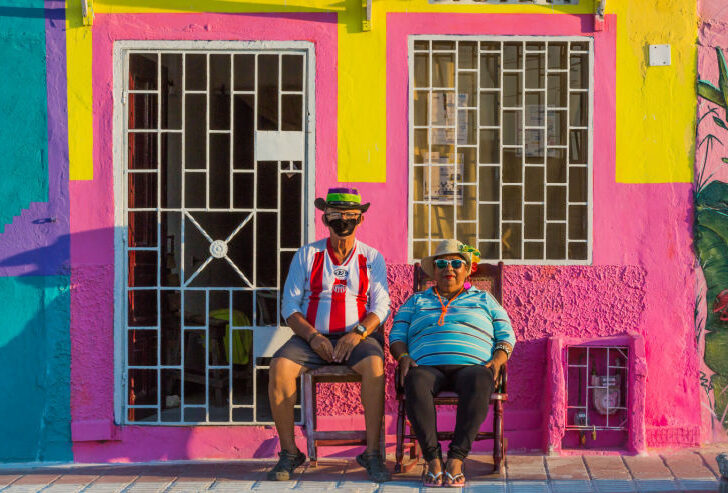
Because average temperatures in most parts remain much the same all year long, the high season for visitors to Colombia is influenced mainly by the Northern Hemisphere’s seasons, with visitors escaping the cold winter back home between December and March.
Want to escape the crowds and have the best chance of the perfect weather for hiking, wildlife spotting, or lounging on a white-sand beach? Read on for our expert advice about the best months to travel to Colombia.
Click to navigate this article:
The best months to visit Colombia
- January: Escape the peak season crowds in Cartagena by heading instead to Bogotá, which is deserted as Colombians make a beeline for the coast over the Christmas holidays. Alternatively, take a trip to Eje Cafetero (Coffee Axis) from Medellín to sample some of the country’s finest cups of joe or head out west to the Pacific Coast for wildlife watching and surfing while the weather’s dry.
- February: This month is best for outdoor activities on the Caribbean coast, while the Barranquilla Carnival takes place before Ash Wednesday. For hikers, head out into the national parks across the Andes for sunny, settled weather.
- March: As the dry weather along the Caribbean coast continues, go trekking in Sierra Nevada mountains to reach the UNESCO World Heritage archaeological site, Ciudad Perdida, one of the best places to visit in Colombia . Alternatively, spend time exploring the capital, Bogotá while the weather’s warm.
- April: Celebrate Semana Santa with the locals in the country’s largest celebrations, which are held in Popayán, in southern Colombia. Alternatively, maximise your time beach bumming in Cartagena de Indias during shoulder season before the rainy season begins or head over to the gorgeous Caribbean islands of San Andrés and Providencia.
- May: The wettest month in Colombia is the best time to avoid crowds – although you’ll definitely need a raincoat. Avoid the Amazon region and instead head to Calí for salsa dancing.
- June: As the rain slows, but the rivers are still easily accessed by boats, head deep into the Amazon jungles to spot parakeets, toucans, and pink river dolphins.
- July: Take advantage of the “dry” period in Antioquía to visit Jardín, Colombia’s most atmospheric colonial town or spend a few days kicking back in Medellin, the “City of Eternal Spring”.
- August: Join the paisas (residents of the Antioquia department) to celebrate Feria de Las Flores for ten consecutive days in August.
- September: Visit parks in the Amazon region, such as Amacayacu National Park; during this drier month, you can hike and trek through the rainforest rather than explore by boat.
- October: The wettest month in most parts of Colombia, October is the time to explore indoor activities in the capital city. Discover Bogotá through its museums, galleries, and glut of excellent restaurants .
- November: While much of the rest of the country is at the mercy of the weather, the La Guajira peninsula in the northeast of Colombia is still hot and dry – and its remote location makes it a great place to avoid the crowd regardless of the season.
- December: Soak up the sun on the beaches of Cartagena, Barranquilla, and Tayrona National Park (Parque Nacional Natural Tayrona). Alternatively, hit up Medellin for sunny weather or head to Calí to celebrate one of the biggest festivals in Colombia, the Feria de Calí.
The best weather conditions by region
Located in the northwest corner of South America, Colombia is bordered by the Caribbean Sea to the north and the Pacific Ocean to the west. As a result, the climate varies significantly by its natural regions: the Caribbean, Pacific, Amazon, Orinoquia, and Andean Regions.
Colombia generally has a temperate and tropical climate, where more than 80% of its area is considered hot due to its proximity to the equator. However, each natural region has its own conditions.
The Amazon: Leticia, Puerto Nariño and Putumayo
The Amazon region of Colombia is hot and humid year-round, with an average temperature of 27°C (81°F).
The rainy season falls from December through May, with the heaviest rainfall occurring in April and May; this season sees most of the forest submerged by growing rivers, which gives you more chance to spot birds, monkeys, and other animals that spend their time in the treetops.
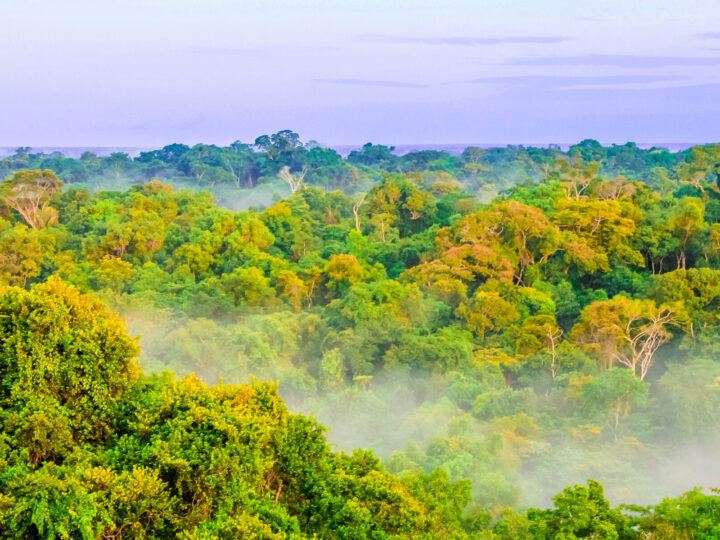
Between the dry months of June and September, conditions are better for hiking forest trails and spotting terrestrial animals.
The best time to explore the Amazon: June through September
Despite the hot and humid conditions, the Amazon Rainforest can still be explored between June and September.
With the help of binoculars and a guide, patient observers can spot parakeets, cormorants, and toucans in the foliage. Moreover, you may get to see the pink river dolphins that live in Amazonian waters.
Even though June to September is technically the dry season, there’s still around a 50% probability of precipitation. So it’s best to wear light, breathable clothing and pack a raincoat just in case.
It’s also advisable to bring insect repellent to protect against mosquitoes and insects; mosquito-proof clothing will also be a godsend.
The Caribbean Coast: Cartagena, Barranquilla, Santa Marta and Tayrona National Natural Park
Not only does Colombia’s Caribbean coast have dazzling beaches, but its warm tropical climate promises year-round sunshine.
The average temperature ranges from 25°C (77°F) to 32°C (89.6°F), and the closer you are to the coast, the hotter it feels and the higher the humidity.
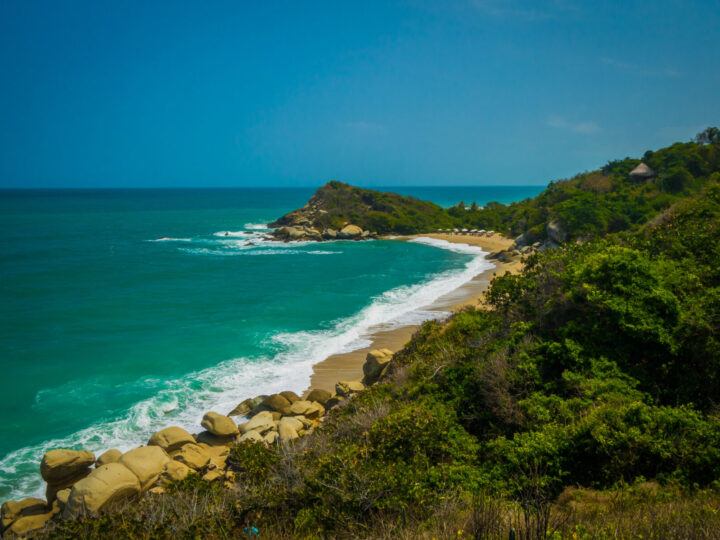
The rainy season typically runs from May to November, with heavy downpours in the afternoons and evenings. But don’t let this deter you.
Rain usually only lasts a few hours, often bringing a welcome break from the heat. Just be sure to bring a rain jacket or umbrella to stay dry when sightseeing and hiking.
However, if you plan on snorkeling, diving, surfing, and exploring the beaches, it’s best to visit during the dry season from December to March.
The best time to explore the Caribbean Coast: December through March
During these months, you can expect blazing sunshine and few – if any – rainy days. Although temperature-wise, there’s no significant difference between the dry and wet seasons along this stretch of Colombia, in January and February, you may not see rain at all.
As a result, these months are perfect for lounging on the beach, getting under the skin of Cartagena , or taking a day tour out to one of the islands surrounding the city .
Bear in mind that this is the high season for travel and the beaches along the Caribbean Coast are guaranteed to be packed with both local and foreign tourists, while the best hotels in Cartagena are likely to be fully booked.
For quieter beaches and fewer visitors in the region’s landmark national park, Parque Nacional Natural Tayrona, consider the shoulder seasons of November and March, particularly as the park closes for the first half of February.
The Andes: Medellín, Manizales, Bogotá, Bucaramanga and Calí
The Colombian Andes is one of the most diverse mountainous regions in the world when it comes to climate.
The average temperature is around 18°C (64°F), but it’s highly influenced by altitude and latitude and the region is divided into three branches (cordilleras) as a result of these two factors.

The Cordillera Occidental, which is adjacent to the Pacific coast, is the lowest of the three. This branch includes Calí, where average temperatures hover around 24°C (75.2°F) year-round, and where two rainy periods – March through May and October through November – are experienced.
The locals refer to the other months as the “dry” season, however, rain may fall on any day, so it’s best to pack waterproof clothing or an umbrella.
The Cordillera Oriental, the second highest branch and the widest include Bucaramanga and Bogotá. The capital city sits at 2,640 meters (8,660 ft) above sea level, which makes its weather different from most cities in this branch.
Sunny days are rare, as fog fills the air every morning and is replaced with clouds in the afternoon. As a result, it can be quite cold in Bogotá, with an average temperature of just 14°C (57.2°F) and temperatures dropping to as low as 0°C (32°F) at night.
Expect rain – or at least drizzle – throughout the year, although December and January are often drier.
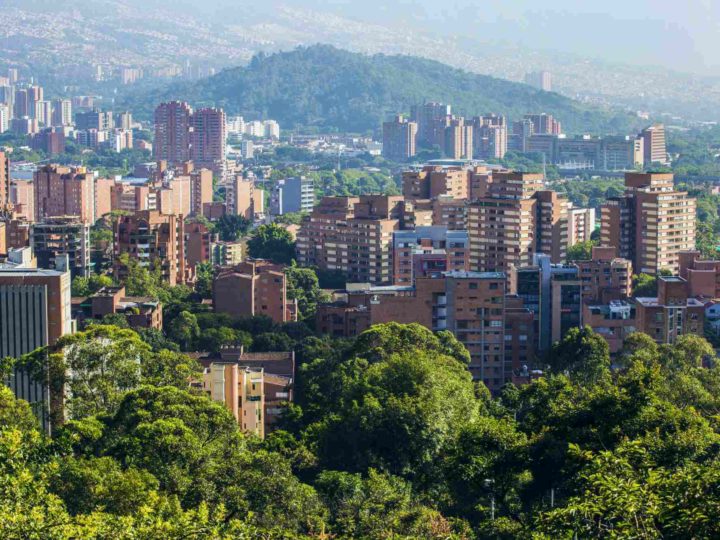
The Cordillera Central is the highest branch, with Nevado del Huila its loftiest peak at 5,364 metres (17,598 ft) and includes Manizales and Medellín. The latter sits at 1,500 metres (4,900 ft) with an average annual temperature of 22°C (72°F), which is the reason behind its nickname the “City of the Eternal Spring”.
This branch has more rainy days than the other two: on average, 19 days per month, with the most rainfall between April and May and September through November.
The best time to visit the Andes: December through January
In general, the Andean region is a year-round destination. But if you want to avoid the rain, aim for December and January, when Colombians flock to the coast. Though the days are not entirely rain-free, these months are the “driest” in this part of Colombia.
In Calí and most of the Cordillera Occidental, these months are the “summer” and temperatures can hit 34°C (93.2°F) during the day and drop to 15°C (59°F) at night.
Bogotá, and most other cities in the Cordillera Oriental, enjoy more sunshine hours during these months. Medellín, in the Cordillera Central, maintains its pleasantly warm climate with less rain than other times during the year.
The Pacific Coast
With its warm, tropical climate and diverse weather patterns, the Pacific region is one of the wettest places in the world.
As it rains almost constantly here, this region is popular for its surfing and ample wildlife, with the ocean packed full of humpback whales between July and October, and hawksbill turtles laying eggs at Bahía Solano from September through December.
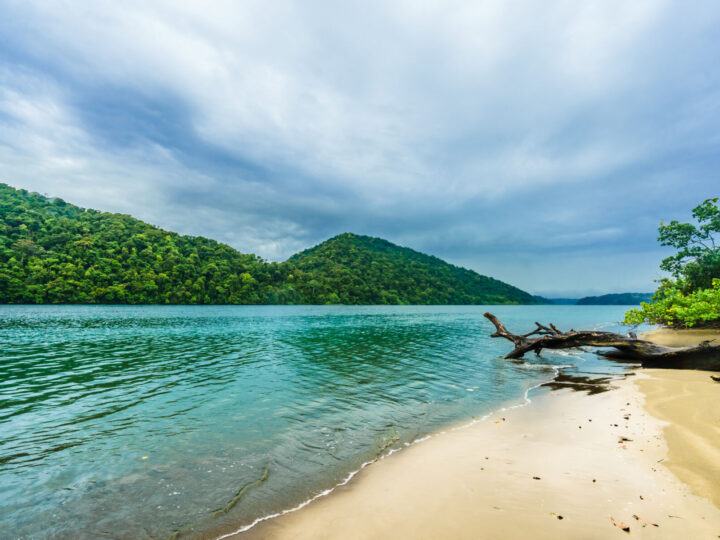
Like most areas in Colombia, the Pacific region has its driest days in December through January, while the temperature stays pretty constantly between 25°C (77°F) and 32°C (90°F) throughout the year.
Los Llanos Orientales
While avoiding the wet season in the Pacific region is advisable, it is a must in the Los Llanos Orientales region, a stretch of savannah that belongs to the Orinoco River watershed and which floods during the rainy season. Throughout the years, temperatures mostly remain stable between 22°C (72°F) and 33°C (92°F).
Known for its remarkable diversity of wildlife (it’s home to over 100 species of mammals and 700 species of birds), the eastern plains become an even great refuge for birdlife during the rainy season.
Between May and September, large parts of these grasslands convert into wetlands, attracting migrating water birds and making them the perfect place for kayaking.
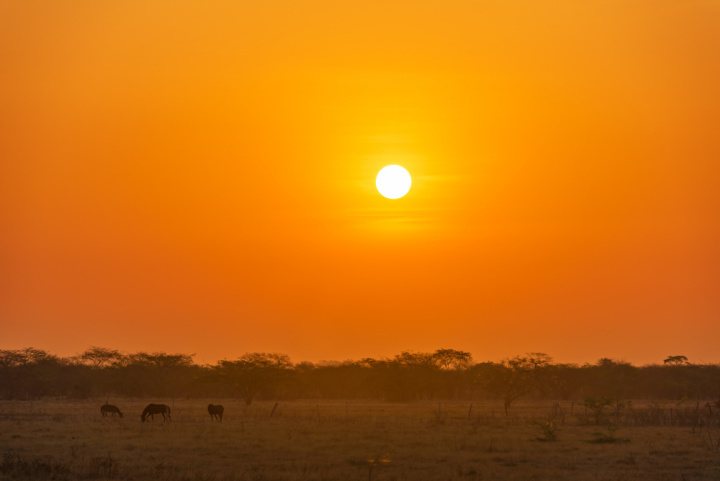
For a better chance of spotting wildlife such as capybaras and monkeys, visit between November and April when the waters recede, which is also a brilliant chance to learn about the region’s cowboy culture.
From July to November is also the best time to see the curious pink algae bloom in the Caño Cristales, a river tucked into Serranía de La Macarena National Park in the southwest of the region.
The best time to avoid crowds in Colombia
Since most visitors come to Colombia to avoid winter in the Northern Hemisphere, the peak season for travel in Colombia is usually between December and March, when the weather is at its driest, and when city-dwellers head to the Caribbean Coast to soak up the summer’s sunshine.
June through August is also often crowded with local tourists when students are out of school for their summer vacation.
During these months, expect more tourists, longer lines at popular attractions, and higher prices for accommodations and activities.
In the shoulder seasons, you’ll also experience tourism peaks during special events and festivals. With that said, if you don’t mind crowds and are looking to experience unique and authentic interactions with local people and Colombian culture, this can be a great time of year to visit.
The most famous festivals in Colombia
January (2nd to 9th of January): Blacks and Whites Carnival
- This six-day carnival celebrates Afro-Colombian and indigenous cultures and the concept of unity. It is known for its colourful and vibrant parades, which feature traditional music, dance, and costumes.
February (before Ash Wednesday): Barranquilla Carnival
- One of the largest carnivals in the world, Barranquilla Carnival celebrates the upcoming fasting season of Lent. Eat, drink, and dance with the locals for four days straight to live up to the festival’s slogan: “ Quien lo vive, es quien lo goza! ” – those who live are those who enjoy!
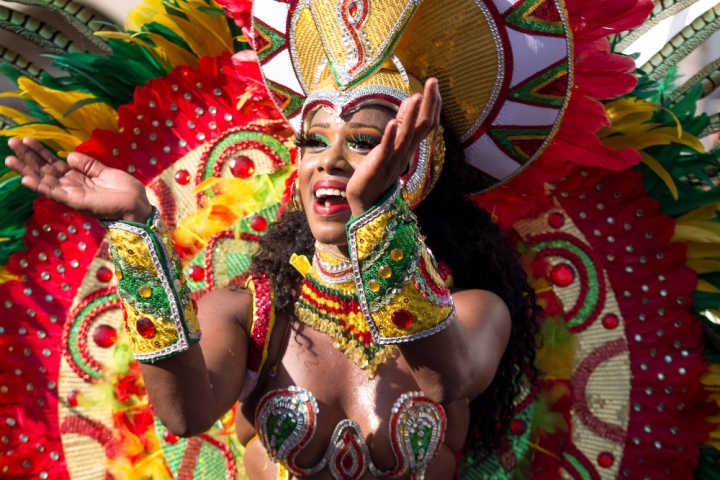
April (one week before Easter): Semana Santa
- For one week, the whole country celebrates its second most important religious holiday: Easter. Each city has its own unique traditions, but the one that attracts the most is Popayán, a town in the southwest of Colombia. Added in 2009 to UNESCO’s list of Intangible Cultural Heritage of Humanity, Popayán’s Holy Week processions involve a two-kilometer parade of flower-decked statues and floats.
August (first week): Feria de las Flores
- The Feria de las Flores is a 10-day annual event held in Medellín that celebrates the city’s rich flower-growing tradition. The main event during the festival is the Desfile de Silleteros, which features people dressed in traditional attire carrying large baskets of flowers on their backs.
December (last week of the month): Feria de Calí
- An event celebrating the city’s cultural identity, the Feria de Calí lasts for five days and includes a Salsa marathon, dance parties and parades, and a variety of food and craft stalls across the city where you can sample traditional Colombian cuisine and purchase locally made products.
Tips for attending festivals in Colombia
- Book accommodation close to the festival location. This will give you easy access to events and avoid spending too much time stuck in traffic in Colombia’s infamously congested cities.
- Pack light. A small backpack or crossbody bag with essentials like water, sunscreen, and a power bank is sufficient.
- Wear comfortable clothes and shoes. Festivals can be long and involve a lot of standing or dancing. Avoid wearing anything too heavy or constricting, and consider bringing a hat or sunglasses to protect yourself from the sun.
- Stay hydrated, especially when it’s hot and humid.
- Bring cash. Most food and drink vendors and stalls only take cash.
- Protect your belongings. Keep your valuables close to you, and consider using a wrist wallet or money belt to keep your cash and cards safe.
Conclusion: the best time to visit Colombia
To avoid crowds while enjoying lower prices, we recommend visiting Colombia during the low season, which is between April and May or September and October.
The catch is these months are usually the wettest in most areas; so if you want to explore Colombia’s incredible national parks, you’ve got little choice than to visit during the dry months (December through March and July and August).
If you plan on visiting more than one region, you’ll find our one- and two-week Colombia itinerary an essential guide for your trip.
Change location
- UK / International
- Call toll-free from 10am EDT 617-223-4521 617-223-4985 or
- REQUEST A QUOTE
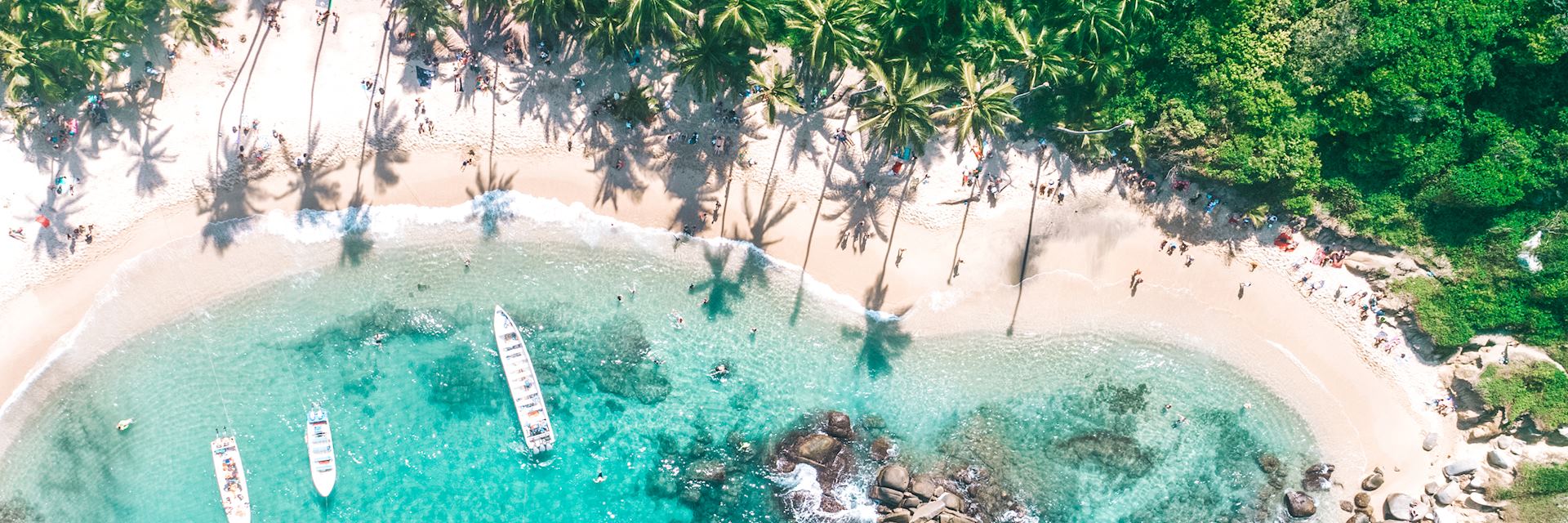
When is the best time to visit Colombia?
- Tayrona National Park
- Month-by-month
The best time to visit Colombia depends on which area you travel to. Weather variations are determined more by region than clearly defined seasons.
The main differences of note are in the highlands, where nights become chilly at higher altitudes.
Meanwhile, the lowlands enjoy a tropical climate year-round, with little temperature variation. More frequent rain showers will be noticeable in the wetter months of April to June, and again in October and November.
Overall, Colombia is a year-round destination, particularly along the Caribbean coast and in Medellín. Here, warm, dry weather is prevalent for almost the entire year.
- Make an inquiry
- Request a brochure
Month-by-month guide for traveling in Colombia
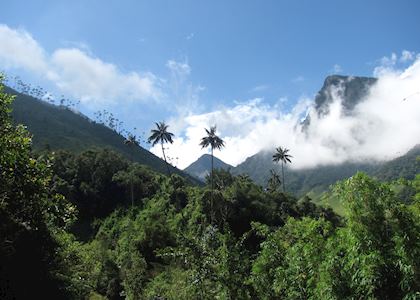
Visiting Colombia in December - March
Colombia’s high season sees plenty of sunny days; ideal for exploring the country’s charming towns and cities, the coffee district, and relaxing on the beach. Early planning is crucial for December and January, which see a huge influx of domestic holidaymakers and international visitors.
Events & Festivals
- Festival of Lights (early December): Around the feast of the Immaculate Conception, Villa de Leyva marks the event with a small festival of light, where balconies and terraces are lit by candles and lanterns.
- Hay Literary Festival (January): With its four-day program usually filled with plenty of events and readings, this festival stages a partner event in Cartagena.

Visiting Colombia in April - June
The start of the rainy season brings slightly wetter weather in some places, but persistent rainfall is very unusual. You should plan ahead if you wish to visit over Easter as this is a popular time for regional tourism.

Visiting Colombia in July - August
In many areas a mini dry season returns to the country, bringing wonderful conditions once again for visiting Colombia’s cultural highlights, beautiful countryside, jungles and beaches. Some airlines will increase their fares in line with European and North American vacation periods.
- Medellín Flower Festival (August): This annual flower festival exhibits truly astonishing flower displays as well as live music and other festivities on the streets of Medellín.
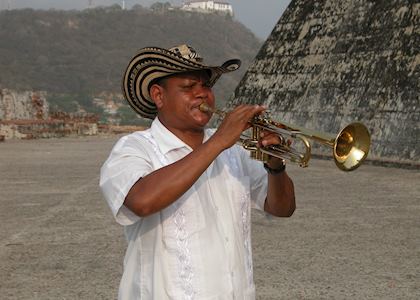
Visiting Colombia in September - November
This is the low season in Colombia, but due to the country’s unique geographical position visitors to many of the main attractions will not find their travel hindered by prolonged periods of rain. Long spells of dry weather can still be enjoyed, and many take advantage of off-peak travel to get a wider choice of hotels and lower rates than in the months to follow.
- Independence Day of Cartagena (November 11): Visitors to Cartagena on this day can enjoy colorful parades, music and dance.
Colombia Climate Guide
Why travel with audley.
- 100% tailor-made tours
- Fully protected travel
- Established for over 25 years
- 98% of our clients would recommend us

Travel advice
Practical tips for traveling to Colombia, from social protocols to guidance on money matters, with a link to the latest US State Department travel advice.

Request our brochure
Covering all seven continents, The World Your Way shows you how you can see the world with us. It features trip ideas from our specialists alongside hand-picked stays and experiences, and introduces our approach to creating meaningful travel experiences.
Trip ideas and travel guides for exploring Colombia

Simply Colombia: Bogotá, coffee region & Cartagena
9 days from $5,115pp
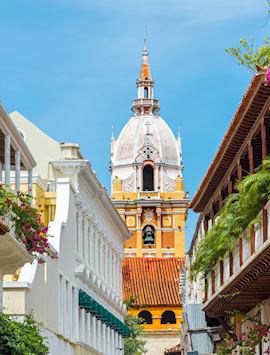
Classic Colombia tour
14 days from $7,700pp

Highlights of Colombia, Ecuador & Galapagos
14 days from $13,100pp

What to do in Colombia: our highlights guide
11 min read
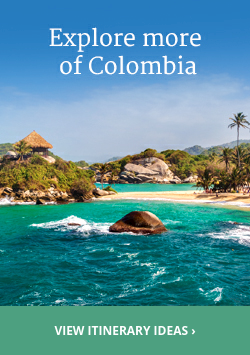
The Best Times to Visit Colombia

From tropical Amazon jungle to Caribbean beaches, the Andean Mountains and the world's largest bird population (almost 2,000), it's time you visited Colombia , the second-most biodiverse country on the planet after Brazil. Tucked into the northwest corner of South America, its warm and friendly people are more than ready for visitors after its 52-year civil war officially ended in 2016, meaning it is now safe and welcoming to travelers.
TPG himself, Brian Kelly, just visited Colombia, as documented on his new vlog series, Being The Points Guy.
The three major hubs are the Andean capital of Bogotá; Medellín, surrounded by coffee country; and Cartagena de Indias, a beautiful colonial city that fuses laidback Caribbean vibes with a curious array of high-rise contemporary architecture. Colombia's mixed heritage, which includes European, Afro-Colombian and indigenous influences, means you could easily be visiting cities in three different countries.
The Best Times to Visit Colombian Cities
The best times to visit cartagena.

While most of Colombia is located in the northern hemisphere, it doesn't necessarily mean that seasons apply. Sitting on the Caribbean Sea, Cartagena de Indias' weather is hot and very humid all year, with an average temperature of 82 degrees Fahrenheit. "Dry season, December through April, is high season. And it gets particularly sticky between June and September, which is when many locals escape and the city is a lot quieter," guide Kristy Ellis of Cartagena Connections told The Points Guy. Given that Cartagena is a prime cruise-ship stop-off, expect to find the beautiful, colonial old town to be bustling with visitors at any given moment. The good news is that you're not competing with cruise-ship passengers for hotel rooms.
The Best Times to Visit Bogotá

At around 8,660 feet above sea level, the city of Bogotá can experience a few weather fronts in a single day; its average, year-round, top temperature is 66 degrees Fahrenheit. It cools down to 48 degrees come nightfall, so always go out with a coat. And, while the mountainous city is prone to frequent showers, the least rainy period is between January and March. Given the altitude, accept coca leaf tea when offered, which can help keep altitude sickness at bay.
The Best Times to Visit Medellín

Known as the "City of Eternal Spring" for its mild, year-round temperatures, the peak season in Medellín (whose leafy streets are buoyed by the chubby works of sculptor Fernando Botero) is also between January and March — and when flights and hotel room prices soar. December is low season, though Christmas light excitement might indicate otherwise.
When to Visit Colombia for Events
Every January, Cartagena hosts the Hay Festival, which specializes in literature, a fitting tribute to Nobel prize-winning author Gabriel García Márquez, the famous Colombian son who made the coastal city his home. In the days before Easter, don feathers and an abundance of glitter for the fabulously flamboyant four-day Barranquilla Carnival, a 90-minute drive from Cartagena, which gives Rio a run for its money.

Colombia's floral home, every August, Medellín hosts the seven-day Flower Festival, where cultivators parade their petaled beauties through the streets. Should you be visiting over the Christmas vacation, the seasonal lights are a sight for sore eyes.

Culture vultures should make a beeline to the capital in late March for the biannual Ibero-American Theater Festival . The world's largest of its kind, more than 900 productions are shown over the two-week duration. Bogotá is also known for its music fests (Rock in the Park, for example, takes place in Parque Simón Bolívar every summer) and its own Carnival, when revelers dancing to salsa and cumbia rhythms fill its streets.

The Best Times to See Wildlife in Colombia
The best time to see turtles.
Turtles head to Bahía Solano on the Pacific Coast to lay eggs September through December, a wonderful close-up of nature that takes places during evenings.
The Best Time to See Birds
Any time is a fantastic opportunity for spotters to spy on some of Colombia's 1,920 bird species, which includes 160 types of hummingbird: 73 of those are considered endemic. Other avi-fauna draws include the Andean cock-of-the-rock, which makes cloud forests its home, and the Amazon-dwelling green-backed trogon.
The Best Time to See Whales
Humpback whales travel 5,500 miles to take up residency off Colombia's Pacific coastline July through December, to mate and calf. It's a wonderful destination for enthusiastic whale watchers .
The Cheapest Times to Visit Colombia
Depending on where you are traveling to in Colombia, flights are usually priciest during peak season. If you need to keep an eye on your budget, wait for off-peak season, which varies between cities and regions.

Easter is a prime vacation time for Colombians, with many taking the entire week off, spelling a brief high season all over the country.
Affordable Airfare
As Cartagena is a tourist magnet all year, it might be cheaper to fly a major airline such as Avianca, Copa (both part of the Star Alliance), or LATAM (part of the OneWorld alliance) to Bogotá, then connect to Cartagena or Medellín with a budget airline such as Viva . The US legacy carriers all have flights to Bogotá, too.
Affordable Hotels
A favorite destination for backpackers as well as cruise-ship passengers, Cartagena offers an array of accommodation to suit all budgets, starting with $5-a-night hammocks on Isla Barú, a 90-minute boat ride, for a legit Robinson Crusoe experience. There's also an array of affordable hostels and hotels in the hip Getsemani neighborhood. While Zona Rosa is the heart and soul of Bogotá's nightlife scene, stay in La Candelaría, the capital's colonial gem of a district, for a variety of budget hotels. As for Medellín, El Poblado neighborhood is the best place to pitch up, thanks to its lively nightlife scene and assortment of accommodation.
- Best time to visit Colombia
Book your individual trip , stress-free with local travel experts
- roughguides.com
- South America
- Travel guide
- Itineraries
- Local Experts
- Travel Advice
- Accommodation
Plan your tailor-made trip with a local expert
Book securely with money-back guarantee
Travel stress-free with local assistance and 24/7 support
This is the first time we have used this service (or any company) to organize our travels for us and we would happily use them again. The pre-trip process ...
Colombia’s proximity to the equator keeps regional temperatures stable throughout the year, around 24°C (75°F) along the coast and 7–17°C (45–63°F) as you move higher inland. However, rainfall does vary with the seasons. In the Andean region there are two dry and two wet seasons per year, and the driest months, being from December to March and July to August. In low-lying areas, especially southern Colombia, rainfall is more constant but showers never last very long. The Amazon climate is uniformly wet the entire year. When thinking about the best time to visit Colombia, it's worth bearing in mind that the most intense tourist seasons , with the highest prices, are from December to February and Semana Santa (Easter Week), the week before Easter.
Tailor-made travel itineraries for Colombia, created by local experts

7 days / from 1284 USD
Unforgettable Colombia
Spend your first days in Colombia exploring its capital city Bogotá before heading further to the coast: Cartagena and Santa Marta will be next on the agenda. From wandering the historic city center to hiking the jungles to a virgin beach, Colombia will be an unforgettable trip!

18 days / from 3664 USD
Colombia: music & arts explored
If you are a lover of the arts than look no further. This trip will bring you culture, art, architecture, music and dance: visit local markets and workshops, admire the graffiti in Bogotá, discover historical city centers and “Fondas” – local bars with exotic decoration and typical Colombian music.

10 days / from 4650 USD
Colombia for nature & adventure lovers
Do you like adventure and nature? Then you're in luck, this trip combines the best of both. Go horse riding through the Risaralda valley and join a bike tour through Cartagena, visit the beautiful Cocora Valley and discover the Coffee Cultural Landscape. There's something for everyone!
The Rough Guides to Colombia and related travel guides
In-depth, easy-to-use travel guides filled with expert advice.

Travel advice for Colombia
From travel safety to visa requirements, discover the best tips for traveling to Colombia
- Eating and drinking in Colombia
- Getting around Colombia: Transportation Tips
- How to get to Colombia
- Travel Tips Colombia for planning and on the go
- Weather in Medellin in April
- Weather in Medellín in March
- Weather in Colombia in January
- Weather in Colombia in February
- Weather in Colombia in April
- Weather in Colombia in July
- Weather in Colombia in August
- Weather in Colombia in September
- Weather in Colombia in October
- Weather in Colombia in November
- Weather in Colombia in December
Find even more inspiration here

- Travel Tips
written by Rough Guides Editors
updated 26.04.2021
Ready to travel and discover Colombia?
Get support from our local experts for stress-free planning & worry-free travels.
- Where to stay
- Travel advice
Spark Nomad

When Is The Best Time To Visit Colombia? – Your 2024 Guide
Are you eager to travel again? Possibly in a South American country where scenic views and exciting activities meet a vibrant culture and bustling nightlife? We’re here to guide you with that! Read on to know when is the best time to visit Colombia.
The post-Covid travel landscape is constantly evolving, and tourism once again seems to be picking up pace. Colombia is one of the travel destinations with great tourism potential with its rich culture and diverse landscapes.
If you plan to visit Colombia, you won’t get enough of its scenic jungles, exquisite beaches, pristine water, and vibrant city life. However, like any other traveler, you may be wondering what the best time to visit Colombia is.
This article provides guidelines that will help you decide when to book that plane ticket and pack your bags. Without any further ado, let’s get started!
Table of Contents
Best Time To Visit Colombia Month by Month
When would be the best time to visit Colombia? You need to consider multiple factors before making your decision. While it depends on when you can take the time to step back and get away for a few days, you would also want to make the most out of your trip.
There are many aspects to consider including which climate you prefer, the activities you want to do, the places you want to visit, or any specific festivals you want to attend.
Let’s break it down month by month to help you decide which time of the year would suit you the most. But before we get started, let’s look at what kind of climate Colombia has during the year.
Climate in Colombia
Colombia has diverse geographic landscapes and a mix of beaches, forests, and deserts, so you can expect to experience a change in temperatures in different parts of the country. You may think that the country has a higher temperature, considering it is generally closer to the equator, but the climate usually remains tropical with a few seasonal variations.
The country is divided into five regions: the Amazon, the Andes, Los Llanos, and the Pacific and Caribbean coasts. The Amazon and the Pacific coast generally have high temperatures with a humid climate. Los Llanos, like the Caribbean, has low humidity but a warm temperature, while you can expect to experience pleasant spring-like weather in the Andes.
The best time to visit Colombia would depend on which region you are interested in.
Visiting Colombia in Spring: March, April, and May
The months of March until May are what they call the rainy season in Colombia. It can be considered a good time to visit Colombia; given that there will be fewer tourists around, it would be quieter and less crowded.
It will start up with little rain in March, increase through April, and will be at its peak in May.
Activities
You might not be able to go trekking during downpours, so you may have to plan accordingly if this activity is something you want to do.
On the plus side, spring is less windy compared to other months, so you may be able to have enjoyable boat trips, specifically on the Caribbean side, as the pleasant tides are quite suitable for boating. It is also a good time for surfing along the Pacific coast.
May is another story, as there will be frequent rains, especially if you visit regions like Bogota, Cali, and Medellin. But you can visit places like Guatape or Cartagena where only fewer tourists are around.
Additionally, if you want to avoid the rainy weather, consider visiting San Andrés and Providencia during May. The Pacific coast is ideal this month if you are also interested in fishing.
The end of March marks the beginning of the Holy Week . As a tourist, this means there will be many cheaper accommodations since most locals are on vacation. If you want to experience the religious activities during the Holy Week, Jericho and Popayan are the places to be.
You can also visit Acandi in Capurgana to see the leatherback turtles lay eggs in March and April.
If you’re a fan of movies, you can check out Festival International de Cine, held in Cartagena in March. It showcases numerous Latin American movies to the spectators and juries.
For those who want to experience the music scene, consider the Festival Nacional de la música Colombiana in Ibague if you are there in March. In April, you can also check out the Vallenato Festival, a popular music festival if you visit the Caribbean coast.
We also recommend checking out the Baum Festival if you are in Bogota in May. You will have fun partying with the DJs in the famous discotheque.
Visiting Colombia in Summer: June, July, and August
While it is quite sunny during July and August, there is occasional rain during June. If you scheduled your visit in June but want to avoid the rain, staying on the Caribbean side is better.
The Caribbean coast is a good place to be in June if you do not want rain; however, it can get very crowded as tourists begin coming in. As more tourists enter the country, the rush increases, so if you are opposed to crowded places, steer clear of that area.
You can go diving in places like Rosario Islands , Capurgana, or Rincon del Mar. If you are the adventurous kind, consider kayaking through the Amazon. Since the Caribbean coast gets crowded in July, consider staying on the Pacific coast and visiting beautiful places like Guachalito.

You can view the turtles laying eggs on the Pacific coast or see the humpback whales give birth. You can also consider taking boat tours on the water.
Suppose you are traveling in July or the subsequent months. In that case, you cannot miss visiting the Caño Cristales, a beautiful river in the Serranía de la Macarena national park, located in the province of Meta in Colombia. The beautiful river, touted as the “liquid rainbow”, is nothing less than a natural wonder; you won’t regret one second of the time you are there.
July also marks the opening of Rock al Parque. It is a three-day rock music festival in the Simon Bolivar Park in Bogota.
If you visit in August and arrive in Medellin, you will enjoy the Feria de la Flores, a beautiful ten-day festival full of colorful flower parades. Another festival is the Festival del Viento y las Cometas , a kite festival in Villa de Leyva , a small heritage town in Colombia.
Visiting Colombia in Autumn: September, October, and November
September marks the return of the rainy seasons, with occasional rains during the afternoon. The frequency of the rain increases as we enter October, while November is when Colombia receives the most rain. Therefore, if you visit during these times, stay on the Caribbean side of the country and away from the Pacific coast regions.
As rain increases, the number of tourists begins to decrease so you will enjoy visiting places that are otherwise very crowded like Guatape, Cartagena or Tayrona .
You can visit the beautiful Caño Cristales or go backpacking through the Tayrona National Park. The beauty of the Sierra Nevada Mountains is bound to mesmerize you.
You may also enjoy the beautiful deserts in the Cabo de la Vela . Similarly, if you are traveling in October, you may enjoy visiting Bogota for swimming and the waterfalls . The Amazon rainforests are beautiful during this time of the year. A tour of the Canyon may also be on the cards.
If you plan to visit in November, you will be pleasantly surprised by the low airfares and reduced hotel prices as it is not, particularly, a tourist season. Cali and Medellin are perfect for touring in November. You may also enjoy visiting the village of Guatape .
In September, if you are in Cali, you may enjoy visiting the Festival Petronio Alvarez , a cultural festival with delicious food and music. Similarly, Bogota has free jazz concerts, while San Andres hosts the Festival de la Luna Verde, a cultural festival highlighting Creole heritage.
In October, the free jazz concerts are replaced by hip-hop concerts in the parks. Another festival to look out for is the Tatacoa Festival in the Tatacoa desert. The Caño Cristales closes in November, so consider visiting before it does if that is on your plan.
Visiting Colombia in Winter: December, January, and February
As we head towards the year-end, rains cease, and the sunny days return. The Caribbean coast tends to get windy as January approaches, with a little heat during daytime if you are out and about. February features mostly sunny days, a time when many sun lovers venture out to the beaches on the Caribbean coast.
Many regions, like Cali, Bogota, and Medellin, put up festive displays during the Christmas and New Year holidays. However, famous tourist spots can be quite crowded, so you may want to stay away from such places.
If you want to steer clear of the crowds, stay on the Pacific side, where you will find numerous activities to do in Cali and Pasto.
February is a good time to enjoy the sun if you are on the Caribbean side. You can go for water-based activities or hike in the Los Nevados.

If you happen to visit in December, Villa de Leyva puts up a beautiful fire show at the beginning of the month. Similarly, while Cali’s Christmas lights are a major reason to visit, its salsa festival Feria de Cali is another reason to visit between Christmas and New Year.
If your trip extends beyond New Year’s Eve, you can consider visiting the Pasto to witness the Carnaval de Negros y Blancos, the Festival celebrating cultural diversity. There are parades during the daytime, and people throw eggs and flour at each other at night, followed by dancing and drinking.
Another festival is the Hay Festival , an art and literature festival in Cartagena. If you are in Cartagena in January and have a penchant for classical music, consider visiting the Festival de Música Clásica.
Additionally, if you are on the Caribbean side, visit the Carnival de Barranquilla , one of the largest carnivals in the world celebrating folklore.
Best Period for Tourism in Colombia
As suggested earlier, the best period to travel to Colombia would depend on the region you want to visit. There are many places to explore and activities to do in Colombia, and as a tourist, you may have several options to consider, given your interests and hobbies.
Here are a few activities tourists prefer to do in Colombia, and we have listed the best time to visit for those activities.
Best Season to Go to the Beach in Colombia
Colombia has beaches along the Pacific and the Caribbean coast. If you want to stay on the Pacific side, the best time to visit is between January and March, as the weather remains hot and humid in other parts of the year with frequent rainfall.
The temperature remains moderately pleasant between 25°C and 28°C (77-83 Fahrenheit) in the early months of the year. The water is beautiful this time of the year, too. You would enjoy exploring the landscapes and beautiful beaches around Bahia Solano and Nuqui.
On the other hand, the best time is between December and April if you are dying to explore the Caribbean coast. The temperature stays between 24°C and 31°C (75-90 Fahrenheit). You will enjoy plenty of sunshine and swimming in the beautiful cool water.
Some beautiful beaches to explore are Palomino, Barlovento, Playa Blanca , and Providencia.

Earlier, we discussed the temperature in the different regions of Colombia. If you have specific destinations in mind that you want to visit, we have some information in store for you.
Best Time to Visit Bogotá
Bogota receives rainfall between April and June and from September to November, November being the rainiest month. If you want to visit during the dry season, it should be between June and September and December and February.
Bogota is located at a higher altitude, so it gets colder at night, particularly during the rainy season when it also gets cloudy. You may experience different types of weather during your stay, even in a single day. Remember to take an umbrella with you for the rain and a sweater if it gets chilly.
You might also want to apply sunscreen if you are out and about during the day. Taking a jacket along would be wise if you are out at night. You are at 2,700m (8,800 feet), so you never know when the weather turns chillier with rainfall.
Some of the festivals to explore in Bogota include the Theater Festival in April, the Baum festival in May, and the rock and jazz concerts in the park in July and September. There are many things to do in Bogota year-round, and make sure you don’t skip the Bogota nightlife when you’re there.
Best Time to Visit Medellin
The best time to visit Medellin is between December and March. The probability of rain is low compared to other months of the year, as the rainy season is from March to November, while the peak time is in May and then in October.
The weather stays quite pleasant all year round, almost spring-like, and you can expect the temperature to remain between 17°C and 25°C (63-75 Fahrenheit). If you are out during the day, it can get hot, so dress light, but do remember to carry a sweater or a jacket if you are out at night.
Medellin is beautiful in December, as the Christmas lights are a sight to behold. Additionally, the ten-day flower festival Feria de las Flores in August is something to gladly anticipate. There are many things to do in Medellin year-round, and make sure you don’t skip the Medellin nightlife when you’re there.
Best Time to Visit Cali
Cali receives rain between March and May, peaking in April and then in October and November. The dry season prevails between June and September. Rain or not, the temperatures range from 19°C to 30°C throughout the year (66-86 Fahrenheit).
It generally stays humid, and you must carry light clothing while traveling.
When in Cali, you can enjoy watching the whales. Additionally, the Salsa Festival in September is the highlight of the year. If you are traveling at the end of December, you may want to visit La Feria de Cali.
There are many things to do in Cali year-round, and ensure you don’t skip the Cali nightlife when you’re there.
Best Time to Visit Cartagena

Cartagena has a tropical climate, and the temperature tends to remain around 30°C (86 F) all year round. Consider traveling between December and April as other months receive rain, specifically April and May and September to November, with October being Cartagena’s rainiest month.
Pack your bathing suits to cool off in the pool and beat the heat and humidity. You would also need light dressing only during your stay.
Do not miss the International Film Festival if you are visiting in March.
There are plenty of things to do in Cartagena year-round, and make sure you don’t skip the Cartagena nightlife when you’re there.
Frequently Asked Questions – Best Time to Visit Colombia
What is the best month to go to colombia.
While it is good to travel to Colombia all year round, it is a general consensus that December to March and June to September are the best months to visit.
What Is the Rainy Season in Colombia?
The wet season starts in April and ends around November, so expect heavy rainfall during these months. It is preferable to visit Colombia during the dry months, from December to March.
How To Stay Safe In Colombia?
Staying safe in Colombia, like any other country, involves being aware of your surroundings and taking necessary precautions. Here are some tips to help you stay safe while visiting Colombia:
- Use Reliable Transportation : When moving around the country, use reputable transportation options such as registered taxis, Uber, or official public transportation.
- Be Cautious with Valuables : Avoid displaying expensive jewelry, gadgets, or large amounts of cash in public. Keep your belongings secure, especially in crowded areas.
- Respect Local Customs and Laws : Familiarize yourself with Colombian laws and customs to avoid unintentional legal issues. Be respectful of local culture and traditions.
- Stay in Safe Areas : Choose accommodations in safe neighborhoods or areas recommended for tourists. Consult with locals or hotel staff for advice on safe places to visit.
- Additionally, consider protecting yourself with travel insurance such as SafetyWing , which can cover medical emergencies, trip cancellations, and other unforeseen incidents during your stay. Use the widget below to snag the perfect policy for your needs and travel with peace of mind knowing you’ve got your back covered, no matter what adventures come your way!
Conclusion – Best Time to Visit Colombia
The best time to visit Colombia is any time! Each season offers such wonderful and exciting activities that you would want to do it all.
The bottom line is your visit depends on your personal preference and schedule. You could adjust your itinerary based on your favorite season and planned vacation time, or you could make time if you want to experience Colombia’s different seasonal charm.
Happy trip!
Your Ultimate Travel Guide & Booking Resources
Skyscanner is my trusted ally for booking flights, guiding me to the perfect travel options while making the journey planning process a breeze with its user-friendly interface and extensive search capabilities.
12Go Asia is my ultimate travel companion in Asia, offering the best budget service platform for seamless booking of trains, buses, ferries, and flights, ensuring every adventure unfolds smoothly and effortlessly.
Booking.com is my ultimate lodging partner. It offers many accommodations worldwide and simplifies my travel experiences with its user-friendly platform and unbeatable deals.
Get Your Guide is my go-to for personalized travel experiences, enriching my journeys with unique tours and activities curated to my interests, making every adventure unforgettable and tailored to my preferences.
SafetyWing is my peace of mind on the go, offering comprehensive travel medical insurance with affordable plans and hassle-free claims, ensuring I can explore the world worry-free, knowing I’m protected wherever I roam.
LifeStraw Go Bottle is my trusted hydration companion for outdoor adventures, filtering water on-the-go to keep me safe and hydrated, ensuring every hike or travel experience is worry-free and enjoyable.
If you find this article helpful, check out our related Colombia travel posts:
- Colombia Beaches
- Where To Stay In Medellin Colombia
- Where To Stay In Cali Colombia
Founder of Spark Nomad, Radical FIRE, Copywriter
Expertise: Personal finance and travel content. I’m a full-time traveler, and I’ve been to 49 countries and 5 continents. Education: Bachelor of Economics at Radboud University, Master in Finance at Radboud University, Minor in Economics at Chapman University. Over 200 articles, essays, and short stories published across the web.
Marjolein Dilven is a journalist and founder of Spark Nomad, a travel platform, and Radical FIRE, a personal finance platform. Marjolein has a finance and economics background with a master’s in Finance. She has quit her job to travel the world, documenting her travels on Spark Nomad to help people plan their travels. Marjolein Dilven has written for publications like MSN, Associated Press, CNBC, Town News syndicate, and more.

9 Unmissable Things To Do In Miami

The 12 Best UK Beaches To Visit In 2023

The Best Areas To Stay When Visiting Warsaw, Poland

The Ultimate 2 Week Queensland Roadtrip: 2023 Guide
- Yucatan Peninsula
- Winter in Europe
- Whitsundays
- Where you should stay
- where to stay in porto
- Where to stay in Bali
- where to stay cyprus
When Is The Best Time To Visit Colombia?
Editorial Note: Earth Curious contains affiliate links. If you make a purchase through these links, we will earn a commission at no extra cost to you. Thanks!
Colombia is the perfect vacation spot. It has unique street art, salsa bars, and quite possibly the world’s best coffee. With so much to offer, it has managed to remain relatively undiscovered.
It’s no secret that Colombia has had a checkered past, and unfortunately it has struggled to overcome the stereotypes that have been perpetuated through shows like Netflix’s Narcos.
Today, however, that’s all in the past. The Colombian government has made the safety of tourists a number one priority it has become a foodie’s delight, a backpacker’s dream, and a beach bum’s haven.
So when is the best time to visit this paraiso (paradise)? That depends on a few different things:
- The weather
2. The festivals and events
3. Is it a high season?
Table of Contents
The weather.
Colombia only has two seasons: the wet season and the dry season. The temperature varies based on the altitude but remains pretty mild throughout the country. It fluctuates between a moderate 86°F and 67°F.
Let’s deep dive into the pros and cons of each month of the year and discover which time of the year is the best time for you to visit Colombia.
January is definitely one of the best months to visit Colombia. It’s a bit windy on the Caribbean coast which makes for ideal beach days and it is honestly just one big party that lasts the entire month.
While most touristy areas are really crowded in January, especially on the Caribbean coast, there are so many cultural events and festivals to attend that it’s worth it.
Carneval de Negros y Blancos in El Pasto is one of the best. It was started to commemorate the end of slavery in Colombia and has evolved into a celebration of Colombia’s cultural diversity. You can watch parades during the day, then be one with your inner child and throw flour and eggs at fellow festival-goers while dancing the night away.
- Avoid the Caribbean coast and head to the Pacific Coast if you don’t want to be around the crowds
- Spend New Year’s Eve in Cali, then head to El Pasto for the festival mentioned above
February is a sunny month that rounds out the end of Colombia’s high season. In February you can attend the Carnival de Barranquilla – The biggest one in Colombia!
Thousands of participants perform dances in the streets for 4 days straight. It’s an incredible way to experience Colombia’s culture.
- Stay around the Caribbean Coast, then go to the Carnival of Barranquilla
- Book accommodation several months in advance for the Carnaval de Barranquilla
The weather in March is a mix of rain and sun. While it can rain on occasion, don’t let that stop you from visiting as there is still lots to do there are virtually no tourists.
- Religious processions during the Holy Week (Easter) are best at Popayán or Jerió
- Leatherback turtles come to lay their eggs on the beaches of Acandí, towards Capurganá . This is a once-in-a-lifetime experience where you can observe the turtles laying their eggs before crawling back to the sea.
April marks the start of the rainy season, but a little rain never hurt anybody! If you get up early, you can beat the afternoon thunderstorms and still enjoy your vacation.
May is especially rainy in mountainous regions like Medellín, Bogotà, and Cali.
- This a good time to visit the more tourist cities like Cartagena or Guatapé as it’s still low season.
- If you really don’t like the rain and prefer to escape the “bad” weather, fly to the islands of San Andres and Providencia during the month of May.
In the month of June, you can expect regular afternoon showers in most of Colombia.
If you’re traveling alone or like to meet people, this is a great month to go as Colombia is a popular destination for Latin American backpackers on their spring break.
- The Rainbow River of Natural Park Caño Cristales officially opens up just for you – well not just for you, but it’s a breathtaking sight to behold.
- The Amazon is flooded which makes jungle hikes impossible, but kayaking through it is possible.
By July, the sunny days are back and what’s more, the majestic Humpback whale pods make their way to the Pacific Coast of Colombia to give birth. During this month only, visitors can take a boat tour out to see the baby whales or even go diving with them.
One of the highlights of the month of Rock al Parque or “Rock in the Park” is just like the name suggests… a rock festival that’s held each year in Bogotás Simón Bolivar Park. It’s 3 days of free concerts – yes, you heard me right, free.
August is another great month to visit Columbia. It’s sunny and beautiful and there are colorful flowers everywhere.
In Medellin or the”City of the Eternal Spring,” flowers are in full bloom. The celebrations kick off during the first two weeks of August and florists line the streets and carry colorful floral displays on their backs. Take time to smell the roses and go to Medellin in August.
September ushers in the rainy season in Colombia and things tend to get cheaper during this time.
- Hiking in the Amazon rainforest is still possible during this time.
October is smack dab in the middle of the rainy season and if you’re a music lover – plan your trip for October. There are hip-hop concerts in Bogota, electronic festivals in the Tatacoa desert, and a jazz fest in Mompos
- If watching baby turtles hatch is on your bucket list, keep in mind that the turtle eggs start to hatch in October on the Pacific coast
November is the rainiest month of the year. It rains almost every day, so make sure you have a waterproof rain poncho. On the plus side, hotel prices are at an all-time low in November.
Remember the rainbow river mentioned earlier in Caño Cristales Park? It closes to the public again in November.
In December, the rains die down and the high season kicks into high gear again. Christmas time is a favorite holiday for Colombian and in cities like Medellin and Cali, they put lots of effort into their Christmas lights.
If you like salsa dancing, don’t miss the Feria de Cali. Salsa was born in Cali so you know it’s gonna be good. It takes place between Christmas and New Year’s Day.
The temperature in Colombia largely depends on the altitude and where you are hoping to visit, so before you decide when to visit, it would be best to decide where you want to go and what you want to do!

Leave a Reply Cancel reply
Your email address will not be published. Required fields are marked *
Save my name, email, and website in this browser for the next time I comment.
This site uses Akismet to reduce spam. Learn how your comment data is processed .
Related Posts

The 10 Best Beaches In Spain

When Is The Best Time To Visit Tokyo?

When Is The Best Time To Visit Kefalonia?
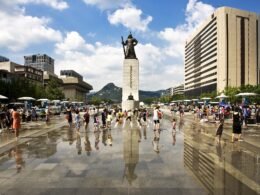
- South Korea
The Best Areas To Stay In Seoul – 2023 Guide

How European Interrailing Works: An Expert Guide
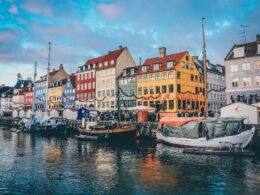
When Is The Best Time To Visit Denmark?

The Best Time To Visit Cancún & The Yucatán Peninsula
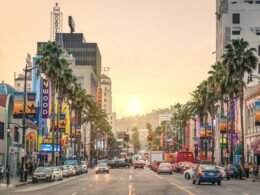
- United States
When Is The Best Time To Visit California?
- Deutschland
Best Time To Visit Colombia

Here’s a handy guide to Colombia’s seasons
One of the important things to consider when planning your Colombia vacation is the weather. This guide can help you decide on the ideal time for you to visit to enjoy a comfortable and memorable trip.
Set on the equator, most of Colombia experiences a tropical climate with a few seasonal variations. In the low-lying coastal areas to the North, especially near Cartagena and Barranquilla, expect temperatures ranging around 86°F throughout the year. As you journey towards the mountains, the temperature naturally changes according to the altitude – the higher you climb, the colder it gets.
The best times to visit Colombia are the two dry season phases. The first is between December and March , and the second is between July and August . The temperatures are relatively lower and rainfall is minimal, which makes it ideal for exploring Colombia’s cities, historic ruins and iconic coffee plantations.
Best Time To Visit
We recommend.
- Discover the lush Coffee Region, a UNESCO World Heritage site, with flora and fauna, plantations and villages
- Live the El Dorado dream at the Museo del Oro of Bogota, where ancient artifacts and 55,000 pieces of gold find pride of place!
- Be part of the Barranquilla Carnival, where, four days before Ash Wednesday, there are parades, dancing and of course partying!
- Make a trip to Santa Marta, the oldest colonial city of South America.
- Head to the ‘White City’ of Popayán to witness the spectacular religious processions during the Semana Santa (Holy Week) especially on Maundy Thursday
- Spring-like conditions make this a good time to visit Medellin with its hip nightlife, public art installations and sculptures of celebrated Colombian artists
- Discover, Villa de Leyva – surrounded by Andean peaks and foothills, the peaceful little town is a popular weekend getaway from Bogota
- See Cartagena’s lively, cobbled streets, architecture, colorful facades, trendy cafes and boutiques
- Lush rainforests, diverse wildlife, tranquil lagoons, hidden coves and archaeological wonders await you at Tayrona National Park
- Step back in time at Colombia’s colonial cities such as Barichara, Finlandia and Salento
- Not much rainfall makes this a good time to hike in the Cocora Valley with its majestic wax palm trees and picturesque valleys
- In Medellin, witness the Feria de Flores or the Flower Festival. Expect streets dotted with magnificent flower displays, live music and festivity!
- Visit the San Agustin Archaeological Park, a UNESCO World Heritage site, home to the largest collection of megaliths and monuments in all of South America!
- Follow in the wake of the Magdalena River – one of the greatest rivers in South America and the lifeline of Colombia
- Visit the town of Pitalito – renowned as the largest producer of coffee in Colombia – in the fertile Magdalena River valley.
- The first two weeks of October in Cartagena are full of festivities, parades and parties, celebrating Independence in the city
- See Bogota’s numerous national monuments and cultural landmarks and vibrant markets, and feast on local delicacies
- With the rains receding, visit the pulsating city of Bucaramanga with its numerous parks, art galleries, churches, museums and delightful shopping and eating experiences
Best Time to Visit Colombia by Season
October to November (Low Season) – Due to heavy rainfall, flash floods are common in Cartagena and the Caribbean shore. This is a great time for hiking in the Amazonas due to the low water levels.
March to September – Some cities such as Cali, Bogota and Medellin suffer a second bout of rainfall at this time, especially in the month of May. April is the best time for whale-watching in Cartagena, when the beautiful humpback whales travel here to nest and rear their young.
December to March (High Season) – Expect gorgeous sunny skies and warm weather, especially in the Andean regions.

What to Pack
Due to the wide range in temperatures between each region, we advise you to bring several layers of clothing for your Colombia tour, which you can quickly put on or pull out according to the weather.
In the cities: Light dresses are perfect for the city or for excursions during the day.
In the jungles: Please wear long-sleeved tops, shirts and pants to protect yourself and bring a light umbrella. It is a good idea to carry a small, waterproof backpack during walks and hikes, along with sturdy shoes, swimsuit, a small towel, sunblock and insect repellent.
Our experts can recommend the best time for your Colombia vacation and suggest unique things to do in Colombia . Get in touch with us for your personalized, obligation-free itinerary.
Discover the best time for your Colombia vacation with further inputs from our experts. We’ll advise you on when to visit and plan an unforgettable vacation customized entirely to your interests.
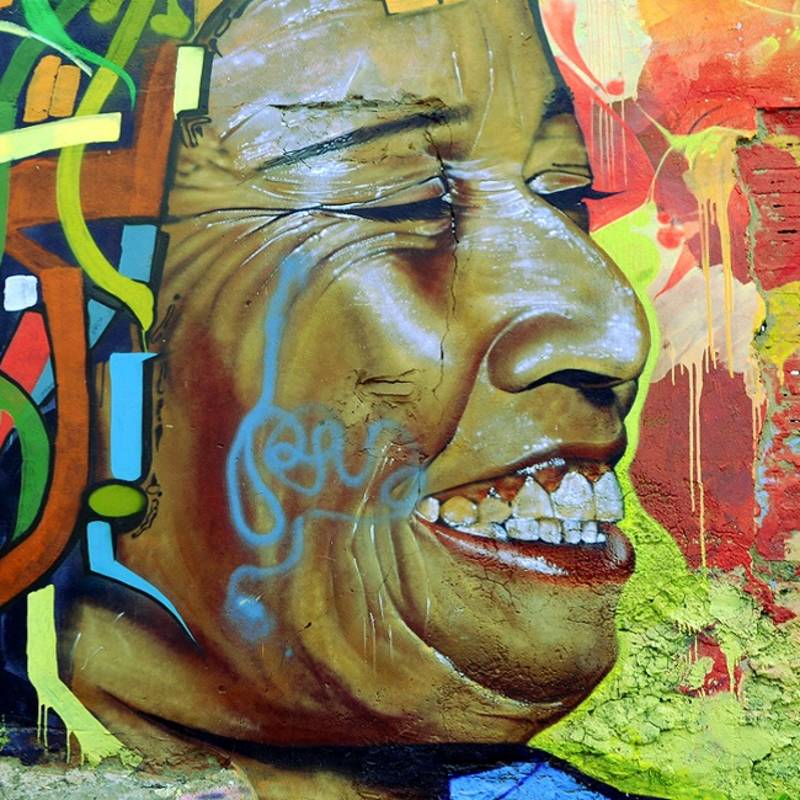
From the Blog
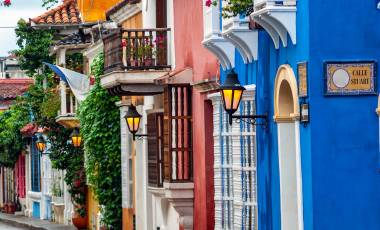
Colombia Vacation: On the Trail of Coffee and Gold
Planning a Colombia vacation? Ingrid Vultorius, our Head of South America, shares why she believes Colombia sparkles!
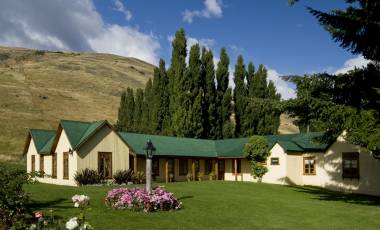
Our top 10 Haciendas and Estancias in Argentina, Chile and Uruguay
Discover why a tour in Argentina, Uruguay and Chile is incomplete without a stay in the charming estancias and haciendas that these countries are known for.
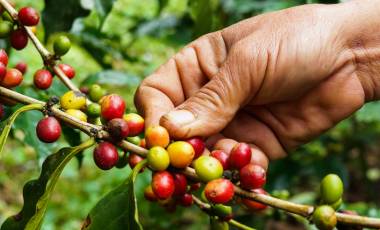
On the Trail of the Perfect Brew: Coffee
Travel to fertile lands for your favorite caffeine kick at the source during your private coffee tour. Set out on the trail of the perfect brew.
Popular Trips to Colombia
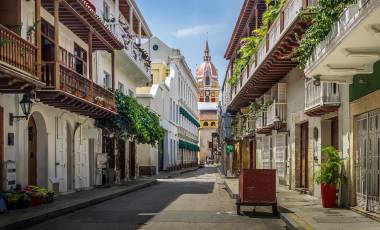
Colombia Dreams and the Panama Canal
Experience the best of Colombia as you traverse through the country, staying at exceptional boutique hotels and witnessing the many natural, cultural, and historical highlights along the way. Start your trip in Bogota and explore the most famous attractions of the Colombian capital, such as the Plaza de Bolívar and the La Candelaria district, on…
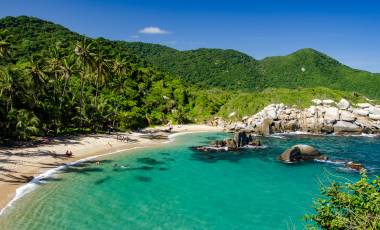
Colorfully Yours, Colombia
Uncover the popular highlights and the hidden gems on this Colombia tour. From the bustling streets of Bogota to the cobbled streets of tranquil Villa de Leyva, the coffee culture and traditions of the Andean region, leisurely hacienda stays, couture and salsa at Medellin, and the pristine beauty of Tayrona National Park – Colombia is…
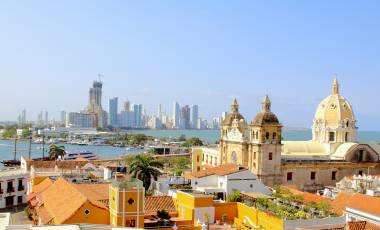
Colombia In-Depth: Culture, Coffee & Island Paradise
This Colombia tour is the perfect introduction to the best-loved highlights: vibrant cities, colonial heritage, archaeology, culture, museums and Gold Rush. With visits to the lush coffee region, hiking and island stays, experience the Colombian countryside and beaches too!
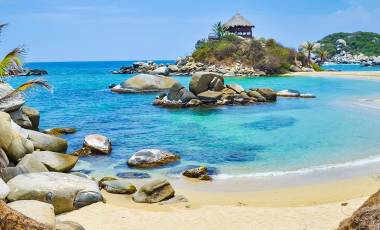
Colombian Luxury, Relaxation and Beaches
This Colombia vacation offers the perfect introduction to the country’s top three highlights – rich culture, colonial gems and heritage at Cartagena, verdant plantations and world class brews in the Coffee Region, and beachside relaxation at the pristine Baru Island!
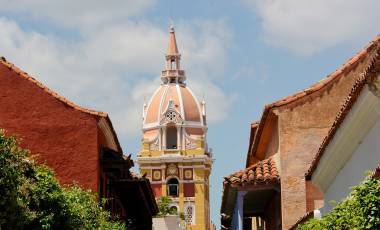
Colombia: Cities and Coffee
Discover the rich culture and traditions of Colombia at its best-loved cities – from cosmopolitan Bogota to vibrant Medellin and colorful Cartagena. Also enjoy downtime at a traditional hacienda and some world class coffee at the lush green Coffee Region, high up in the Andes.
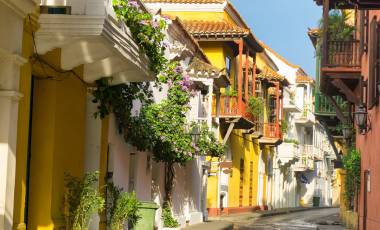
Cultural Ecuador and Colombia
Discover rich cultural heritage as you travel through the colonial cities of Ecuador and Colombia, right from Quito in the Andean highlands to colorful Otavalo, and bustling Bogota to timeless Cartagena. Highlights of your tour include a visit to the incredibly biodiverse Yasuni National Park in the Amazon as well as a brief sojourn in…
Best Places To Visit
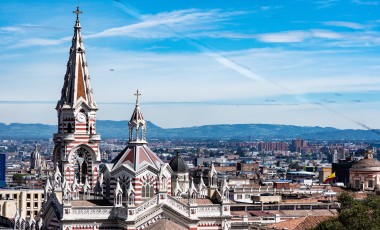
Set at an altitude of over 2,000 meters in Colombia’s Eastern Andean range, Bogota boasts wonderful highland climate and natural beauty. The capital of Columbia is dotted with numerous national monuments and cultural landmarks.
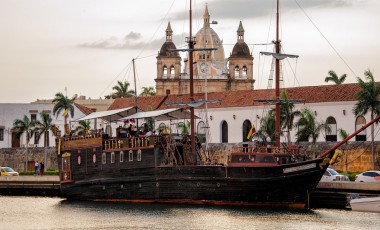
Cartagena, Colombia’s very own Caribbean beauty, has a way of getting under your skin with its ageless charm. In sharp contrast to its colonial architecture, lies upscale, beachside neighborhoods with highrises, shopping malls and trendy eateries.
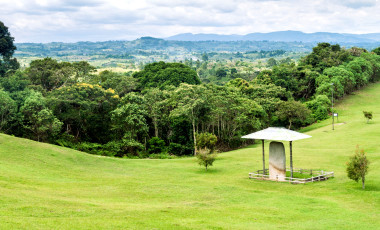
The wild and mystical San Agustín, riddled with architectural wonders, is listed as a UNESCO World Heritage site.
San Agustin
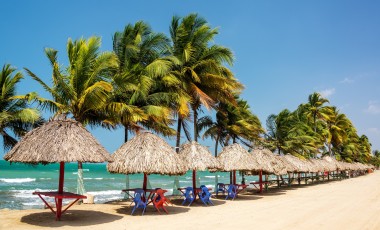
The oldest colonial city of South America, Santa Marta was established by the Spanish in the 16th century. The area around the old city dates back to the ancient Tayronas, who ruled the region before the Spanish invasion.
Santa Marta
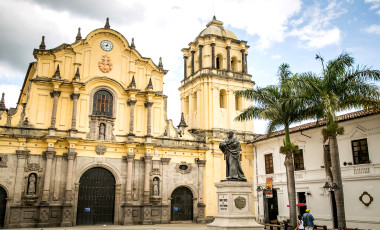
Also known as La Ciudad Blanca in Spanish, or ‘the White City’, Popayán was an important 16th and 17th century Spanish settlement in the colonial era.
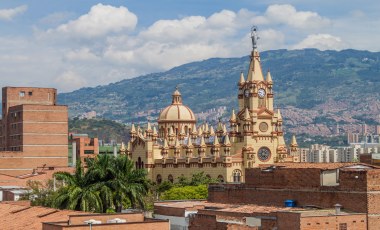
Aptly nicknamed the City of Eternal Spring, Medellin takes your breath away with the jagged mountain peaks of the Andes range providing a sharp contrast to the city’s modern skyline.
Things To Do
From pristine beaches in Tayrona National Park to grand, colonial cities such as Cartagena and Bogota, the mythical road to El Dorado and the pulsating beats of tango and salsa – our Colombia luxury tours introduce you to a world of treasures.
Descended from a mix of European, Asian and native Indian ethnic groups, Colombia’s diverse mix of cultures is evident in the country’s heritage, music, arts and cuisine. Plan your culture tour of Colombia with tips from our experts.
Travel Guide
What are the most important things to keep in mind while planning your Colombia luxury tours? Is it safe to exchange money in the country? How to obtain a Colombian visa? Find answers to all these questions and more in our Colombia travel guide.
The Enchanting Difference
Authentic & unique.
Our award-winning, licensed local guides provide incredible insights and exclusive experiences for you.
Personalized & Private
Our experts completely customize your private tour to match your interests and preferences.
High-Quality Experiences
All our accommodations and services are personally tested by our team.
Fully Supported Travel
You’ll have a personal and dedicated trip coordinator, backed by 24/7 support in case of emergencies while you’re traveling.
Financial Protection & Flexibility
Your booking is flexible and completely secure with us.
Safe & Secure
Your safety and well-being are our top priorities.
What Our Guests Say
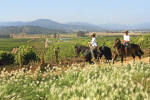
Do you have a vacation in mind? Personalize your itinerary with our Trip Builder.
Best time to visit Colombia

The climate in Colombia stays pretty consistent throughout the year but December to March is considered the best time to visit for warm temperatures and sunny conditions. You can also visit Colombia between June and September as these months receive very little rainfall. However, these two periods are also the busiest, so expect to see large crowds at popular sites and increased accommodation prices.
The best time to visit Cartagena coincides with the best time to visit Colombia in general, with the period of December to April promising the most comfortable temperatures (warm without being too hot) and minimal rainfall. This is also Colombia’s peak season for travel, so expect to see plenty of tourists crowding Cartagena’s old town and exploring its historic buildings.
There are a few options when it comes to the best time to visit Bogota; from December to March, when the whole country experiences reasonably nice weather and from June to November, when the weather holds steady and doesn’t fall into the same rainier patterns as other regions across the country.
While December to March is the peak season to travel (tourist galore), June to November is relatively quiet, allowing you to wander the museums, explore the street art and admire the city’s cathedrals on your own.
Best for: beach hopping along the country’s northern coast and street parties/parades
The weather conditions in Colombia in January can differ dramatically depending on where in the country you are. Temperatures can range from a comfortable 63°F near the Ecuadorian border to around 95°F in the country’s northeast (near the Venezuelan border) so it’s best to pack for all seasons if you plan on traveling around.
Because of the large variances in temperatures across the country, weather conditions can be vastly different, too, with heavy rainfall and thunderstorms expected in the west, while Bogota enjoys plenty of sunshine hours and minimum rainfall. Regardless of where you are, Colombia starts the new year off with a bang, thanks to vibrant local parades and bustling street parties in several major cities.
Best for: carnival celebrations and visiting UNESCO World Heritage-listed sites
Colombia has two distinct seasons – a dry period and a wet period – with the first of those dry periods running from December to March, so February is one of the last months to make the most of the dry weather (until June). Having said that, it’s a relatively quiet month to visit, so you won’t have to deal with hoards of tourists and the exorbitant prices of peak season months.
While there’s plenty to do in Colombia in February, one of the main drawcards of the month is Barranquilla’s carnival celebrations. Known as one of the biggest folkloric celebrations in all of South America , this festival holts all normal activities in favor of street dances, musicals and masquerade parades and brings together people from all over.
Best for: learning how to salsa dance and religious celebrations
Countrywide, the weather is fairly moderate in March, but exact temperatures differ depending on the altitude of the city you’re in. For this reason, coastal regions can experience very hot and humid weather, while cities such as Bogota tend to be colder. However, generally, it’s still a pleasant month to visit Colombia.
Semana Santa (also known as Holy Week) is a massive religious celebration that takes place every March throughout the country and is well worth participating in if you’re traveling through Colombia at the time. Festivities often include large processions and gatherings full of delicious traditional food. Sign us up.
Best for: city exploring and coffee plantation visits
April in Colombia is officially the start of the year’s first wet period (which runs until the end of May), but that doesn’t mean you still can’t enjoy your time away. Altitude plays a big role in determining the weather patterns, so you can expect popular destinations such as Bogota and the Amazon region to be inundated with constant and often heavy rainfall. This can also affect any activities near or on the Amazon River, as flooding during this time is quite common.
But one of the silver linings of traveling in April is that it fits into one of Colombia’s shoulder seasons, so there’ll be greater availability, cheaper accommodation prices and fewer crowds at popular sites. Soak up as much of Colombia’s culture as you can by exploring cities such as Medellin (which enjoys a semi-springtime climate all year round) and visiting coffee plantations in the country’s south.
Best for: camping and other outdoorsy-type activities
The low season in May is still in full swing in Colombia, so it’s a great time to make the most of the country’s vibrant cities and iconic locations without the swarms of tourists. Off-peak season also usually means crappy weather conditions, but May is the exception, with little to no rainfall expected across the month. While perfect weather can’t be guaranteed, temperatures do stick around the 68°F mark in Bogota, climbing higher as you spread across the country to reach highs of 85°F+ in the country’s northern regions.
Best for : road trippin’ and learning about Colombia’s culture
June marks the beginning of Colombia’s second dry season, also coinciding with the beginning of the country’s peak season. But while it might technically be the ‘dry’ season, rainfall can still occur in several regions as Colombia’s climate is primarily dictated by topography. If it does rain, though, it’s likely to be light and brief so you still have plenty of time to explore captivating landscapes.
Because the weather is so nice in June, it’s a great time to head out of the cities and out into the vast Colombian wilderness on the road trip of a lifetime. Don’t get us wrong, Cartagena and Bogota are beautiful but there’s nothing like cruising with your best buds past endless rainforest greenery towards fascinating national parks and historic heritage-listed sites.
Best for: exploring the Amazon region, hiking and local market wandering
One of the great things about Colombia is that, while its cities are definitely worth a visit, it also has a lot of national parks and natural beauty to explore, so even if you travel in the peak season of July, not everywhere you go will be crowded with thousands of tourists. Swap the concrete for greenery and make your way to the lush Amazon region where river levels are low (thanks to minimal rainfall) and the wildlife comes out to play. Or try hiking through Los Nevados National Park in search of tropical glaciers, volcanoes and glittering lakes.
Best for: flower festivals, kite festivals and Amazon River exploring
August in Colombia is all about the festivals, with Feria de Flores taking place in Medellin over the first two weeks of August and Festival del Viento y de los Cometas (kite festival) being held on the windiest weekend in Villa de Levya in the country’s center. Both festivals attract a lot of curious travelers to the respective regions with activities such as horse shows, concerts, decorations and ‘best handmade kite’ competitions on offer.
Best for: whale watching, boating on the Amazon River and festivals
September in Colombia marks the end of the country’s second dry period, so while weather conditions are still optimal, expect increased rainfall and overcast days with lower temperatures towards the end of the month. However, this isn’t true for all regions, as Colombia’s coastlines are always relatively hot and humid thanks to their low altitude and proximity to the equator.
This is also a good time to travel if you’re looking for fewer crowds and lower accommodation prices (who isn’t?), as September is technically part of Colombia’s shoulder seasons and, therefore doesn’t attract as many travelers as the peak months do.
Some popular activities to do during this time include whale watching and ooo-ing and ahh-ing over baby sea turtles in the Choco region of the country, showing off your salsa moves at various festivals and taking a boat ride along the Amazon River.
Best for: café hopping, gallery wanderings and Halloween festivities
October is the official beginning of the second wet period in Colombia, but fear not, this one only lasts for two months (until the start of December). Average weather conditions aren’t the greatest, so having inside activities lined up for when the rain starts pouring and the days are a little colder is a smart move. Rainfall falls intermittently throughout the day with the potential of heavier thunderstorms in the afternoon, so there are not a lot of sunlight hours to enjoy during the day.
Best for: trying traditional Colombia food and museum wanderings
Generally, Colombia is a quite humid country experiencing above-average humidity levels throughout the year but November is the most humid month with a 74% rating. So, keep this in mind when you’re planning outdoor activities and make sure to drink lots of water to avoid dehydration.
But don’t let that deter you from vising. While being in Colombia’s second wet period, November still promises pretty decent weather with average temperatures of 66°F across the country (keep in mind this can go up or down depending on the altitude of the destination you’re in). Expect plenty of rainfall though with 5 inches expected.
Best for: Christmas and New Year's festivities
Colombia’s dry period is back in December; unfortunately, so are the tourists. Expect to see plenty of North Americans looking to trade a white Christmas for a tropical one, with pleasant weather expected across the country. Bogota remains relatively dry, the Caribbean coastlines are as hot as always and Medellin enjoys moderate temperatures and plenty of sunshine.
To go with the good weather, the good times keep on rolling as the month progresses, with the country preparing for Christmas and New Year's celebrations. Festive parades fill the streets in most larger cities and locals really go all out in decorating their homes and businesses with colored lights and images of Christmas – think candy canes, reindeer and Christmas trees.
Let's create an exclusive trip for your group.
I love solo travel, but anonymous travel is what I really need
Galapagos or Madagascar? Which unique destination should be at the top of your travel list?
Central vs South America: how to plan your next trip
Travelling to Chile? Here’s the best time to go
7 different ways to see Patagonia with Intrepid
From heartache to hiking boots in Peru’s Sacred Valley
Argentina or Chile? Which South American country should you travel to?
After losing my phone in Colombia, I found a better way to travel

© Shutterstock
Soaring Andean summits, unspoiled Caribbean coast, enigmatic Amazon jungle and cryptic archaeological ruins. Colombia boasts all of South America's allure and more.
Best Time to Visit
Best places to visit, leave the planning to a local expert.
Experience the real Colombia. Let a local expert handle the planning for you.
Attractions
Must-see attractions.
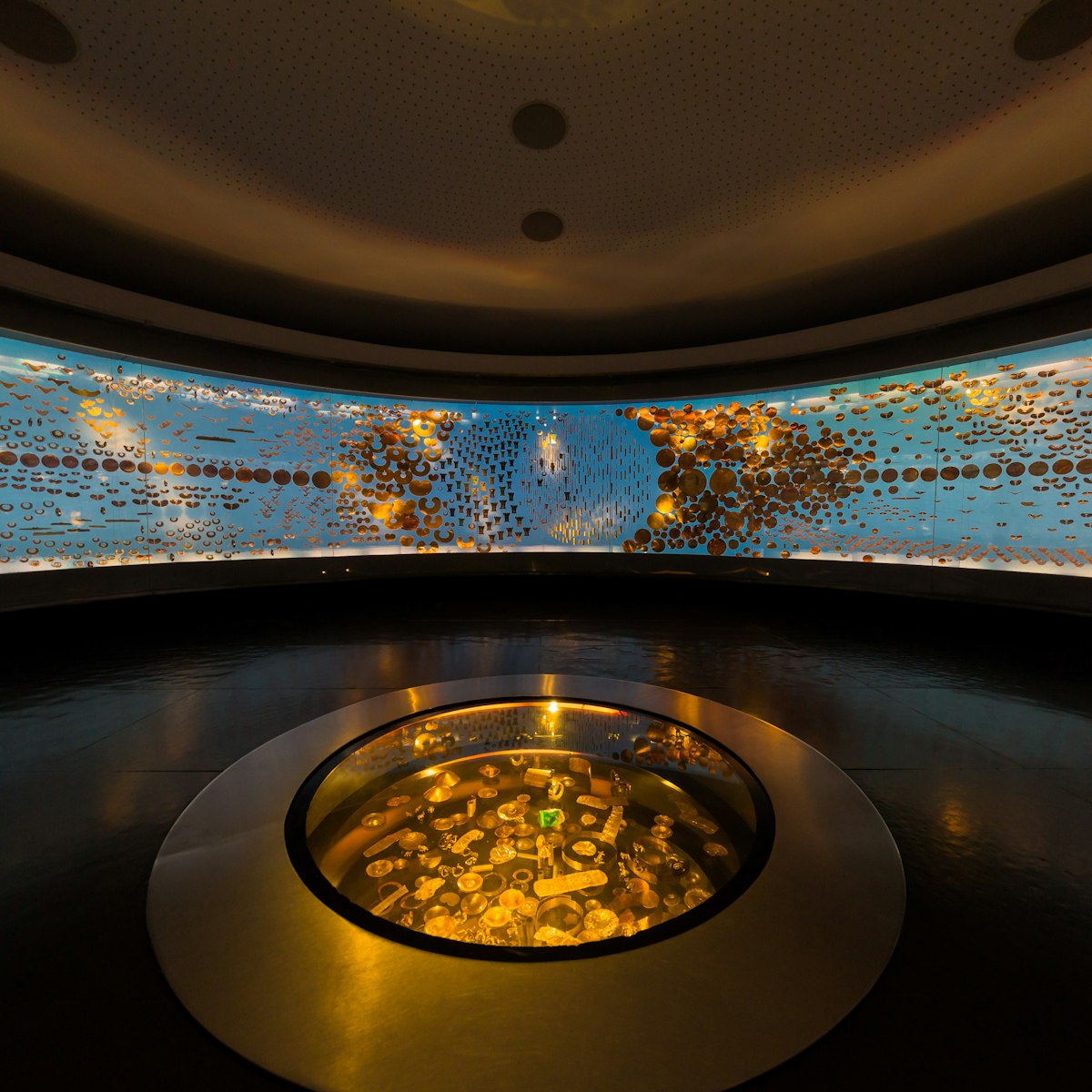
Museo del Oro
Bogotá's most famous museum and one of the most fascinating in South America, the Gold Museum contains more than 55,000 pieces of gold and other materials…
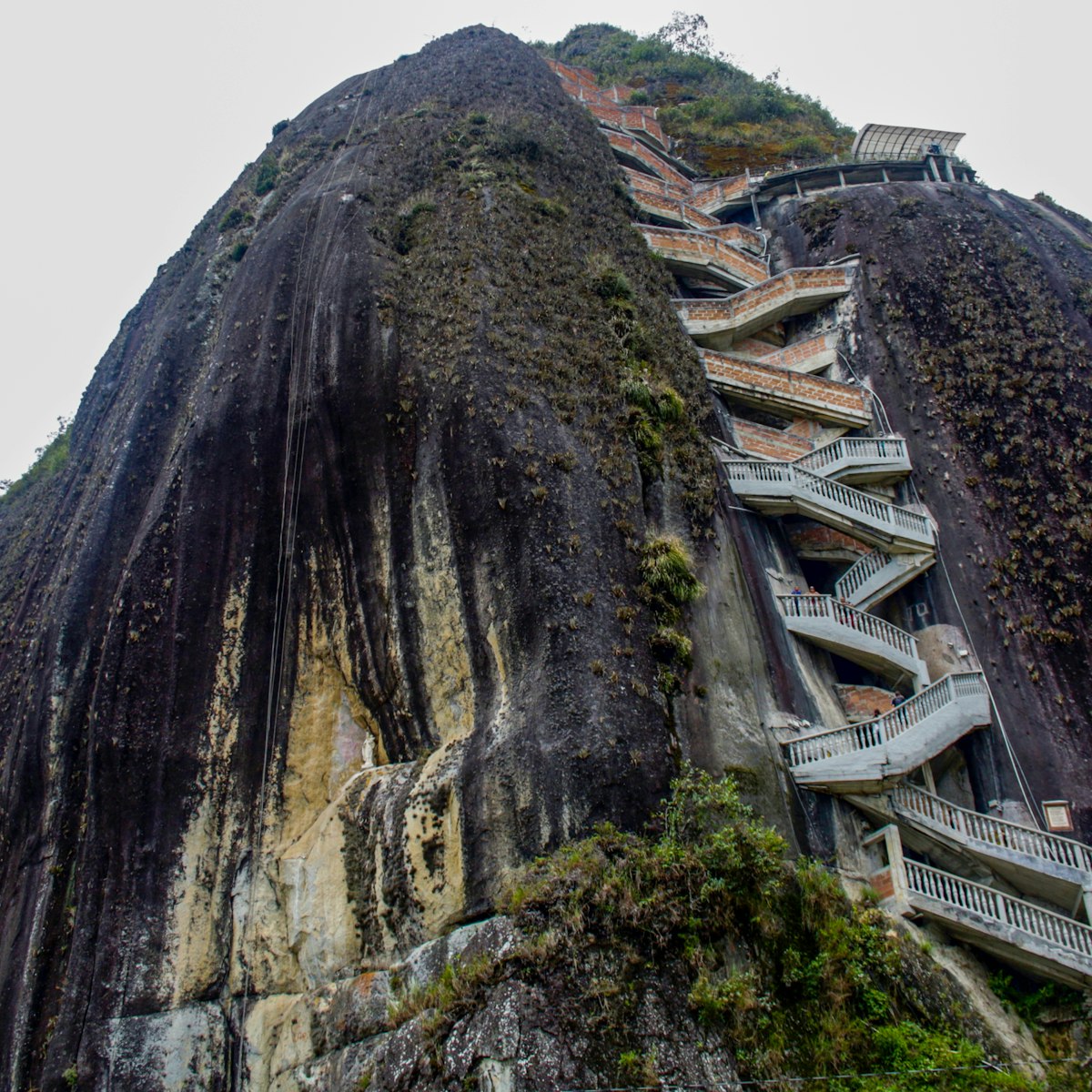
Piedra del Peñol
Also known as El Peñon de Guatapé, thanks to the fierce rivalry between the towns it straddles, this 200m-high granite monolith rises from near the edge…

Parque Arqueológico
Cauca & Huila
This 78-hectare archaeological park is 2.5km west of the town of San Agustín. There are over 130 statues in the park in total, either found in situ or…

Cartagena's old city is its principal attraction, particularly the inner walled town, consisting of the historical districts of El Centro and San Diego…

Museo Casa de la Memoria
This harrowing museum dedicated to the urban conflict in Medellín is a must-visit for travelers wanting to fully understand the city (and Colombia). There…

Parque Nacional Natural El Cocuy
One of Colombia's most spectacular national parks, PNN El Cocuy is mostly made up of a diverse ecosystem known as the páramo. This glacially formed,…
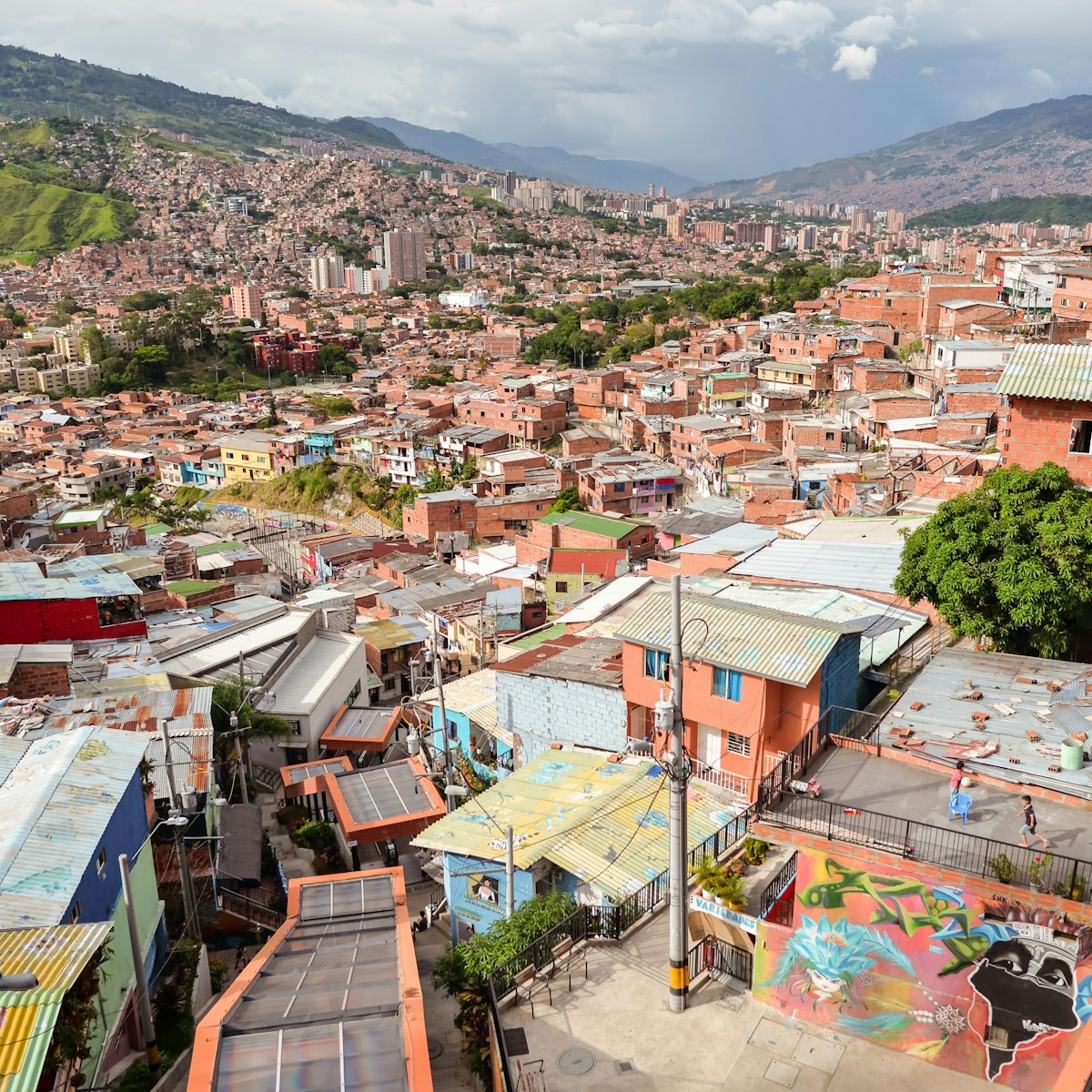
La Comuna 13
Once one of the most dangerous neighborhoods in Medellín, the Comuna 13, which clings to the mountainside above the San Javier metro station, has…
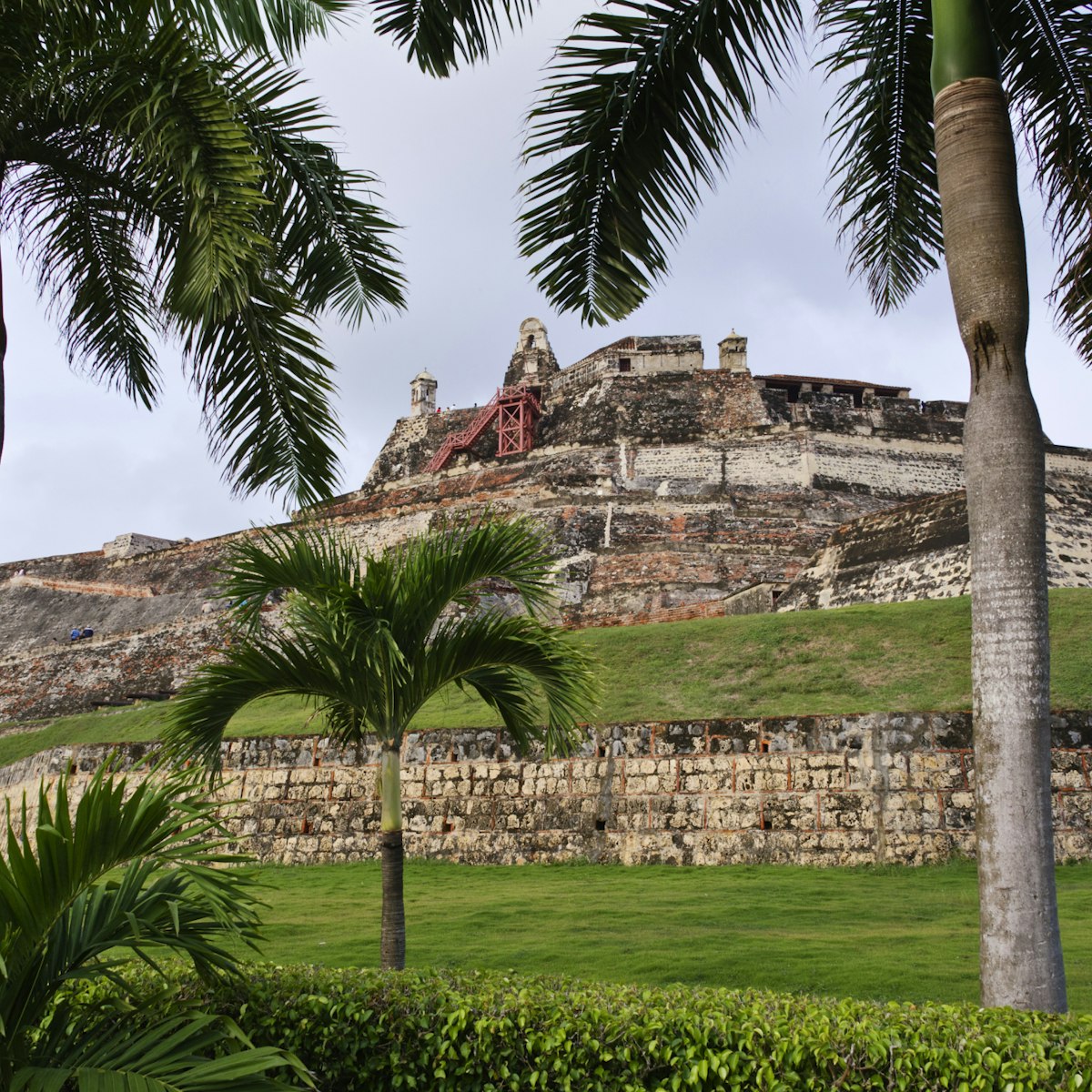
Castillo de San Felipe de Barajas
The greatest fortress ever built by the Spaniards in any of their colonies, the Castillo de San Felipe de Barajas still dominates an entire section of…
Top picks from our travel experts
14 best experiences in colombia in 2024.

Desierto de Tatacoa
Technically not a desert but a landscape of red and gray rock, sculpted by ancient waterways, the Desierto de Tatacoa is one of Colombia's most unique…
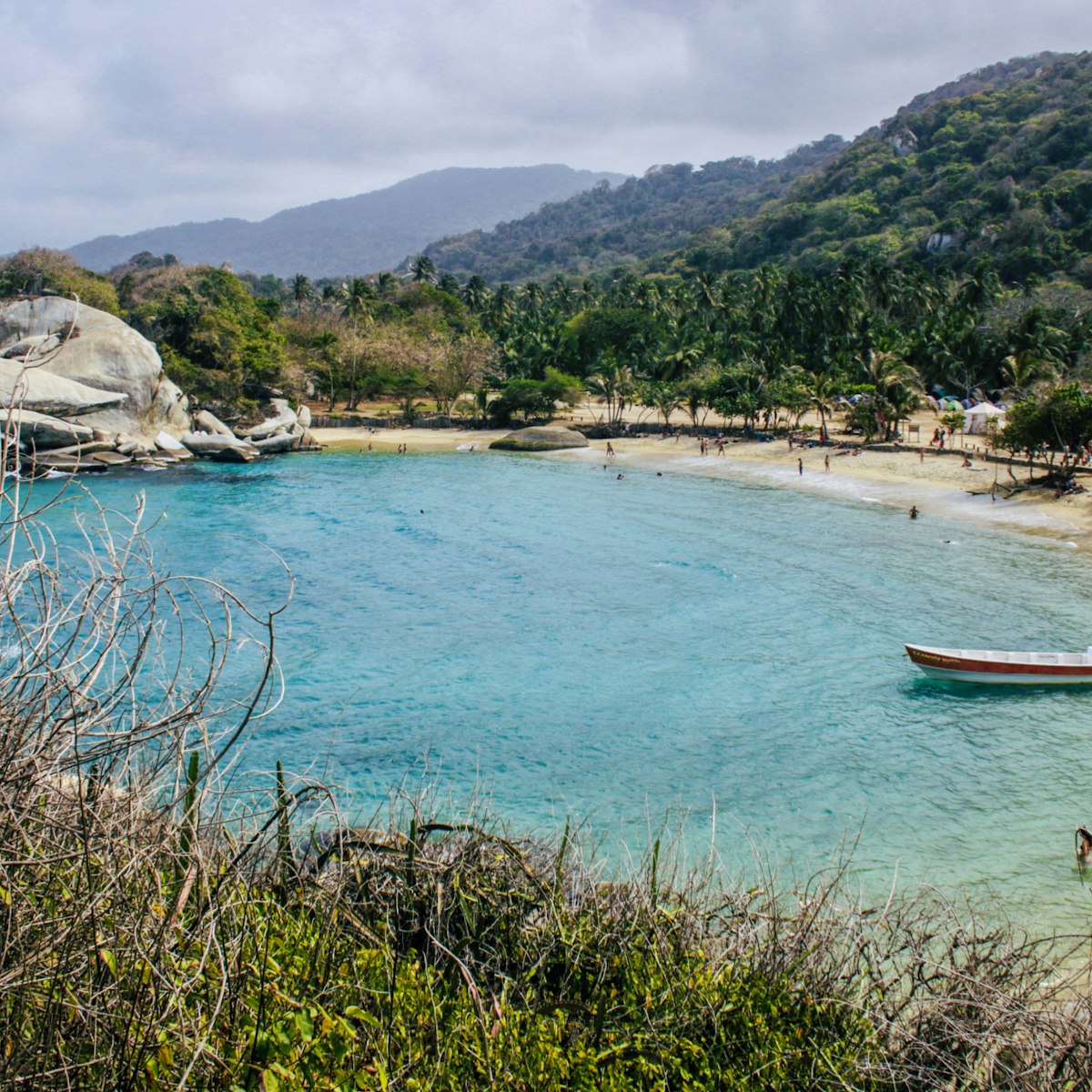
Cabo San Juan del Guía
Parque Nacional Natural Tayrona
Cabo San Juan del Guía is a beautiful cape with a knockout beach. It's also by far the most crowded area of the park, although lack of road access deters…
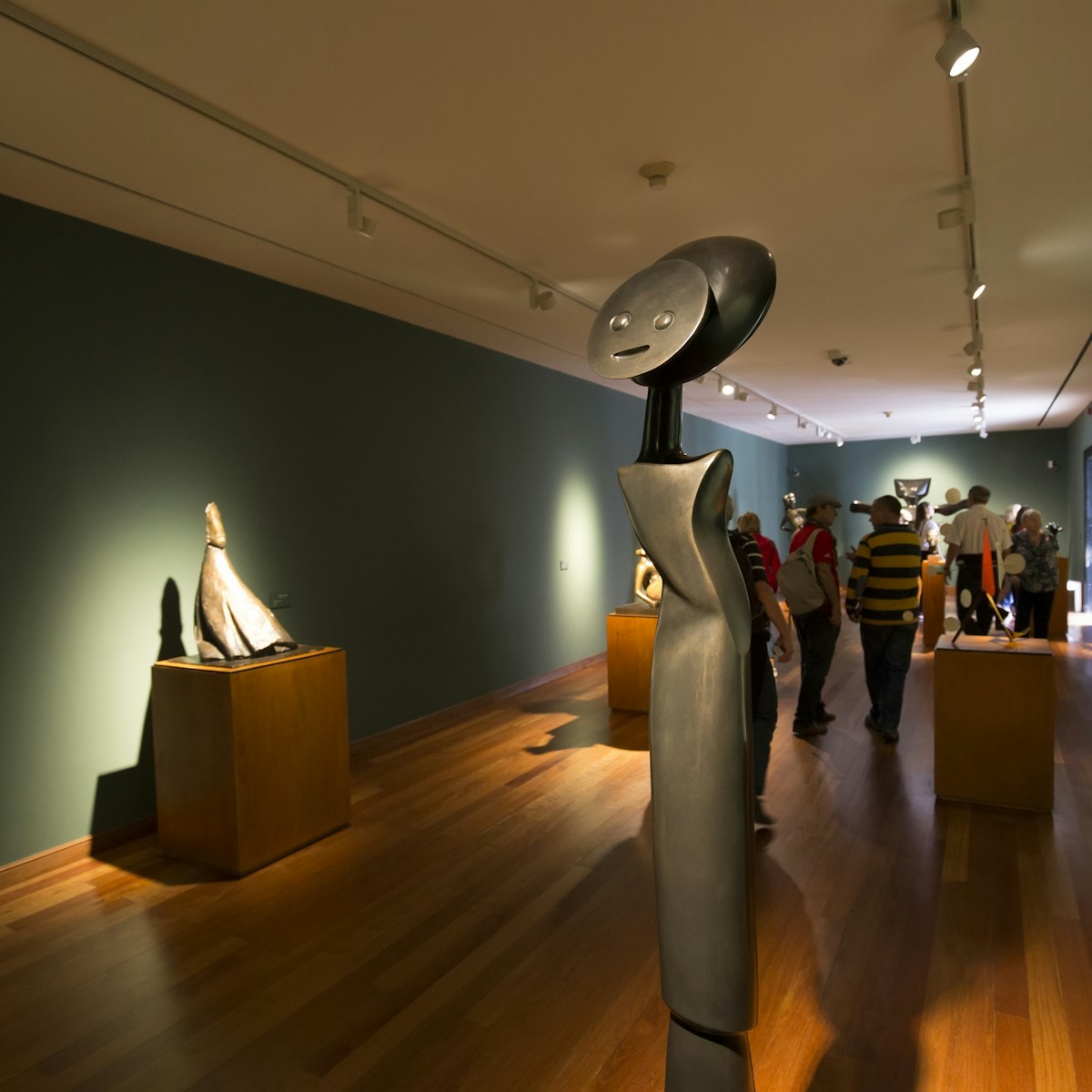
Museo Botero
Even if you've never heard of Fernando Botero, you'll probably recognize some of his highly distinctive paintings of oversized (read: chubby) characters,…

Hacienda Venecia
Zona Cafetera
This hacienda has won numerous awards for its coffee. It offers a tour in English that includes an informative presentation about Colombian coffee, an…

Topa Tolondra
Popular with locals and travelers alike, this large salsa bar near Loma de la Cruz is always buzzing. The tables are pushed right up against the walls,…
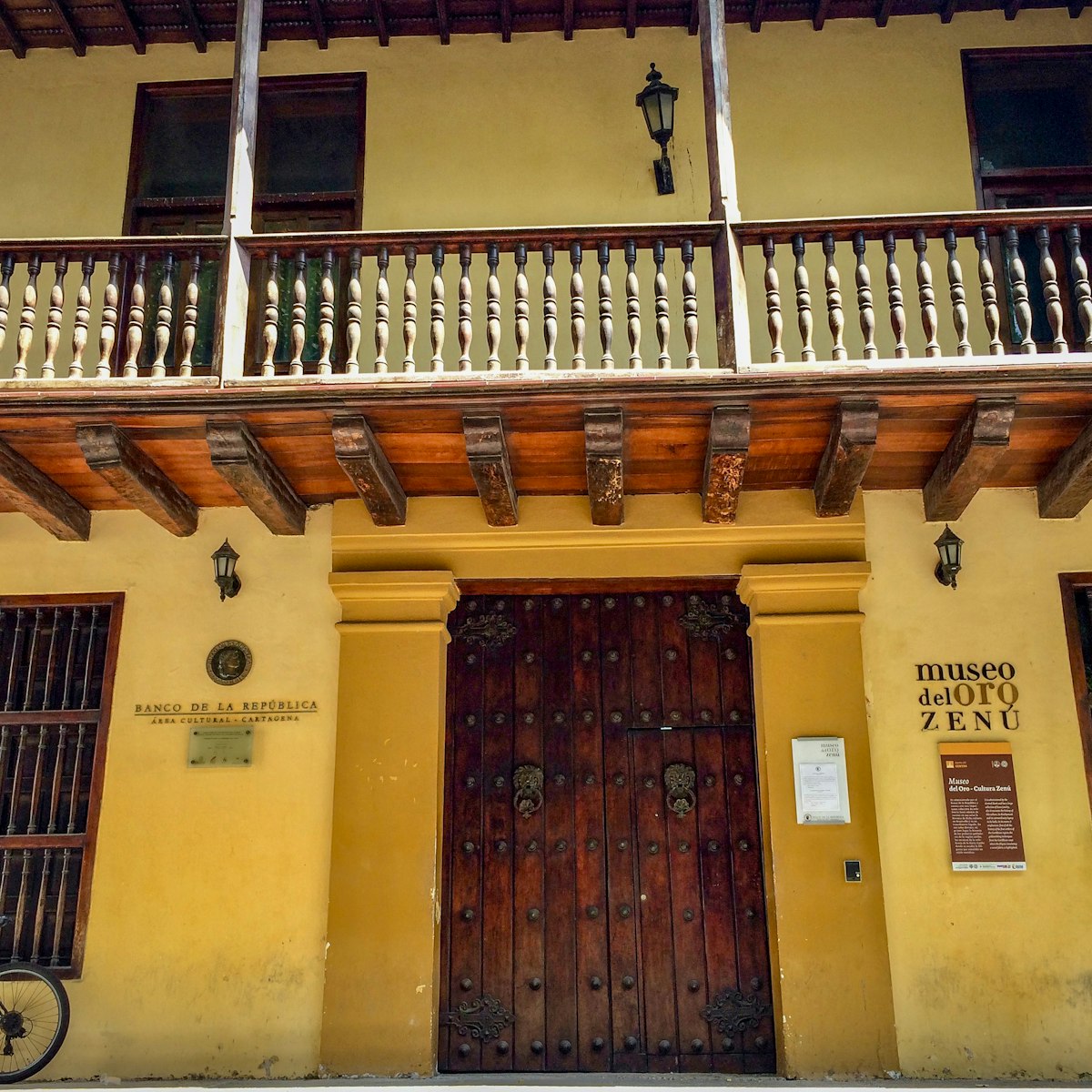
Museo del Oro Zenú
This museum is like a miniature version of Bogotá's world-class gold museum, the Museo del Oro. Though small, it offers a fascinating collection of the…

Parque Nacional Natural (PNN) Los Nevados
One of Colombia's most awe-inspiring national parks, PNN Los Nevados encompasses 583 sq km of rugged terrain in the heart of the Colombian Andes. Its…

El Cerro de Moravia
The densely populated neighborhood of Moravia was once Medellín's municipal rubbish dump with an open-air mountain of trash surrounded by a large shanty…

Observatorio Astronómico Astrosur
Former Tatacoa Observatory resident astronomer Javier Rua Restrepo now runs his own observatory around 1km further away from town. He is a dynamic teacher…

Hacienda Guayabal
This slow-paced working coffee farm near Chinchiná is a great place to come and unwind while surrounded by cafetero culture. It runs an excellent tour…

Cañaveral is as far as you can go in the park by road. From the car park a trail leads west to Arrecifes and Cabo San Juan del Guía. The beaches in…

Parque Nacional Natural (PNN) Old Providence McBean Lagoon
Providencia
To protect the unique marine life here, a 10-sq-km nature reserve in the island's northeast was established in 1995. About 10% of the park's area covers a…
Scattered across the hills around the little town of San Andrés de Pisimbalá, Tierradentro's Parque Arqueológico includes four tomb sites, an above-ground…
Planning Tools
Expert guidance to help you plan your trip.
Best Things to Do
Colombia attracts record numbers of visitors with its incredible landscapes, vibrant cities and warm welcome. These are the top 14 things to do in 2024.
Things to Know
Have an unforgettable trip to Colombia with these planning tips on everything from transport to health, safety and etiquette.
Transportation
Colombia's landscape is stunning and impressive but those features can be hard to navigate on the ground. Here's how to get around Colombia.
Visa Requirements
With its warm, welcoming atmosphere and jaw-dropping national parks and beaches, Colombia is a joy to visit, Here's what you need to know about visas.
Money and Costs
Colombia is one of the best-value destinations in South America. Stretch your cash even further with our top tips on how to visit on a budget.
Traveling with Kids
Discover the family-friendly side of Colombia with these age-appropriate destinations and activities for unforgettable vacations with kids.
Best Road Trips
From incredible mountainous landscapes to stunning uncrowded beaches, Colombia has some once-in-a-lifetime road trips. Here are 5 of the best.
Plan with a local
Experience the real Colombia
Let a local expert craft your dream trip.
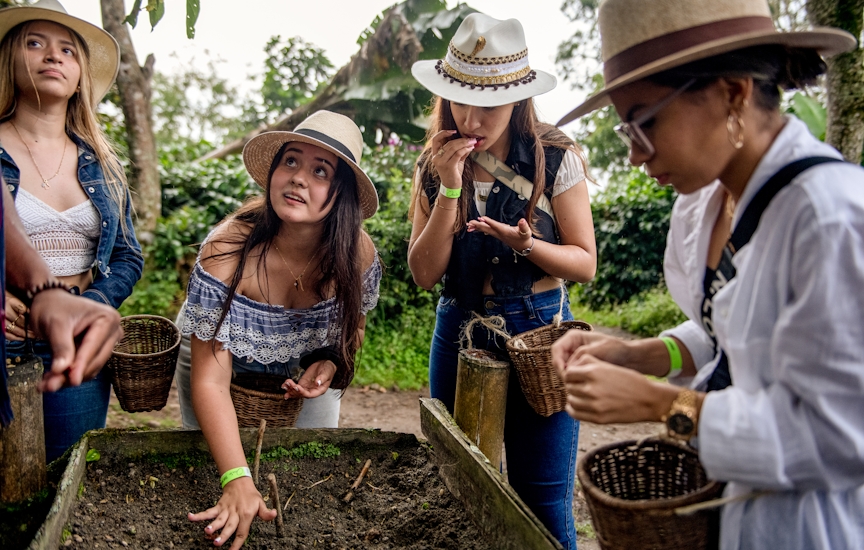
Latest stories from Colombia
Filter by interest:
- All Interests
- Adventure Travel
- Art & Culture
- Beaches, Coasts & Islands
- Food & Drink
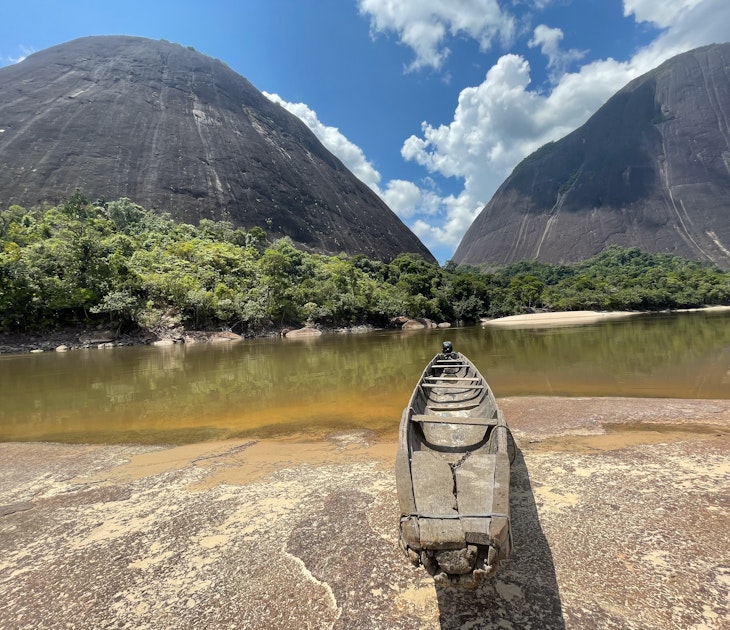
Apr 10, 2024 • 8 min read
Here’s how to get off the beaten track and discover the best of the magnificent Colombian rainforest.
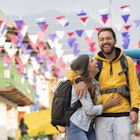
Mar 9, 2024 • 11 min read

Feb 29, 2024 • 9 min read

Feb 11, 2024 • 9 min read

Oct 2, 2023 • 8 min read

Oct 2, 2023 • 11 min read

Oct 1, 2023 • 4 min read

Sep 30, 2023 • 6 min read

Sep 23, 2023 • 5 min read

Sep 21, 2023 • 8 min read
in partnership with getyourguide
Book popular activities in Colombia
Purchase our award-winning guidebooks.
Get to the heart of Colombia with one of our in-depth, award-winning guidebooks, covering maps, itineraries, and expert guidance.
Colombia and beyond
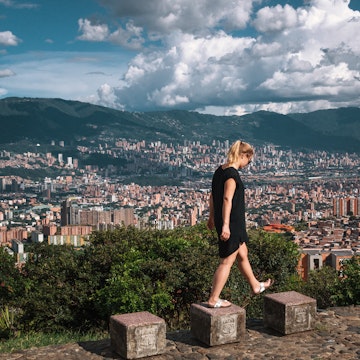
Subscribe & get your free guide to going abroad!!
Best Time to Visit South America: Everything You Need to Know, Weather, When to Go, and More…
Traveling the huge continent of South America is an amazing, adventurous, and exciting experience. However, with so many climates, geographies, regions, and types of adventures, understanding when is the best time to visit South America can be tough. Picking the right time to travel to South America can mean the difference between landing in amazing festivals, hiking under clear, dry skies, and hit the beach on sunny days with warm temperatures and thin crowds. We’re hear to make sure your adventure is the best possible.
In this guide, we will share the absolutely best times to visit South America, breaking it down by when to visit each country, city, and experience for maximum enjoyment, thinner crowds, and the best weather and memories possible.
Read on to learn the perfect time for your South America travels.

Up Front: What Is The Best Time To Visit South America?
- The Best Places to Visit in South America: By Month
- South America by Seasons
- Best Time to Visit Each Country In South America
- Best Times to Visit the Major Destinations in South America
Patagonia, Torres del Paine National Park, and Perito Moreno Glacier
Machu picchu, the inca trail, and the salkantay trail, atacama desert.
- Bolivian Altiplano and Salt Flats
Amazon Rainforest + The Pantanal
- Galapagos Islands
- Iguazu Falls
- The Lost City – Ciudad Perdida
The Biggest South America Festivals and When to Go
Be sure to read our post on the Best Backpacking Routes for your South America Itinerary
June to November are the best months to visit South America, with June, July, and August being the dry months to explore outdoors in Bolivia, Peru, and Ecuador, and September, October, and November being the pleasant spring months to explore Argentina, Chile, and Patagonia.
Spring is the single best season to visit South America and lasts from September to November.
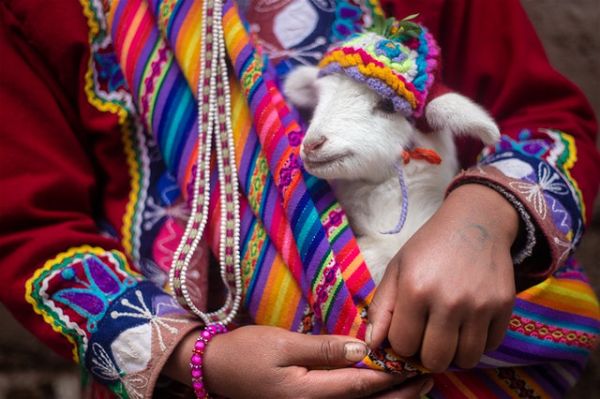
However, there is a very specific best time to visit each country in South America, do each adventure (Patagonia, Galapagos Islands, Machu Picchu, etc.), and experience the major events (Carnival, Gaucjh Festival, mating season and hatchling season on Galapagos, etc.).
Continue ready to discover the perfect experiences for the time you already have booked, and discover when to go for your dream experience and destinations.
The Best Places To Visit in South America: By Month
January .
- Peak of summer in Chile, Argentina, Brazil, Colombia, and Uruguay
- Best time for the most famous Brazilian beaches (on the southern coast), at the peak with clear skies, hot weather, and perfect conditions to visit while outdoor concerts, markets, and fests are common
- Best season for the coffee zones in Colombia – great, warm temperature with minimal rain
- Feast of the Three Kings happens across South America, best celebrated in Ollantaytambo in the Sacred Valley in Peru
- Great month to backpack Patagonia, for clear skies, no rain, and warm temperatures, but major sites such as Torres del Paine and Perito Moreno Glacier will be packed.
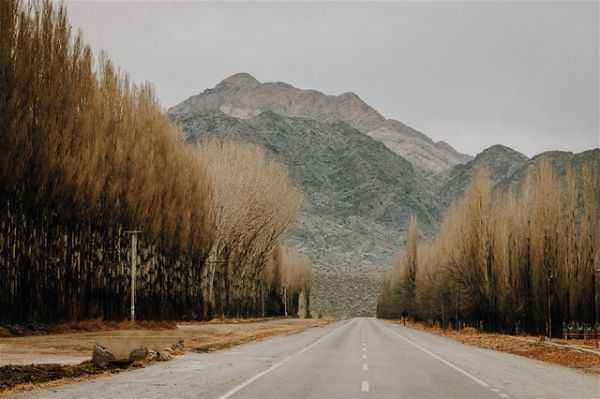
February
- Carnival occurs one week before lent (either in February or March) and is best experienced in Salvador or Rio in Brazil or in Barranquilla, Colombia, but Argentina has some excellent parties too.
- Galapagos is at a perfect, warm temperature in the Pacific, with land birds in mating season and sea turtles, and marine iguanas in nesting season
March
- Shoulder season for tourism across South America as crowds thin and the weather cools into fall
- Fiesta de la Patria Gaucha, celebration of gaucho culture and rodeos in the gaucho heavy regions of Argentina
April
- Peak of the wine harvesting season (March to May) in the Mendoza region of Argentina, great for small festivities and wine tastings around Maipu
- Fall season in Patagonia delivers cooler temperatures, with skies still clear and beautiful autumn colors, great for hiking through Patagonia with the plus of thinner crowds
- Sea turtles and iguanas are in hatching season on the Galapagos Islands
- Bolivia enters the dry season , making an adventures trip to the salt flats, altiplano, and Lake Titicaca more enjoyable
- Brazil enters the dry season , making the Amazonian wetlands of the Patanal a more pleasant experience with less rain
- South America enters the end of fall and beginning of winter, with fewer tourists in South America , especially as you travel further south
- The “El Senor de Gran Poder” festival happens in La Pax in May and June, bringing thousands of dancers into the streets of La Paz
- Peak tourist season in Peru, Bolivia, and Ecuador, thanks to dry season, so plan on larger crowds and higher prices
- The Incan festival of “Inti Raymi” is the “Festival of the Sun” celebrated on the winter solstice of the southern hemisphere in Peru
- In the Galapagos Islands, the Blue Footed Boobies are mating and in full mating rituals
- Urban cities of Buenos Aires, Santiago, Lima, and Rio are cooler and more enjoyable for nights out
- Colombia’s dry season happens (briefly)
- Ski resorts in southern Argentina and Chile are likely experiencing snow and open for skiing and snowboarding
August
- Spring in the Amazonian wetlands of the Pantanal, and a perfect time to visit
- Peak of high season for tourism in Peru and Bolivia
- Festival of flowers in Medellin , Colombia, with city filled with bands playing live and decorative flower displays throughout
- Tango Festival in Buenos Aires
September
- Peak season for penguin viewing and whale watching around Tierra del Fuego and the many islands of southern Argentina
- Weather is warming into Spring in Argentina and Chile
- In the Atacama desert, tourism numbers are still low, and it is a great time for lower prices and equally great weather
- Chilean Independence Day is celebrated on September 18th with parties, dancing, and food nearly everywhere in Chile
October: Great time for Outdoor and wildlife experiences
- Spring bloom of trees and flowers throughout Patagonia making for warmer temperatures and still thin crowds
- In the Galapagos Islands, land birds and sea lions can be seen raising their pups on the “outer islands” beyond Santa Cruz and San Cristobal
November
- Brazil, Chile, Uruguay, and Argentina are approaching high tourism season again
- Patagonia is likely busy again, requiring a reservations of 1+ month for accommodation in town and at refugios
- The best season to visit Colombia, especially the charming, smaller villages
SOUTH AMERICA BY SEASONS
Because the continent of South America is split by the equator, some of South America’s countries run on southern hemisphere seasons, some of the countries experience the warm, mild, sunny climate of equatorial countries, and some countries experience northern hemisphere seasons.
For Argentina, Chile, and Patagonia, summer happens in November to February, winter from June to August (as these countries are in the southern hemisphere)

For Ecuador, Northern Brazil, and Colombia, summer from May to August and winter from November to February, as these countries are (primarily) in the Northern hemisphere
Across South America, Throughout the Seasons
December, January, and February (Summer in South America) in Bolivia, Peru, and Ecuador will be rainy throughout the wet season March, April, and May (Fall in South America) is the shoulder season for the average South American’s vacation calendar, meaning thinner crowds and lower prices in most areas of South America
June, July, August (Winter in South America) are the dryest months in Ecuador, Bolivia, and Peru, making them optimal for trekking the Inca Trail, hiking Machu Picchu, and visiting the Bolivian Altiplano and salt flats
September, October, and November (Spring in South America) are the South American spring months, perfect for exploring the cities – like Buenos Aires, Colonia, and Santiago – on gently warm, sunny days, while Europeans and North Americans return home to work making for thinner crowds during the most pleasant months
BEST TIME TO VISIT EACH COUNTRY IN SOUTH AMERICA
The best time to visit brazil.
Brazil is so large, roughly 47% of South America, that the seasons and climate are different throughout the country at any given time. Not just varying from the deep Amazon rainforests to the metropolis of Rio and the sunny beaches, but extending into various seasonal zones. As a result, at any given time there is a great place to visit in Brazil.
Generally, Brazil’s summer is from December to March and winter is from June to September.
The warmest, sunniest months for Brazil’s southern beaches are October to April while the northern beaches are sunny and warm year-round.
The Amazon rainforest is hot year round and rainfall fluctuates an affects whether the water level is high or low. However, the region can always be visited – you’ll just have to adjust your plans from staying in a lodge, to riding a riverboat cruise.
The Best Time To Visit Chile
November to March is the best time to visit Chile, from the quiet big city of Santiago, to the wine country of the Casablanca valley, and south to Pucon and Patagonia, the entirety of Chile is experiencing clear skies and great weather, with slightly cooler temperatures than mainland Argentina (and Buenos Aires) thanks to higher altitude mountain country and coastal climates.
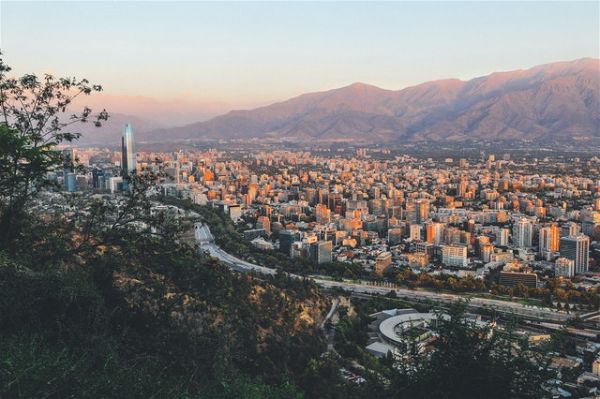
The Best Time To Visit Argentina
October to December, in the spring months, and April to June are the perfect months to explore the city of Buenos Aires and the wine country of Mendoza and Maipu, and Iguazu Falls , as the sun is shining, rain is light, and the temperature is comfortable, making for perfect travels outdoors.
However, December to April, during the much hotter summer months, are also a great time to visit as the locals in Buenos Aires and Mendoza travel south, to the Lake District and Patagonia, leaving Buenos Aires, Cordoba, and Mendoza much emptier for you to explore on your own. At the same time, expect much larger crowds in the south, in Patagonia and the Lake Districts, as vacationing Portenos travel down to Bariloche and around.
The Best Time To Visit Peru
June to August is the best time to experience Peru’s hiking and trekking highlights – Machu Picchu, the Inca Trail the Salkantay Trek Colca Canyon, and Lake Titicaca – as the climate will be drier (conducive to the rocky and potentially muddy trails).

In the wetter seasons of April to October, Peru’s coastline receives very little rain making the beaches and coastal cities, like the big city of Lima or the beach city of Mancora, a pleasure.
The Best Time To Visit Bolivia
May to October is the best time to visit Bolivia, as these are the reliably dry months.
Most of the travel in Bolivia is adventures, whether taking a 4×4 tour out to the salt flats, hiking, or mountain biking down the most dangerous road in the world, having a dry path to explore on can make the difference between a pleasant experience, or a miserable one.
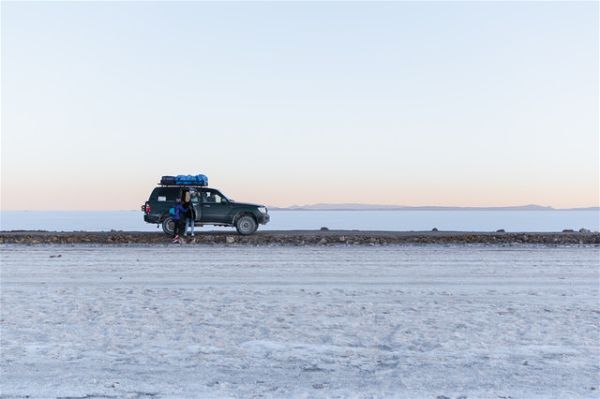
In contrast the, the wet season makes for boggy salt flats, muddy roads in the middle of nowhere, and eliminates the chance to do most of the highlights of Bolivia. Do yourself a favor and aim for Bolivia’s dry season
The Best Time To Visit Ecuador
May, June, and July are the best months to visit Ecuador, towards the close of the rainy season. At this time, hikes and outdoor adventures are easier, up mountains and volcanoes, are more pleasant, while animals that show themselves more often in the rainy season are still out and about.
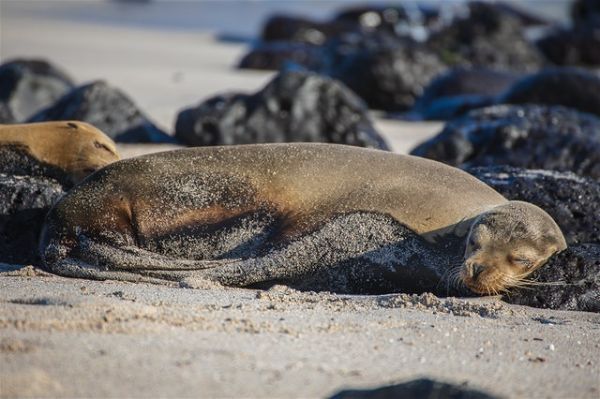
For Galapagos, plan your visit around the specific animals you want to see as species of animals leave and return to the island to follow migrating food, as well as whether you want to see mating rituals or pups/hatchlings.
The Best Time To Visit Colombia
July and August or December in January are the best months to visit Colombia, as these months have the lightest rainfall of the year.
However, temperatures in Colombia stay steadily comfortable year round and rains are brief, making virtually any month a great time to visit Colombia
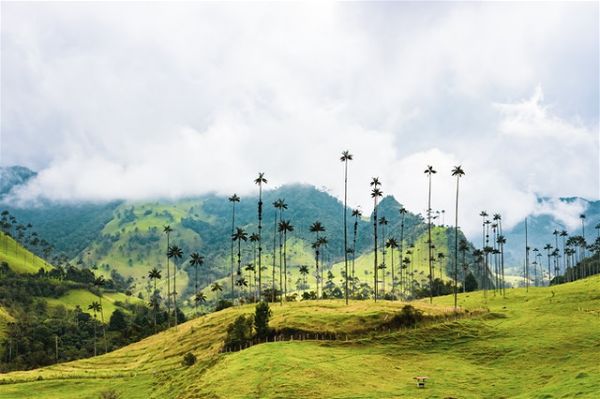
Expect temperatures of 75 degrees to 85 degrees year-round, with temperatures dropping the higher you go.
Best Time to Visit Uruguay
October to March is the best period to experience this tiny, green, coastal country that experiences the same clear skies as Buenos Aires during the South American summers, but with the cooler temperatures of a coastal climate.
The Best Time To Go To Antarctica
The best time to visit Antarctica is the southern hemisphere’s summer season, of November to February. Though this is the high season for tourists traveling to Antarctica, this is when animals are most active in Antarctica, maximizing this once-in-a-lifetime experience.
The Best Times to Visit the Major Destinations in South America
In terms of temperature and weather, October to December (spring time) and December to February (summertime) and the beginning of autumn (February and March) are the best months to experience Patagonia, exploring the outdoors.
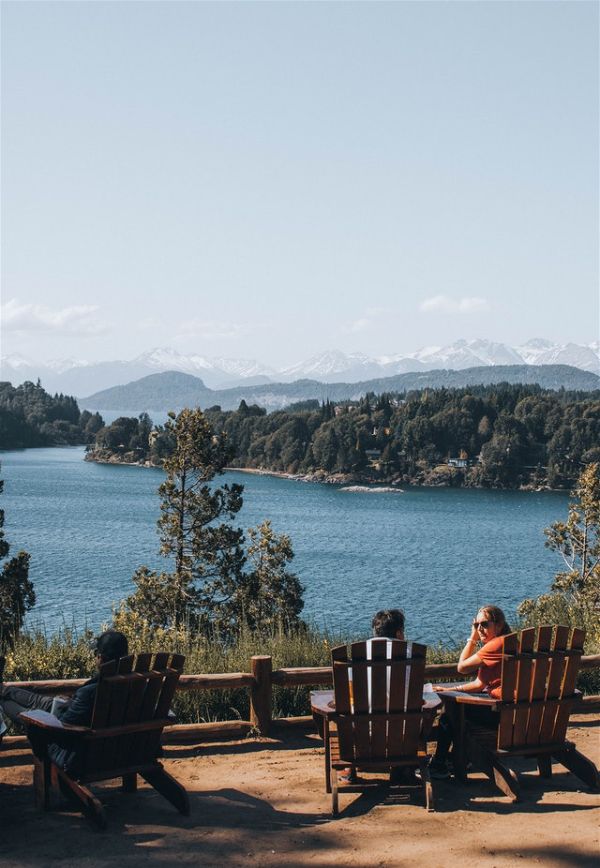
Expect for the popular attractions, such as the Perito Moreno Glacier and Torres del Paine National Park, to be packed with tourists, both international travelers and Argentines/Chileans on extended summer holidays.
Experience the best of great, cool weather and thin crowds by aiming for the end of summer (February) and autumn (February and March)
June to August are the best months to experience the high altitude jungle and ruins of Machu Picchu as well as the epic paths to get there – the Inca Trail and the Salkantay Trail – as this is the driest season for the region.
Because the optimal trekking season is short for these popular attractions, plan on booking your accommodation, tours, and tickets well in advance, aim for weeks in advance for Machu Picchu and months in advance for the popular treks.
The Atacama Desert is a high altitude desert moonscape that is known for its otherworldly views, amazingly clear night skies, and intensely dry landscapes. As such, almost any time of year it is possible to visit Atacama and have a great experience. But, planning around low tourist season, to avoid extremely high prices and crowded tours, and well as planning around popup storms and potential road closures is smart.
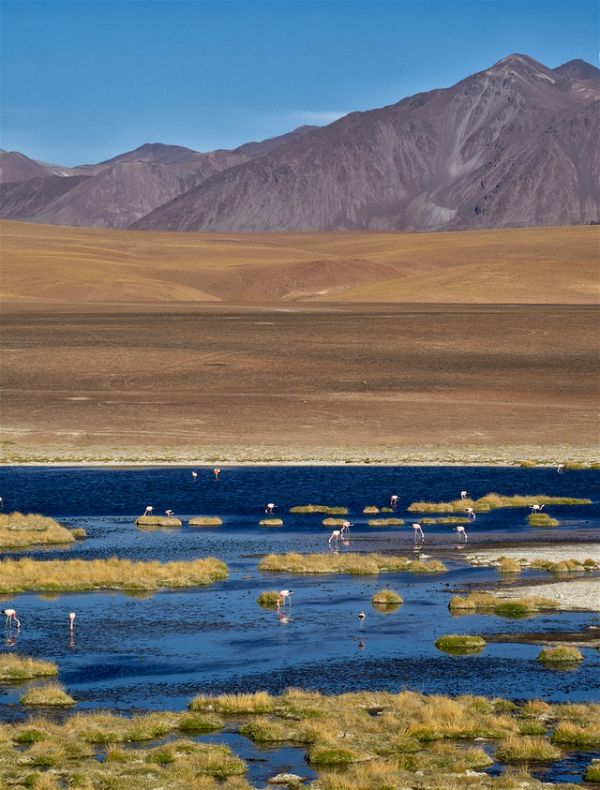
The Atacama desert, accommodation, and tours will likely be one of your most expensive experiences in South America due to popularity, Do yourself a favor and aim for the Atacama Desert’s shoulder season for tourism from September to November (spring) and from March to May (fall) when temperatures are enjoyable, crowds are thin.
Additionally, though the Atacama desert is notoriously dry, the winter months of June to August bring winter storms at night which cloud the starry you’ll plan to be in the Atacama for. Also, the mountain roads leading up to Atacama from the Argentine side tend to be closed more often in the winter months with little notice – meaning your long haul bus may turn back to its destination after an eight hour ride.
To save money and get the best of everything, aim for the spring and fall seasons in the Atacama Desert.
Bolivian Altiplano and Salt Flats: May to October
Traveling in the dry winter months of May to October guarantees that your adventures by road in the Bolivian altiplano won’t be disrupted by mud-covered and washed out roads.

Bolivia is one of the wildest feeling countries in South America, with vast stretches of rough road through high altitude desert landscape. Roads that are adventurous and dusty in the dry season become muddy and impassible for vans and cars in the wet season, and still risky even for 4×4’s. Save yourself the risk and headache by aiming for Bolivia’s winter and cool dry season of May to October.
July to December is the Rainforest dry season, making the situation better for hiking while the water levels are low, and you’ll experience clear skies.
During the rainy season of January to July, the water levels will be higher, making for great boat tours and full rivers, and you’ll be more likely to sea animals.
However, expect warmer temperatures, 77 to 87 Farenheit, year round throughout the Amazon
Galapagos Islands
Your trip to the Galapagos Islands should be planned around the particular animals you would like to see and in what phase. Each animal indigenous to the Galapagos Islands – penguins, hammerhead sharks, marine iguanas, Blue Footed boobies – all migrate between islands and away from islands to follow their food of choice. Timing your trip based on the migratory pattern of your target animal makes a fulfilling trip more likely.
Additionally, each species nests/mates/hatches/nurtures on a very specific calendar, so, if you would like to see the mating ritual or hatchling of a specific animal, a little advanced planning will make the experience much more likely.
The Galapagos Islands’ heaviest rainfall is from December to April, however the showers are quite brief and won’t disrupt your explorations – on land or sea – much.
Iguazu Falls
April to May and September to October are the best months for mild weather, not as hot and little rain, and avoiding crowds in Iguazu.
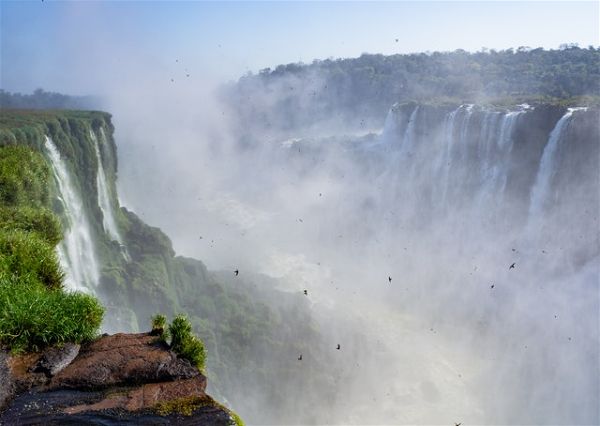
The Lost City (Ciudad Perdida)
December to early March is the best time to make the 4 trek to La Ciudad Perdida, during the Colombian dry season. Because most of the hike will be through rough jungle, you will want to go during the dry season when the rain is less likely, or limited to ~2pm or later each day, and the rivers are much lower due to lack of rain.
- Carnival (Feb/Mar – One week before lent) – a legendary festival, best expereinces in Rio or Salvador in Brazil or Baranquilla in Colombia
- San Antonio de Areco (November 10): Festival of the Gauchos in Argentina:
- Inti Raymi (June 24): Incan festival that takes place on the winter solstice and lasts for 9 days
Bottom Line: South America Is A Year Round Destination
South America is vast and varied, stretching through both hemispheres with activities indoors, outdoors, active, and relaxing throughout. No matter when you want to travel to South America, there is most definitely somewhere at its peak enjoyability waiting for you, so just pack your bag and get going ASAP!
Where to first? Our guide to the best South America Routes, Itineraries, and Destinations
Now that you know when to go to South America, let’s help you decide where to go.
Click here to see the 9 best South America routes, perfectly planned and timed for your ideal adventure
DON’T FORGET THE TRAVEL INSURANCE #
FAQs About the Best Time to Visit to and Travel South America
When is best time to visit south america, where should i go in south america and why.
Where you should go in South America depends on your tastes and interests. If you love the outdoors and adventure, Patagonia, Torres Del Pain, the Bolivian Altilplano, and the Galapagos Islands are essential. If you enjoy cities, Buenos Aires, Lima, and Medellin are best. If you love food an wine, Mendoza, Argentina and the Casablanca Valley are excellent for wine, while Lima is the best food destination in South America.
Which is the best season to visit South America?
Visiting and travel: how early should i book a flight to get the cheapest fares.
Minimum one month in advance is the optimal booking period before a flight to Argentina in order to save the most money.
- Decide on how much time you have
- Decide on your budget, minus flights in and out, and divide that into a daily budget
- Review this list of countries and highlights, and visit our country specific guides and itineraries to get a better feel for each country, then list your “must-see” locations and attractions, also keeping in mind the places you can do without
- Decide your start and end points, with your start point being solid and your endpoint being fairly flexible
- Draw your rough route
- Dot your destinations along the way
- Plan the number of days you’ll need for each destination and experience, add in 1 to 2 days per week as downtime with no travel or specific exploration, then add them up to ensure they’ll fit your timeline and budget (i.e., time to bus between locations if flights are too expensive)
- Adjust your itinerary as necessary
- Understand that staying flexible is best as you will discover places and people that your timeline is worth changing for
OTHER GREAT ARTICLES ABOUT TRAVELING THE WORLD
- 11 Reasons why Buenos Aires is the perfect city for a long stay
- 9 Epic South America Backpacking Routes + An itinerary for every schedule
- 5 Essential Routes for Backpacking the World and Visiting Every Continent
- The Balkan Walk: The Perfect Backpacking Itinerary for the Balkans
- 3 Months in Southeast Asia: A Perfect Plan for the the “Banana Pancake Trail”
- The Mini Backpacking Trails: 15 Itineraries Aroudn the World for 2 Weeks or Less
- The 10 Day Middle East Itinerary
(Click here to return to the Table of Contents)
More Great Articles to Help You Get Abroad:
- The Ultimate Malaysia Digital Nomad Visa Guide
- Moving to Malaysia: A Complete Guide
- Moving to Bali: A complete guide for digital nomads and aspiring expats
- The New Thailand Visa Exemption: Everything You Need to Know
- The New Bali Digital Nomad Visa and 5 Other Options: A Complete Guide
- Buying a House on Bali: A Complete Guide to Cheap, Easy Home Ownership in Bali
- The 51 Best Digital Nomad Jobs among Successful Nomads
- 9 Epic South America Backpacking Routes
- Backpacking the World…2 Weeks at a Time
- Is Geoarbitrage for You? An Ultimate Guide to Living Better for Cheaper as a as a Nomad

ABOUT THE AUTHOR
Carlos is a nomad, slow traveler, and writer dedicated to helping others live abroad and travel better by using his 7+ years of experience living abroad and background as a management consultant and financial advisor to help other nomad and expats plot better paths for an international lifestyle. Click here to learn more about Carlos's story.
- Compare Flights & Hotels via TRAVELDESCRIBE
- Find Cheap Flights via Skyscanner
- Find Hotels via Booking.com
- Find Hostels via Hostelworld
- Rent a Car via Discover Cars
- Find Trains & Buses via Omio
- Book taxi Transfers via KiwiTaxi
- Find Things to Do via Viator
- Find Ticket Deals via GetYourGuide
- Find Travel Insurance via Insubuy
- Destinations
- Places to Go
- Things to Do in 2024
- Deals & Discounts
- North America
- South America
- Cheap Flights in 2024
- Top Hotels and Resorts in 2024
- In February
- In September
- In November
- In December
- World’s Best Places to Visit
- Best Countries to Visit in 2024
- Travel Tips

- Inspiration
- Things to Do
- Budget Travel

- Cheap Flights
- Hotels & Resorts
- Travel Guides
Best time to Visit Colombia

If you’re looking for the best time to visit Colombia, it’s important to consider what season is best for your travel plans. There are two main seasons in Colombia, one of which is the wet season and the other is the busy holiday season. For each season, there are several factors to consider, including the weather, crowds, and other factors.
Best Time to Go to Colombia
While Colombia is a year-round destination , the best time to visit depends on your preferences and bucket list activities. If you’d like to experience a wide variety of seasonal activities and attend some of the annual festivals, spring is the perfect time to visit Colombia . Below is a breakdown of the seasons and how they affect your experience. Winter months are busy, especially with European travelers seeking to escape colder temperatures. However, winter is also a very dry time in Colombia with little to no rain.
December-March : This period is dry in Colombia, making it the best time to visit. The Andes and Amazon are at their driest during this time. However, December to February are busy travel times, and prices will increase. For the northern coast, you should book your trip in advance to avoid crowds and expensive accommodations.
Summer and autumn : These months are characterized by sunny skies and less rain. December to March is considered the dry season in Colombia, but the wettest time is May and October. Generally, temperatures in Colombia range from 19 to 27 degrees Celsius. Regardless of the season, it’s always best to pack a jacket and sunglasses for comfort. If you’re not sure about the weather in Colombia, check the weather forecast at WeatherSpark to determine the best time to visit.
Despite Colombia’s tropical climate, spring and autumn can also be cold. The Andes mountains cut through much of the country. As a result, many cities in the country are mountainous, and altitude influences the temperature. The higher you are, the more extreme the swing between daytime and nighttime temperatures will be. The temperatures in Medellin , for example, are typically in the mid-70s to low-80s F, with lows in the 60s at night. You’ll want to bring a lightweight jacket or a light sweater to keep warm.
Summer is the most popular time to visit Colombia for many reasons. The Caribbean coast and Tayrona National Park are both beautiful during this season, and you can hike in the Sierra Nevada Mountains. For a more rural experience, try a trip to the island of Mompox, a colonial town located a few hours from Cartagena.
Summer is the best time to visit Colombia because the country enjoys long, sunny days and a warm climate. You will also find less tourist traffic, which makes it possible to get a lower rate on accommodations and flights . Colombia also has a long holiday season, which includes several days off for locals and foreigners.
The dry season lasts from December to March, and rainfall is generally low. However, the rainy season is from April to November, with May and October seeing the most rainfall. Temperatures in Colombia typically range from 19-27 degC. If you’re planning a trip during this time, remember to pack a light jacket, sunglasses, and sunscreen. Check the weather forecast before your trip to ensure you’re ready for the Colombian weather.
The Caribbean coast and the Altiplano regions of the country are still quite pleasant during summer, but you’ll need to pack a raincoat in case of afternoon showers. The Amazon region also sees high rainfall, though rain tends to be short and warm. However, if you’re visiting the country’s rainforests, summer is the best time to visit.
If you’re planning a trip to Colombia, you’ll want to visit during the winter. It’s cooler, but still warm enough to enjoy the city’s festive atmosphere. The country celebrates Christmas in style, and there are big parties throughout the month. While New Year’s Eve in Bogota can be a bit chilly, the rest of December is very warm, and the weather remains pleasant.
While the weather in the Caribbean coast is typically warm year-round, you’ll want to be prepared for rain. From May to November, the Caribbean coast sees a marked increase in rain, though it tends to be short and mild. Likewise, the Amazon rainforest experiences high rainfall and fairly warm temperatures throughout the year, though temperatures decrease as you head higher. In San Agustin, the weather is slightly different. The first half of July and August are the driest months. In addition, the Caribbean Islands are dry until May.
While December to March is Colombia’s high season, the rainy season runs from April to November. These months are considered the best time to visit the country. During this time, temperatures are stable, although the higher parts can get chilly at night. Be sure to bring plenty of warm clothing and sunglasses to stay comfortable. For detailed weather information, visit WeatherSpark.com. This website has information on rainfall, temperature, and humidity, as well as other useful information. In winter, you can experience the best weather, while avoiding crowds. The rainy season is also the least expensive time to visit Colombia.
Winter is the best time to visit Colombia if you like the cold weather and are not afraid of rain. There are many traditional holidays and events held during the winter in Colombia. In Barranquilla, a large festival is celebrated, comparable to Brazil’s Carnival.
Show more Show less
COLOMBIA TOURS & ACTIVITIES
When is the Best Time to Visit Colombia? – Month by Month Guide
There are many different seasons in Colombia. You can visit the country in January, February, March, or April. You’ll want to avoid the rainy season in order to get the best deals. The rainy season is also a time when hotels and transportation can be expensive. It is recommended to make your reservations in advance to get the best rates.
Visiting Colombia in January
Visiting Colombia in January is the perfect time to visit the country’s lush rainforests and pristine beaches. This South American country is situated in a secluded insular area on the southern coast of North America, bordering the Caribbean Sea on the north, Venezuela on the east, and Ecuador, Peru, and Brazil to the south. To the west, Colombia borders the Pacific Ocean and Panama.
The holiday season in Colombia is alive with festivities and holiday celebrations. The holiday season usually starts in the middle of the month, with many destinations offering spectacular light displays and street parades. While in the country, tourists can enjoy warm temperatures in the coffee-growing region and on the beaches of Santa Marta and Providencia. A number of other traditions take place in the country as well, including bullfighting displays and sporting activities.
Visiting Colombia in February
Colombia is a country in South America and is an insular region in North America. It borders the Caribbean Sea to the north, Venezuela to the east, Brazil to the southeast, Ecuador and Peru to the south, and the Pacific Ocean to the west. It is the largest country in South America and is home to the largest metropolitan area, Bogota.
The climate in Colombia during February is ideal for outdoor activities. You can visit Colombia’s coffee-growing region, the Cocora Valley, and go white-water rafting in the Caqueta Department. If you’re adventurous, you can accompany former FARC guerrillas as they raft through Class III and IV rapids. And don’t forget about the rich culture and history of the country, which can be best experienced in February.
The climate of Colombia is tropical in most regions, with temperatures reaching up to 86degF year-round in coastal areas. In contrast, the higher altitudes experience colder winters. The dry season runs from December to March, with temperatures ranging between 19degC and 27degC. Regardless of where you visit, it’s always wise to pack a light jacket, sunscreen, and sunglasses. The weather in Colombia can be unpredictable, so it’s important to research your destination and plan accordingly.
Visiting Colombia in March
Visiting Colombia in March is a great time to visit the country, as it is outside of peak travel season, meaning fares are lower and hotel fees are lower as well. However, it is important to note that this month also coincides with Holy Week, during which the local population is more prone to vacationing, making reservations far in advance a good idea.
The weather in Colombia is temperate all year round, but December to March is the driest season. Visiting during this time of year is a great way to enjoy the country’s varied landscape, city-wide celebrations, and outdoor activities. Visiting Colombia during these months is also a great idea if you’re planning to visit the Andes, which experience dry weather throughout the country’s dry season.
In March, the weather is perfect for cycling in Colombia’s coffee country and Central Andes. You’ll be able to enjoy the scenic views and the lush plains and get a great workout at the same time. You’ll also be able to experience the local culture, filtered through colonial towns, and tangible heritage emerging from the wilderness. With so much to see and do in Colombia, it’s important to know what to expect.
Visiting Colombia in April
If you’re planning a vacation to Colombia, there are many things to consider when choosing a time to travel. The country is located in South America but has an insular region that borders the Caribbean Sea to the north and the Pacific Ocean to the east. It’s also bordered by Venezuela to the north, Brazil to the east, Ecuador and Peru to the south, and Panama to the northwest.
Spring in Colombia offers milder temperatures than the summer, making it ideal for visiting the country’s beaches. The Pacific coast is ideal for swimming, and fewer tourists will be crowded. You can also see the end of the humpback whale migration along the Pacific coast. Rainfall on the Caribbean coast is heavier, but typically occurs in the afternoons.
Visiting Colombia in April offers warm temperatures, making it a great time to visit the Caribbean coast, the mountains, and islands. You can also visit the Coffee Country and see where coffee is grown. Visiting Colombia in April also allows you to take a trip to Mompox, a colonial town located on an island in the River Magdalena.
Visiting Colombia in May
Visiting Colombia in May is a great way to see the country’s beautiful landscapes and warm temperatures. The country borders the Caribbean Sea to the north and Venezuela to the east, and Ecuador, Peru, and Brazil to the south. To the west, Colombia borders the Pacific Ocean and Panama. You can’t miss the country’s vibrant nightlife, stunning beaches, and delicious cuisine.
If you’re traveling to Colombia in May, don’t forget to visit the country’s national parks. The country’s national parks have their own official websites. Visiting Colombia during this season will allow you to see whales in the Pacific, but you won’t see the fall colors here. The country’s national parks and other attractions are not overly crowded, making it a great time to visit.
If you’re visiting Colombia in May, make sure to make travel plans in advance. The rainy season can lead to higher prices for travel and accommodations. You should also plan to avoid the Carnavales del Fuego, the country’s largest carnival, which draws more than a million people every year. Visiting Colombia in May also means the coffee harvest is in full swing. You can also experience the country’s cultural heritage in more traditional towns during this time. For example, Mompox, a colonial town, is a few hours away from Cartagena.
Visiting Colombia in June
Visiting Colombia in June is a perfect time to see the country’s vibrant culture and breathtaking scenery. The country is located on the Caribbean Sea in the north and borders Venezuela, the Caribbean Sea in the east, the Pacific Ocean to the west, and Ecuador, Peru, and Panama to the northwest. It has warm tropical climates and a wide variety of outdoor activities.
Colombia has two distinct seasons with uniform temperatures and varied rainfall. The dry season occurs from December to March and the wet season lasts from April to November. Cartagena, which lies close to the equator, is the most popular destination in June. However, if you are worried about safety, don’t worry; Colombia is a relatively safe country.
June is the start of the tourist season in Colombia, so prices will be slightly higher. Visiting the country’s national parks is not more expensive during this period, but lodging will be pricier. In addition, some hotels will require a minimum stay of two nights.
Visiting Colombia in July
Colombia is a country in South America. This insular nation shares borders with Venezuela to the north, the Caribbean Sea to the east, Ecuador and Peru to the south, and the Pacific Ocean to the west. It has many attractions to offer travelers, from the vibrant culture to the scenic beauty. Visiting Colombia in July is a great way to experience the country’s varied scenery.
July is the country’s high season, so it can get busy and expensive in the more popular cities. However, smaller towns and coastal areas will be less crowded. The country is characterized by several notable events during the month of July, including Independence Day, which commemorates Colombia’s independence from Spain. This event started in 1810 with a political uprising in Bogota.
Bogota, Colombia’s historic capital, is a lively city with plenty to see. It’s also home to the world’s largest collection of South American gold artifacts. A cable car will take tourists to the peak of Cerro Monserrate, a volcano near the city.
Visiting Colombia in August
Visiting Colombia in August is one of the best times to see the country. The weather is warm and the sun shines throughout the day. The country is also popular for its abundant wildlife. There are many things to do in Colombia during this month. Whether you want to relax in the sunshine or enjoy the culture, it is a fantastic place to visit .
August is a good time to visit Colombia as it is not as touristy as other months of the year. However, if you plan on visiting a popular attraction, you will need to plan your trip around these days. Popular destinations are usually crowded. You may find it difficult to book your flights or accommodations at the last minute. Check out Colombia-sa’s website for information about public holidays and school vacations in order to plan your trip accordingly.
In addition to being a good time to visit Colombia, you can also attend a festival or two during this month. The most popular festival is the Carnaval of Barranquilla, the second-largest carnival celebration in the world. Visiting Colombia during this month will allow you to enjoy the vibrant city’s nightlife. Also, make sure to visit the island of San Andres during this time, where the water is turquoise and the air is warm.
Visiting Colombia in September
Visiting Colombia in September is the perfect time to experience the country’s beautiful fall colors. The country is nestled between the Caribbean Sea and the Pacific Ocean, bordering Venezuela to the north, the Caribbean Sea to the east, and the Pacific Ocean to the south and west. It is the largest country in South America and is the most populous.
While Colombia is less touristy than other parts of South America, some parts of the country remain touristy. However, there are many events held throughout the country, and the Colombians know how to party. The best time to visit is during the month of September, which is a great time to enjoy the country’s attractions and festivities.
September in Colombia is a great time to visit, as the temperatures are uniform throughout the country and no region is too hot or too cold. During this time, you’ll be able to enjoy some of the country’s famous sites without the crowds, as well as take advantage of many seasonal activities and events.
Visiting Colombia in October
Visiting Colombia in October is one of the best times to visit this fascinating country. The weather during October in Colombia is warm and the fall foliage is colorful. This South American country is bordered by the Pacific Ocean, the Caribbean Sea and the southwestern part of the country borders Venezuela, Ecuador, Peru, and the Pacific Ocean.
Colombia has two main seasons: the dry season and the wet season. The dry season lasts from December to March. There are many holidays during this time of year and temperatures are comfortable. Visiting Colombia in October is a great way to experience the country in its most peaceful and relaxed state. You can enjoy the best of nature during this time, with low temperatures and less tourism.
Visiting Colombia in October is the best time to visit Colombia, but you should plan your trip accordingly. While the country has a dry season from December to March, it also experiences the rainy season during the months of July and August. The climate varies depending on the region and the altitude of the country. Some regions experience constant temperatures throughout the year, while the high-altitude areas experience a more tropical climate. The city of Medellin, for example, has a dry climate and spring-like temperatures.
Visiting Colombia in November
The country of Colombia is situated in South America and occupies an insular area of North America. Its borders include the Pacific Ocean to the west and the Caribbean Sea to the north. On the other side, it shares borders with Brazil, Ecuador, Peru, and Venezuela. The country has a population of over 22 million people.
During the month of November, the weather in the southern part of the country is warm and pleasant. In southern Colombia, you will find the city of Cartagena with its beautiful beaches and world-class surf. During November, the Cano Cristales River turns into a liquid rainbow as it flows through the Serrania de la Macarena mountains.
Colombia is one of the best countries to visit in November for its mild climate and beautiful beaches. The country has two coastlines, the Pacific and the Caribbean, with Caribbean side waters being warmer than the Pacific side. The beaches of Cartagena and Santa Marta are also popular beaches.
Visiting Colombia in December
Visiting Colombia in December is a great time to visit the country and experience its festive atmosphere. The country is surrounded by the Caribbean Sea to the north, the insular region of North America to the east, and the Pacific Ocean to the west and northwest. Its borders are many, with the Caribbean Sea on the north, the Caribbean Sea to the east, Venezuela to the south, Ecuador to the southeast, and Peru to the south.
Colombians celebrate Christmas and New Year in December, which means there is plenty of partying and holiday celebrations to keep you busy. December is the start of the holiday season in Colombia, and cities like Medellin are known for their spectacular light displays and street parades. Other popular cities include Santa Marta, where tropical temperatures and warm climates make it a popular tourist destination during the holidays. Other great destinations include Providencia island, where Christmas celebrations are particularly lively, and San Andres Island, where you can enjoy the aquamarine waters and festive mood.
Visiting Colombia in December is the best time to visit the country. While the weather in the country is usually warm and humid, December’s dry season makes it the perfect time for backpacking and hiking tours. Rainfall decreases drastically across the country, making it a great time for tourists to visit the Andes. In contrast, the Amazon region remains relatively humid throughout the year.
COLOMBIA DEALS & DISCOUNTS
Best time to Go Hiking in Colombia
January is a perfect time to go hiking in Colombia. The trails are dry and the skies are clear, which means you can enjoy the views from the loftiest peaks. Bogota is deserted during this time of year, and you can even find secluded eco-lodges along the Pacific coast.
The rainforest covers over 35% of Colombia, and the region is home to numerous wildlife. If you are looking for a nature-focused adventure, or want to see Colombia’s indigenous tribes, this region is the place to go. Many of the trails are accessible from the city of Medellin, and the views from these trails are among the most amazing in the country.
If you’re planning on hiking in the Andes or Amazon, it’s best to avoid June through August. These months are the driest time of year and are also popular with tourists. However, make sure to book your accommodation early, especially if you plan to stay in boutique hotels.
There are three seasons to consider when traveling to Colombia. Winter is dry, while summer is warm. December to March is the driest month, with temperatures ranging from 15degC to 27degC. From April to September, you’ll find temperatures between 66degC and 23degC. You should also consider October and November as the rainy seasons, but remember that if you visit Colombia during these months, temperatures will be lower than during the other seasons.
Cheapest time to visit Colombia
The country offers a wealth of natural beauty, from lush rainforests to stunning rugged mountains. Its urban centers are cosmopolitan yet retain a rich historical past. Bogota, Colombia’s capital city, blends contemporary skyscrapers and colonial architecture. Other cities of note include Cartagena de Indias, the Caribbean city, and Cali, Latin America’s salsa capital.
Traveling to Colombia can be cheaper during certain periods of the year. For example, December to March is dry in the Andes, while September to November is rainy. Traveling to Colombia during these times will keep airfare costs down. However, it’s important to get travel insurance, as it may prove essential for your safety.
Depending on your budget and interests, you can choose from three main seasons: summer, winter, and shoulder seasons. However, it’s important to remember that high season coincides with huge price increases and reduced availability of flights and tours. Besides, flights during this time are often booked months in advance. Also, travel to Colombia during holidays can be hectic, so keep that in mind when planning your trip.
If you’re looking to avoid crowds, you can visit Colombia during shoulder seasons. There are plenty of discounts during shoulder seasons, as the country has less tourist traffic and fewer prices. Popular tourist destinations are crowded during high season, while they’re virtually empty on weekdays. Travelers to Colombia can also enjoy cheaper prices and less crowded conditions in October and November.
Map of Colombia
Exclusive Flight & Hotel offers.
Colombia Weather
To be updated with all the latest Travel Guides & News, offers and special announcements.
Discover the Perfect Season: Best Time to Visit Medellin for Unforgettable Experiences
Best Time to Go to Haulover Beach: A Relaxing Escape for Everyone
Best Time to Visit Bahrain
A Complete Travel Guide to Rhodes, Greece in 2024
A Complete Travel Guide to Venice, Italy in 2024
A Complete Travel Guide to Milan, Italy in 2024
With TravelDescribe.com you’ll get low prices and flexible booking options. Search and book now. Never miss a cheap flight or accommodation deal again.
The cheapest flights with the best offers,deals and to get your trip going your own way, you can find them at Aviasales, Trip.com, CheapFly365 and Skyscanner.
If you want to enjoy your stay and feel like home, you can find out exactly what you're looking for at Hostelworld, Booking.com, and Hotellook. You will certain get the best prices for your accommodation.
If you choose to have the best guidance for your trip, then Viator, Get Your Guide and TripAdvisor are what you' re looking for. You will find all the suggestions for activities, food, drinks and entertainment.
A great choice, if you want to be informed and get online tickets for your trip, is Omio, 12Go and KiwiTaxi.
You can trust the Discover Cars for your ideal transportation.
Insubuy is a great choice if you want to get the best insurance for your trip.

It may be difficult to decide which is the best destination for you, but the TravelDescribe will keep you on track. Here's how to make your trip even easier. There are many free online resources that can help you plan your dreamy trip and make the experience more enjoyable. TravelDescribe.com will always keep you up to date about the cheapest flights and hotels in the World. The best travel guide by my experience as a World Traveler.
- Cookie Policy
- Terms and Conditions
- Affiliate Disclaimer
- Advertise with Us
Travel to Iceland – The Ultimate Iceland Travel Guide in 2024
Travel to Brazil – The Ultimate Brazil Travel Guide in 2024
Travel to Libya – The Ultimate Libya Travel Guide in 2024
Travel to India – The Ultimate India Travel Guide in 2024
Travel to Mexico – The Ultimate Mexico Travel Guide in 2024
© 2023 TRAVELDESCRIBE.COM. All Rights Reserved.
Privacy Overview

The Best Time to Visit South America: A Comprehensive Travel Guide
The Best Time to Travel to South America: A Comprehensive Guide to Understand When to Visit Each Country
Whether you’re drawn to the lush rainforests of the Amazon, the breathtaking heights of the Andes, or the vibrant rhythms of Brazilian carnivals, South America has every type of adventure and every climate you could imagine. Since South America is such a vast continent, each country comes with its own unique climate and charm, making the timing of your trip a crucial factor for an optimal experience. This is a comprehensive guide to help you decide when to visit each country in South America. For each country, this guide covers the high season, shoulder seasons, and low season, the climate, traveling during summer, fall, winter, spring, and the best destinations to visit during each season. Our hope is that this guide ensures that your exploration aligns perfectly with the local seasons and festivities.
Use the links below to jump to each country!
The Best Time to Travel to Argentina
The best time to visit Argentina largely depends on your interests and the experiences you’re seeking. Given the country’s diverse climate and geography, different regions shine at different times of the year. Here’s a general overview of Argentina’s climate the best time of year to visit each region, and the best places to visit Argentina in each season:
High Season, Shoulder Season, and Low Season in Argentina:
High Season (December to February):
- Why: The high season in Argentina falls during the Southern Hemisphere summer, making it perfect for enjoying outdoor activities, beaches, and festivals.
Shoulder Season (March to May, September to November):
- Why: During shoulder seasons, the weather is still pleasant, but the crowds are thinner, allowing you to explore popular attractions without the hustle and bustle of peak tourists.
Low Season (June to August):
- Why: Low season is ideal for ski enthusiasts as Patagonia offers great skiing opportunities. Additionally, the stunning landscapes of Patagonia are less crowded, providing a serene experience.
Whether you’re seeking sunny summer escapades, moderate weather with fewer crowds, or winter wonderlands, Argentina offers unique experiences in each season.
The Climate in Argentina
Argentina has a diverse climate due to its vast geographical expanse and varying topography. The country’s climate ranges from subtropical in the north to subpolar in the far south. Here’s a general overview of the climate zones in different regions of Argentina:
- Northwest Argentina: The northwest region, including places like Salta and Jujuy, features a subtropical highland climate. Summers are warm and humid, while winters are mild and dry. The region experiences a pronounced rainy season during the summer months.
- Northeast Argentina: The northeast region, which includes provinces like Misiones and Corrientes, has a subtropical climate with hot and humid summers and milder winters. Rainfall is abundant throughout the year, with a wetter period during the summer months.
- Pampas: The central Pampas region, where major cities like Buenos Aires are located, experiences a temperate climate with distinct seasons. Summers are warm to hot, while winters are mild with occasional cold spells. Rainfall is fairly evenly distributed throughout the year.
- Cuyo : The Cuyo region, encompassing provinces like Mendoza and San Juan, has a desert or semi-arid climate. Summers are hot and dry, while winters are cooler and more pleasant. Irrigation is essential for agriculture in this region.
- Patagonia Argentina: Southern Argentina, including Patagonia, has a wide range of climates due to its vastness. In general, the western part experiences a cold desert climate with very little rainfall, while the eastern part near the coast has a subpolar climate with cold winters and relatively cool summers. The Andes mountains also influence climate variations in this region.
- Tierra del Fuego: This far southern region, including Ushuaia, has a subpolar climate characterized by cold temperatures throughout the year. Winters are especially cold and snowy, while summers are relatively cool.
Traveling During Each Season in Argentina
In general, there are four main seasons in Argentina:
- Summer in Argentina (December to February):
- Fall in Argentina (March to May):
- Winter in Argentina (June to August):
- Spring in Argentina (September to November):
Summer in Argentina (December – February):
During the summer months in Argentina, which correspond to December through February, the country experiences warm to hot temperatures in most regions. Northern areas, like the provinces of Misiones and Corrientes, can become quite humid with temperatures often exceeding 90°F (32°C). The central Pampas region, including Buenos Aires, also sees warm and humid weather with occasional heatwaves. Patagonia experiences relatively milder temperatures, making it a popular destination to escape the summer heat. Coastal areas such as Mar del Plata attract beachgoers during this time. Additionally, the northwest region, including Salta and Jujuy, offers pleasant weather for exploring the mountains and enjoying outdoor activities.
Fall in Argentina (March – May):
Autumn in Argentina, from March to May, brings milder temperatures and more comfortable weather. The central Pampas region experiences pleasantly warm days and cooler nights, making it an ideal time to explore cities like Buenos Aires and the surrounding countryside. The vineyards of Mendoza in the Cuyo region are a major attraction during this season as the grape harvest takes place. The northeastern provinces of Misiones and Corrientes continue to enjoy warm days but with decreasing humidity. Patagonia starts to cool down during fall, making it a good time for hiking and outdoor adventures in its stunning landscapes.
Winter in Argentina (June – August):
Winter in Argentina falls between June and August. Northern regions experience mild winters with temperatures ranging from 50°F to 70°F (10°C to 21°C). Buenos Aires and the central Pampas region have cooler temperatures, with occasional cold snaps. The ski resorts in the Andes, such as Bariloche and Chapelco, come alive during this season, attracting winter sports enthusiasts from around the world. Patagonia experiences colder temperatures and snowfall, making it a great time for skiing and snowboarding. The southernmost region of Tierra del Fuego is extremely cold, with Ushuaia often covered in snow.
Spring in Argentina (September – November):
Spring in Argentina spans from September to November. The central Pampas region and Buenos Aires begin to warm up, with pleasant temperatures and blossoming flowers. It’s an excellent time to visit the parks and gardens in the cities. The northwest region experiences a transition from the rainy season to drier conditions, making it a suitable time for outdoor activities. Patagonia sees a gradual thaw, making it a unique time to witness the transformation from winter to spring. Whale watching along the coast of Peninsula Valdés in Patagonia has become a popular activity as well.
Some of the Best Places to Visit in Argentina During Each Season:
Summer (December – February):
- Bariloche and the Lake District: Enjoy outdoor activities like hiking, kayaking, and sailing in the stunning lake-filled landscapes.
- Mar del Plata: One of Argentina’s most popular beach destinations, perfect for sunbathing and water sports.
- Iguazu Falls: Witness the majestic waterfalls in their full glory amidst the lush rainforest of Misiones.
- Salta and Jujuy: Explore the northwest’s stunning landscapes, colorful mountains, and charming colonial towns.
- Mendoza: Tour the vineyards and wineries, and enjoy wine tasting in the heart of Argentina’s wine country.
Fall (March – May):
- Buenos Aires: Enjoy mild weather for city exploration, tango shows, and visits to historic neighborhoods.
- Mendoza: Experience the grape harvest festivals, wine tours, and culinary delights.
- Córdoba: Explore the picturesque landscapes, Jesuit history, and cultural events.
- Patagonia: Hike among the changing foliage in the Andes, especially around Bariloche and El Calafate.
- Iberá Wetlands: Observe the diverse wildlife and bird species in these pristine wetlands.
Winter (June – August):
- Bariloche: Hit the slopes at Cerro Catedral for skiing and snowboarding.
- Ushuaia: Discover the winter wonderland, go skiing, and explore the southernmost city in the world.
- Mendoza: Enjoy the cozy atmosphere, indulge in wine tasting, and relax in hot springs.
- Buenos Aires: Experience cultural events, theater performances, and traditional Argentine cuisine.
- El Calafate: Visit the Perito Moreno Glacier and experience the icy landscapes of Patagonia.
Spring (September – November):
- Buenos Aires: Enjoy the blooming parks and gardens, outdoor markets, and pleasant temperatures.
- Córdoba: Hike in the Sierras de Córdoba, visit historic sites, and attend spring festivals.
- Salta and Jujuy: Explore the colorful landscapes, indigenous culture, and enjoy mild temperatures.
- San Carlos de Bariloche: Witness the transformation as snow melts, revealing lush landscapes and hiking trails.
- Peninsula Valdés: Go whale watching, see penguins, and enjoy the emerging wildlife.
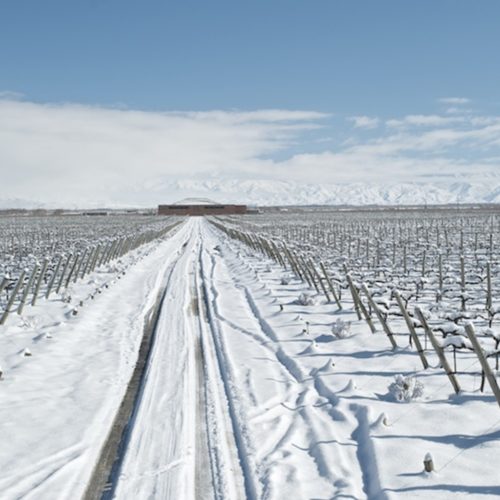
The Best Time of Year to Travel to Bolivia
The best time to travel to Bolivia largely depends on the specific regions you plan to visit and the type of experiences you’re seeking. Bolivia’s diverse geography leads to varied climate conditions throughout the country. Here’s a general overview of Bolivia’s climate the best time of year to visit each region, and the best places to visit Bolivia during each season:
High Season, Shoulder Season, and Low Season in Bolivia:
High Season (May to October):
- Best for : Outdoor adventures and exploring the famous salt flats, Salar de Uyuni.
- Why : During this period, the weather is dry and sunny, making it ideal for trekking, mountain biking, and sightseeing. The iconic Salar de Uyuni is at its most stunning, with a reflective surface created by a thin layer of water.
Shoulder Season (April and November):
- Best for : A balance between good weather and fewer crowds.
- Why : In the shoulder seasons, you’ll experience pleasant weather with fewer tourists compared to the high season. It’s a great time to explore cities like La Paz and Sucre, and even enjoy the stunning landscapes without the peak crowds.
Low Season (December to March):
- Best for : Lower budget travel and experiencing Bolivia’s diverse cultural celebrations.
- Why : This period coincides with the rainy season, which might deter some travelers. However, it’s a budget-friendly time to visit as accommodation and tours often have lower prices. Moreover, if you’re interested in experiencing traditional Bolivian festivals and cultural events, this is when many of them take place.
The best time to visit Bolivia depends on your preferences and interests. The high season is excellent for outdoor activities and exploring the famous salt flats of Salar de Uyuni, the shoulder season provides a balance between good weather and fewer crowds, while the low season offers budget-friendly travel and cultural experiences.
The Climate in Bolivia
The climate in Bolivia varies significantly due to its diverse geography, which includes high mountains, lowland plains, and tropical rainforests. Overall, Bolivia experiences a range of climate zones, from tropical to subpolar. Here’s a breakdown of the main climate regions in Bolivia:
- Highland or Altiplano Region of Bolivia: This region includes cities like La Paz and Potosí, located at high elevations in the Andes Mountains. The climate here is generally cold and dry, with temperatures varying greatly between day and night. The altitude plays a significant role, resulting in cooler temperatures even in the daytime. Rainfall is limited, and the dry season lasts from April to November, while the wet season occurs from December to March.
- Yungas Region: This region lies on the eastern slopes of the Andes and has a subtropical highland climate. It experiences more rainfall and milder temperatures compared to the Altiplano. Cities like Cochabamba and Coroico fall within this region. The Yungas is characterized by its lush vegetation and relatively comfortable climate.
- Tropical Lowlands: The northern and eastern parts of Bolivia, including the Amazon Basin, have a tropical climate. Cities like Santa Cruz and Trinidad experience hot and humid conditions throughout the year, with distinct wet and dry seasons. The wet season typically lasts from November to March, bringing heavy rains, while the dry season runs from April to October.
- Chaco Region: This lowland area in southwestern Bolivia, primarily in the Gran Chaco region, has a semi-arid climate. It’s characterized by hot temperatures during the day and cooler nights. Rainfall is limited, and droughts are not uncommon.
- Subpolar Region: The Potosí Department in southwestern Bolivia is home to the Salar de Uyuni, the world’s largest salt flat. Due to its high elevation and unique geography, it experiences a subpolar desert climate with extremely cold temperatures and low precipitation. It’s worth noting that despite its high altitude, the Salar de Uyuni can experience temperature extremes.
Bolivia’s climate diversity is a result of its varied topography and geography. Altitude plays a significant role in determining temperatures and precipitation patterns, making it important to consider the specific region when discussing the climate in Bolivia.
Traveling During Each Season in Bolivia
In general, there are four main seasons in Bolivia:
- Summer in Bolivia (December to February)
- Fall in Bolivia (March to May)
- Winter in Bolivia (June to August)
- Spring in Bolivia (September to November)
Summer in Bolivia (December to February):
During the Bolivian summer, which corresponds to the rainy season, the country experiences warmer temperatures and increased rainfall. This season is most prominent in the tropical lowland areas and the Yungas region. Cities like Santa Cruz and Trinidad can get quite hot and humid, with daily temperatures often exceeding 30°C (86°F). The lush vegetation thrives during this period due to the abundant rainfall. The Altiplano and highland areas also see some rainfall, making the scenery more vibrant and green. Travelers can enjoy outdoor activities and explore the Amazon rainforest, as well as visit the Yungas region for its stunning landscapes and comfortable weather.
Fall in Bolivia (March to May):
Autumn in Bolivia is a transition period between the rainy season and the dry season. The weather becomes gradually cooler, and the rainy days start to decrease. March and April are particularly pleasant months to visit, as the temperatures are comfortable, and the landscapes remain lush from the previous rains. This is a great time to explore the highland cities like La Paz and Potosí, as well as the Yungas region, before the dry season sets in. The changing colors of the foliage in the Yungas and the Altiplano create picturesque scenes for nature enthusiasts and photographers.
Winter in Bolivia (June to August):
Bolivia’s winter is the dry season, especially in the highland areas and the Altiplano. While daytime temperatures can be mild and comfortable, the nights become significantly colder, often dropping below freezing, particularly in higher altitudes. This is a popular time for tourists to explore the Salar de Uyuni, the world’s largest salt flat, as the dry conditions make it easier to traverse. The clear skies during winter also offer excellent opportunities for stargazing, particularly in the highland regions. Cultural events and festivals, such as Inti Raymi, take place during this time, providing visitors with a unique insight into Bolivian traditions.
Spring in Bolivia (September to November):
Spring marks the transition from the dry season to the rainy season. The weather becomes gradually warmer, and the landscapes start to transform as the first rains arrive. This is a great time to explore the Andean highlands, as the vegetation begins to revive, creating picturesque backdrops for travelers. As the rainy season approaches, the Altiplano and the Yungas region start to show signs of renewed life. The transition between the dry and rainy seasons makes this an interesting time to witness the changing environment and experience the local cultures and traditions that come alive during various festivals and celebrations.
The Best Places to Visit in Bolivia During Each of the Four Seasons:
Summer (December to February):
- Rurrenabaque: Explore the Amazon rainforest, go wildlife spotting, and take riverboat cruises.
- Samaipata: Enjoy the mild climate and visit the ancient El Fuerte ruins.
- Coroico: Experience the Yungas region’s lush landscapes and pleasant weather.
- Madidi National Park: Engage in eco-tourism and experience diverse flora and fauna.
- Lake Titicaca: Visit the Copacabana region and explore the lake’s islands and cultures.
Fall (March to May):
- La Paz: Discover Bolivia’s administrative capital and explore its cultural attractions.
- Potosí: Experience the historic silver mining city and its colonial architecture.
- Uyuni: Explore the Salar de Uyuni salt flats and nearby stunning landscapes.
- Sucre: Enjoy the moderate climate and visit Bolivia’s constitutional capital.
- Tarija: Explore vineyards and experience the Bolivian wine region.
Winter (June to August):
- Salar de Uyuni: Experience the stark beauty of the salt flats under clear skies.
- Oruro: Attend the vibrant Oruro Carnival, a UNESCO-recognized event.
- Potosí: Visit the mines and learn about the city’s rich mining history.
- La Paz: Enjoy cultural events, festivals, and museums in the capital.
- Tupiza: Explore the red rock formations and take horseback rides.
Spring (September to November):
- Cochabamba: Visit the “City of Eternal Spring” and explore parks and gardens.
- Sorata: Enjoy trekking in the Andean mountains with blooming landscapes.
- Yungas Road: Embark on a thrilling adventure on the Death Road amidst springtime scenery.
- Santa Cruz: Experience the city’s pleasant climate and explore its parks.
- Rurrenabaque: Enjoy the beginning of the dry season for Amazon rainforest visits.
Salar de Uyuni is one of the most popular places to visit in all of Bolivia. The salt flats have two primary seasons: rainy season and dry season.
Rainy Season at Salar de Uyuni, Bolivia:
The rainy season in Salar de Uyuni, Bolivia, typically occurs from December to March. During this time, the salt flats transform into a vast reflective mirror due to the accumulation of rainwater. The flat surface of the salt crust becomes covered with a thin layer of water, creating an incredible and surreal mirror effect that reflects the sky above. This unique phenomenon creates breathtaking photo opportunities, where the horizon seems to blend seamlessly with the sky, giving a sensation of walking amidst the clouds.
Dry Season at Salar de Uyuni, Bolivia:
The dry season in Salar de Uyuni occurs from April to November. During this period, the thin layer of water on the salt flats evaporates, revealing the expansive hexagonal patterns of the salt crust underneath. The flats take on a brilliant white color, and the ground becomes solid and firm, making it easier to traverse the area. This is the peak tourist season for visiting the Salar de Uyuni, as the dry conditions allow for more comfortable travel experiences, including vehicle tours and photography sessions.
The dry season is also known for its clear skies, which provide excellent opportunities for stargazing. The high altitude of the salt flats combined with the lack of light pollution creates an ideal environment for observing the night sky.

The Best Time to Travel to Brazil
The ideal time to visit Brazil depends on your preferences, the specific regions you plan to explore, and the type of activities you want to experience. Here’s a general overview of Brazil’s climate the best time of year to visit each region, and the best places to visit in Brazil in each season:
High Season, Shoulder Season, and Low Season in Brazil:
- High Season (December to February): This is Brazil’s summer, particularly in the southern hemisphere, and it’s a popular time for tourists. The weather is warm and humid, making it ideal for beach activities and outdoor festivals. However, it’s also the rainy season in many parts of the country, so you might encounter occasional downpours. The Carnival celebrations in February are a major draw during this period.
- Shoulder Seasons (March to May and September to November): These months offer milder temperatures and fewer crowds compared to the peak summer months. It’s a great time to explore cities, engage in outdoor activities, and visit regions like the Pantanal, as the waters recede, making wildlife easier to spot.
- Low Season (June to August): Brazil’s winter months are considered the low season for tourism. While it might be cooler in some regions, it’s an excellent time to explore cities like São Paulo and enjoy indoor attractions. The northeastern coast remains warm and inviting, making it a good option for those seeking beach vacations with fewer tourists.
The Climate in Brazil:
Brazil’s climate varies significantly across its vast geographical expanse due to its diverse landscapes (Brazil is HUGE!!). The country experiences a range of climates from equatorial to subtropical and even desert-like conditions. Here are some of the main climatic regions in Brazil:
- Equatorial Climate: Found in northern Brazil, this region experiences high temperatures and humidity levels throughout the year, with relatively little variation between seasons. Rainfall is abundant and frequent, with heavy downpours being common. The Amazon Rainforest is located within this climatic zone.
- Tropical Climate: The majority of Brazil, including cities like Rio de Janeiro and São Paulo, falls under this climate type. It is characterized by distinct wet and dry seasons. Summers (November to March) are hot and humid with increased rainfall, while winters (June to August) are drier and cooler.
- Subtropical Climate: Southern Brazil, including cities like Curitiba, experiences subtropical conditions with more pronounced seasons. Summers are warm and humid, while winters can be relatively cold with frost and occasional snow in higher elevations.
- Semi-Arid Climate: The northeastern region, known as the “Sertão,” has a semi-arid climate with irregular and limited rainfall. This results in dry and hot conditions for much of the year. Droughts are not uncommon in this area.
- Arid Climate: The northeastern region also includes parts of the “Sertão” with an arid climate, characterized by extremely dry conditions and low rainfall. The region is often referred to as the “Polígono das Secas” or “Drought Polygon.”
- Highland Climate: Areas of high elevation, such as the Brazilian Highlands, have a cooler climate due to their altitude. Temperatures are generally more moderate than in lower-lying areas.
- Coastal Climate: Brazil’s extensive coastline is influenced by the ocean, leading to more moderate temperatures and relatively stable weather conditions. Coastal cities like Rio de Janeiro enjoy a pleasant maritime climate.
- Pantanal Climate: The Pantanal, a large wetland area, experiences a distinct climate with a wet season from November to March and a dry season from April to October. During the wet season, flooding occurs, creating a unique ecosystem.
Traveling During Each Season in Brazil
In general, there are four main seasons in Brazil:
- Summer (December to February)
- Fall (March to May)
- Winter (June to August)
- Spring (September to November)
Summer in Brazil (December to February):
During the Brazilian summer, which occurs from December to February, most of the country experiences warm and humid conditions. In the equatorial and tropical regions, temperatures can soar, and frequent rainfall is common. It’s a great time to explore the lush Amazon Rainforest, as the increased rainfall rejuvenates the ecosystem and enhances the vibrant flora and fauna. Coastal cities like Rio de Janeiro and Salvador offer a mix of beach activities and vibrant Carnival celebrations, with Rio’s famous Carnival taking place in February. The warm temperatures make it an ideal season for water sports, beach parties, and enjoying the lively cultural scene.
Fall in Brazil (March to May):
In the fall months of March to May, the heat of the summer begins to wane, and the rainy season starts to taper off in many regions. This is a pleasant time to visit cities like São Paulo and Brasília, as the weather becomes milder and more comfortable for exploring urban attractions. The Pantanal, a vast wetland area, is a must-visit during this season, as the receding waters make it easier to spot diverse wildlife. Additionally, the vineyards of southern Brazil, particularly in regions like Bento Gonçalves, are a treat to visit during the fall, with wine festivals and picturesque landscapes.
Winter in Brazil (June to August):
Brazil’s winter months of June to August bring cooler temperatures to much of the country, especially in the southern regions. This is an excellent time to explore cities like Curitiba and Florianópolis, where you can enjoy outdoor activities without the intense heat. The mountainous areas, such as Campos do Jordão, offer a cozy ambiance and sometimes even frosty mornings. For those seeking warmer temperatures, the northeastern coast, including Fortaleza and Recife, remains relatively mild, making it a popular destination during Brazil’s winter. The beaches of northeastern Brazil offer a unique blend of warm waters and a more relaxed atmosphere.
Spring in Brazil (September to November):
As spring arrives from September to November, Brazil experiences a transition to warmer and more humid conditions. This is an ideal time to visit the Amazon Rainforest again, as the dry season commences, making wildlife-spotting easier. The beaches along the northeast coast, such as Pipa and Jericoacoara, become more inviting as the temperatures rise and the rainfall decreases. The iconic Iguazu Falls on the border with Argentina and Paraguay are a breathtaking sight during the spring, as the water levels are higher due to increased rainfall. It’s a great time to explore Brazil’s diverse natural beauty before the heat of the summer returns.
Brazil’s climate offers a diverse range of experiences throughout the seasons. Brazil has something to offer year-round.
The Best Places to Visit in Brazil During Each of the Four Seasons:
- Rio de Janeiro : Enjoy the world-famous Copacabana and Ipanema beaches, explore Christ the Redeemer and Sugarloaf Mountain, and experience the vibrant Carnival celebrations. Rio de Janeiro is great to visit all year round.
- Salvador: Immerse yourself in the rich Afro-Brazilian culture, explore historic neighborhoods like Pelourinho, and participate in lively street parties.
- Amazon Rainforest: Witness the thriving biodiversity of the rainforest, embark on wildlife tours, and experience the unique ecosystem up close.
- Florianópolis: Discover beautiful beaches, go surfing or windsurfing, and explore the island’s hiking trails and sand dunes.
- São Paulo: Explore cultural attractions like museums and theaters, indulge in diverse culinary experiences, and visit parks such as Ibirapuera Park.
- Pantanal: Spot diverse wildlife like jaguars, capybaras, and caimans in this vast wetland area during the receding waters of the dry season.
- Bento Gonçalves: Experience wine festivals, tour vineyards, and savor local wines in the heart of Brazil’s wine country.
- Campos do Jordão: Experience the European-style town, enjoy cozy lodgings, and take part in the winter festival featuring music and cultural events.
- Fortaleza: Relax on warm, sandy beaches, explore the bustling marketplaces, and savor fresh seafood along the northeastern coast.
- Iguazu Falls: Witness the impressive waterfalls in their full glory due to increased rainfall, take exhilarating boat tours, and explore walking trails.
- Lençóis Maranhenses National Park: The best time to visit Lençóis Maranhenses National Park in Brazil is during its dry season, which generally spans from June to September.
- Pipa: Enjoy the stunning beaches and cliffs, go dolphin-watching, and experience the laid-back atmosphere of this charming coastal town.
- Manaus: Explore the gateway to the Amazon Rainforest, visit the iconic Teatro Amazonas, and take boat trips along the Amazon River.
- Jericoacoara: Relax in hammocks on sandy streets, witness breathtaking sunsets, and enjoy water sports like kiteboarding and windsurfing.
- Ouro Preto: Discover the well-preserved colonial architecture, visit historic churches, and experience traditional festivals in this UNESCO-listed city

The Best Time to Travel to Chile
Chile is a land of incredible contrasts, from the Atacama Desert in the north to the fjords and glaciers of Patagonia in the south. It’s a country that’s known for its natural beauty, rich cultural heritage, and delicious cuisine. However, when it comes to planning your trip to Chile, one of the most important decisions you’ll make is when to go.
The best time to visit Chile depends on your interests and the specific regions you plan to explore. Here’s a general overview of Chile’s climate, the best time of year to visit each region, and the best places to visit in Chile in each season.
High Season, Shoulder Season, and Low Season in Chile:
High Season in Chile (December – February):
- Best for: Coastal areas, beaches, outdoor activities, and popular tourist destinations.
- Why: This is Chile’s summer season, offering warm weather and vibrant landscapes. Coastal cities like Valparaíso and Viña del Mar, as well as the Lake District, are ideal to visit during this time. It’s also a great time for exploring Santiago and the Atacama Desert.
Shoulder Season in Chile (Spring – Fall):
- Best for: Enjoying a mix of activities and pleasant weather with fewer crowds.
- Why: Spring (September to November) and fall (March to May) offer milder temperatures and less tourist traffic. These seasons are perfect for exploring wine regions, central cities like Santiago, and the Lake District. The Patagonia region is also more accessible, although conditions can still be challenging.
Low Season in Chile (Winter – Early Spring):
- Best for: Skiing, winter sports, and unique Patagonian experiences.
- Why: Winter (June to August) is ideal for ski enthusiasts, especially near Santiago and in the southern Andes. Visiting Patagonia during this time offers unique opportunities for glacier trekking and wildlife spotting, but be prepared for colder temperatures and limited services.
It’s important to note that Chile’s unique geography leads to microclimates, so conditions can vary even within these general seasons.
The Climate in Chile
Chile’s climate varies significantly due to its geographical diversity, stretching from the driest desert in the north to glaciers and fjords in the south. Here’s a general overview of the climate regions in Chile:
- Desert North (Atacama Desert): The northern regions, including the Atacama Desert, are extremely arid and experience very little rainfall. Temperatures can be hot during the day but drop significantly at night due to the lack of moisture in the air.
- Mediterranean Central Region: The central part of Chile, including cities like Santiago, has a Mediterranean climate. Summers (December to February) are warm and dry, while winters (June to August) are cooler and wetter. This area has a distinct rainy season during the winter months.
- Central Valley: The Central Valley, which includes Santiago and surrounding areas, experiences a mix of temperate and Mediterranean climates. It has a wide range of temperatures throughout the year, with hot summers and cool winters.
- Southern Chile: Moving further south, the climate becomes cooler and wetter. Regions like the Lake District (La Araucanía) and Chiloé have a temperate rainforest climate with ample rainfall throughout the year.
- Patagonia Chile: Southern Chile, including the regions of Aysén and Magallanes, features a cold and subpolar climate. Summers are short and cool, while winters can be harsh with snow and freezing temperatures.
- Tierra del Fuego: The southernmost region experiences a subpolar oceanic climate with cold temperatures and significant precipitation year-round.
- Easter Island: Located in the Pacific Ocean, Easter Island has a subtropical climate with mild temperatures and moderate rainfall.
- Oceanic Islands: Chile also includes various other islands, like the Juan Fernández Archipelago, which have climates that can range from temperate to subtropical.
Chile’s unique geographical features, including the Andes Mountains and the Pacific Ocean, play a significant role in shaping its diverse climates.
Traveling During Each Season in Chile:
In general, there are four main seasons in Chile:
- Summer (December – February)
- Fall (March – May)
- Winter (June – August)
- Spring (September – November)
Summer in Chile (December – February):
During the summer months in Chile, which correspond to December through February, the weather varies across different regions. In the central and northern parts, such as Santiago and the Atacama Desert, the weather is warm and dry. This is an excellent time to explore Santiago’s cultural attractions, enjoy outdoor activities like hiking, and venture into the desert to witness its unique landscapes. In the Lake District, further south, the weather is milder and perfect for activities like kayaking, trekking, and enjoying the lush greenery. Coastal areas, like Valparaíso and Viña del Mar, are popular beach destinations during this time, offering pleasant temperatures and refreshing ocean breezes.
Fall in Chile (March – May):
Chilean fall, from March to May, brings cooler temperatures and a stunning display of colors as the leaves change. This is a great time to visit the wine regions, such as the Maipo Valley and Colchagua Valley, as the grape harvest season (known as “vendimia”) takes place. You can participate in grape picking and enjoy wine festivals. In Santiago, the crisp air makes it a comfortable time to explore the city’s parks and neighborhoods. The Lake District’s fall foliage adds a charming touch to the already picturesque landscapes, making it an ideal time for photography and outdoor adventures.
Winter in Chile (June – August):
Chilean winters, occurring from June to August, offer diverse experiences depending on the region. Ski enthusiasts will find joy in the Andes Mountains near Santiago, where ski resorts like Valle Nevado and Portillo offer excellent slopes and winter sports activities. In the Lake District, winter offers a serene atmosphere with snow-covered landscapes, making it a cozy time to enjoy hot springs, indulge in local cuisine, and explore small towns like Pucon. Southern Chile, including Patagonia, experiences more extreme winter conditions, with opportunities for unique experiences like glacier trekking and wildlife spotting.
Spring in Chile (September – November):
Spring in Chile, from September to November, marks the awakening of nature after the winter months. This is a lovely time to visit the central region, including Santiago, as the flowers bloom and temperatures begin to rise. The city’s parks and gardens become vibrant, creating a pleasant atmosphere for walking and outdoor activities. The Lake District’s thawing landscapes offer a fantastic combination of snowy mountain peaks and colorful blossoms. Coastal areas also start to warm up, making it an ideal time for exploring coastal towns, enjoying seafood, and relaxing on the beaches.
Keep in mind that Chile’s geographical diversity means that weather conditions can vary even within the same season
Best Places to Visit in Chile During Each Season:
- Santiago: Explore the vibrant capital city, its historic neighborhoods, and cultural attractions.
- Atacama Desert: Experience the otherworldly landscapes, salt flats, and stargazing opportunities.
- Valparaíso and Viña del Mar: Enjoy the coastal beauty, beaches, and artistic vibes.
- Easter Island: Discover the mysterious Moai statues and learn about the island’s unique history.
- Lake District (Pucon, Villarrica): Engage in outdoor activities like hiking, kayaking, and soaking in hot springs.
- Maipo Valley and Colchagua Valley: Participate in grape harvest festivities and wine tasting.
- Santiago: Embrace the mild weather to explore parks, markets, and cultural sites.
- Chiloé Archipelago: Experience the unique culture, architecture, and cuisine of this island region.
- Valdivia: Enjoy the beautiful riverside city and its German-influenced heritage.
- Torres del Paine National Park (late fall): Visit before winter to enjoy the park’s stunning landscapes and wildlife.
- Andes Mountains near Santiago: Ski or snowboard in popular resorts like Valle Nevado and Portillo.
- Pucon: Relax in hot springs, snowshoe in the surrounding areas, and enjoy winter festivals.
- Chiloé Archipelago: Experience the misty, mystical beauty of this region during the quieter season.
- Patagonia (Torres del Paine, Ushuaia): Embark on winter adventures like glacier trekking and wildlife spotting.
- Chillán: Ski in the Nevados de Chillán ski resort and enjoy the thermal baths.
- Santiago: Enjoy the blooming parks and gardens as spring brings life to the city.
- Atacama Desert: Witness unique desert blooms and enjoy pleasant temperatures.
- Lake District (Pucon, Villarrica): Experience the mix of snowy peaks and blossoming landscapes.
- Valparaíso: Explore the city’s colorful streets and enjoy a more temperate climate.
- Aysén Region: Venture into the Carretera Austral for stunning springtime scenery.
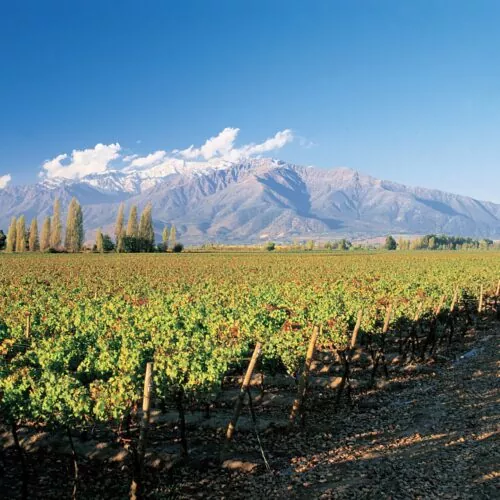
The Best Time of Year to Travel to Colombia
Colombia is a country that offers a wealth of experiences for travelers. From stunning beaches to lush rainforests, colorful cities to historical landmarks, there is something for everyone in this diverse and vibrant country. However, before booking your flight and packing your bags, it’s important to know the best time of year to travel to Colombia. In this article, we’ll explore the ideal time to visit Colombia based on weather, festivals, and other factors that can impact your trip.
High Season, Shoulder Season, and Low Season in Colombia:
The best times to visit Colombia based on its high season, shoulder season, and low season, along with the highlights of each period:
High Season In Colombia (December to February, June to July):
Best for: Beach vacations, cultural festivals, and exploring cities.
- The high season coincides with Colombia’s dry seasons, making it an excellent time for beach vacations on the Caribbean and Pacific coasts.
- Major cities like Cartagena, Bogotá, and Medellín have pleasant weather during this period, making it ideal for city exploration and cultural experiences.
- Many festivals and events take place, such as the Barranquilla Carnival in February, offering vibrant cultural experiences.
Shoulder Season in Colombia (March to May, August to November):
Best for: Avoiding crowds, enjoying lower prices, and experiencing local culture.
- Shoulder seasons offer a balance between relatively good weather and fewer tourists, making it a great time to explore popular destinations without the high-season crowds.
- Hotel and flight prices tend to be more budget-friendly during this time, allowing for cost-effective travel.
- You’ll have the opportunity to engage more deeply with local culture and communities without the hustle and bustle of peak tourism.
Low Season (June to August, October to November):
Best for: Rainforest adventures, eco-tourism, and river exploration.
- While these months are part of the rainy season in some regions, they are still a fantastic time to visit if you’re interested in experiencing the lush beauty of Colombia’s rainforests and natural landscapes.
- The rainforest comes to life during this time with vibrant vegetation and increased animal activity, offering unique opportunities for eco-tourism and wildlife watching.
- River-based activities like kayaking and rafting can be particularly thrilling during the rainy season when water levels are higher.
The Climate in Colombia
Colombia has a diverse climate due to its varying topography and proximity to the equator. The climate ranges from tropical along the coastlines to cooler and more temperate in the highlands. Here’s a general overview of the different climate zones you can find in Colombia:
- Tropical Coastal Regions: The coastal areas, including cities like Cartagena and Barranquilla, have a hot and humid tropical climate. Temperatures usually range between 25°C to 30°C (77°F to 86°F) throughout the year. These regions experience distinct wet and dry seasons.
- Andean Highlands: Colombia’s interior, where cities like Bogotá, Medellín, and Cali are located, is characterized by a more temperate climate due to the high elevation. The temperatures tend to be cooler and more stable, with average temperatures ranging from 10°C to 20°C (50°F to 68°F). There is less variation between seasons compared to coastal areas.
- Amazon Rainforest: The southern part of Colombia is covered by the Amazon rainforest, where you’ll find high temperatures and high humidity levels year-round. This region experiences heavy rainfall throughout the year.
- Orinoco Plains: The eastern plains have a tropical savanna climate with distinct wet and dry seasons. The temperatures can be quite high, often exceeding 30°C (86°F), and the region experiences significant rainfall during the wet season.
- Pacific Coast: The western coast, facing the Pacific Ocean, experiences heavy rainfall due to the influence of the ocean currents and prevailing winds. Cities like Buenaventura and Tumaco receive substantial amounts of rainfall throughout the year.
- Caribbean Coast: The northern Caribbean coast, which includes cities like Santa Marta and Cartagena, experiences a tropical climate with distinct wet and dry seasons. Temperatures are generally warm, ranging from 25°C to 30°C (77°F to 86°F).
Overall, Colombia’s climate diversity is influenced by its geographical features, including its mountains, coastlines, and proximity to the equator.
Traveling During Each Season in Colombia
In general, there are four main seasons in Colombia:
- Summer in Colombia (December to February)
- Fall in Colombia (March to May)
- Winter in Colombia (June to August)
- Spring in Colombia (September to November)
Summer in Colombia (December to February):
During Colombia’s summer months, which correspond to December to February, the country experiences its high season. This is when the weather is typically dry and warm, making it an ideal time for beach vacations along both the Caribbean and Pacific coasts. Cities like Cartagena, with its historic charm and beautiful beaches, become popular destinations for travelers seeking a mix of cultural experiences and relaxation. Santa Marta and San Andres Island are also excellent choices for their pristine beaches and water activities. The vibrant Barranquilla Carnival takes place in February, attracting visitors with its lively parades, music, and dancing.
Fall in Colombia (March to May):
Colombia’s fall, from March to May, marks the shoulder season—a time of transitioning weather and fewer crowds. The Andean highlands, including cities like Bogotá and Medellín, offer pleasant temperatures and fewer tourists during these months. Medellín, known as the “City of Eternal Spring,” lives up to its name with mild weather year-round. In Bogotá, you can explore museums, art galleries, and local markets without the peak-season crowds. The Coffee Triangle, with its stunning landscapes and coffee plantations, is another excellent destination during this time.
Winter in Colombia (June to August):
Colombia’s winter, from June to August, coincides with the rainy season in many regions. However, this is a fantastic time for rainforest adventures and eco-tourism experiences. The Amazon rainforest bursts with life during these months, making it an ideal time for wildlife enthusiasts and bird watchers. The city of Leticia, located in the Amazon rainforest near the borders of Brazil and Peru, is a gateway to these unique experiences. The Pacific Coast also comes to life with lush greenery and offers opportunities for whale watching.
Spring in Colombia (September to November):
During Colombia’s spring, from September to November, the country enters another shoulder season. This is a great time to visit the Caribbean coast, as the rain decreases and temperatures remain pleasant. The walled city of Cartagena continues to be a popular destination, offering a mix of history, culture, and beach relaxation. The Rosario Islands, a short boat ride from Cartagena, are perfect for snorkeling and diving. Additionally, this is a good time to explore Colombia’s interior regions like the Tatacoa Desert and Villa de Leyva, where you can enjoy comfortable temperatures and fewer tourists.
The Best Places to Visit in Colombia During Each Season:
- Cartagena: Explore the historic walled city, relax on the beautiful beaches, and enjoy the lively nightlife.
- Santa Marta: Visit the stunning Tayrona National Park for its beaches and hiking trails.
- San Andres Island: Dive into the crystal-clear waters, snorkel in the coral reefs, and enjoy water sports.
- Barranquilla: Experience the vibrant Barranquilla Carnival with its colorful parades and cultural events.
- Medellín: Enjoy the pleasant weather and explore the city’s museums, parks, and Botanical Garden.
- Bogotá: Discover the rich cultural scene, museums, and historical sites like La Candelaria.
- Coffee Triangle (Manizales, Armenia, Pereira): Experience coffee plantation tours, hike in the Cocora Valley, and enjoy the charming towns.
- Villa de Leyva: Visit this colonial town with its cobbled streets, historic architecture, and nearby fossils.
- Leticia: Explore the Amazon rainforest, go wildlife spotting, and experience indigenous culture.
- Nuquí: Enjoy whale watching on the Pacific Coast and relax in natural thermal pools.
- Mompox: Discover this colonial gem and its well-preserved architecture along the Magdalena River.
- Cali: Attend the Feria de Cali, a lively salsa music and dance festival.
- Cartagena: Enjoy milder weather and fewer crowds while exploring the city’s historic sites.
- Rosario Islands: Snorkel, dive, and relax on the pristine beaches of these nearby islands.
- Tatacoa Desert: Explore the unique desert landscapes and stargaze in this arid region.
- San Agustin: Discover ancient archaeological sites and sculptures in a scenic Andean setting.
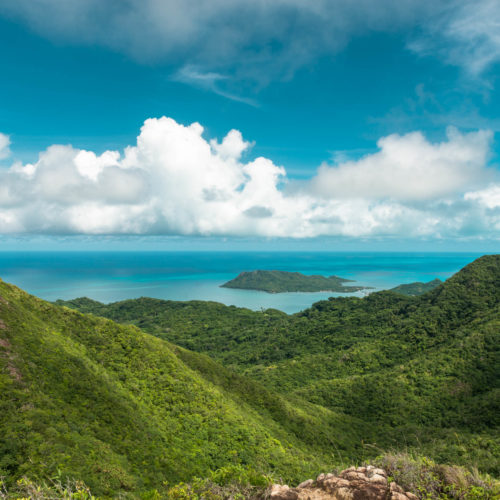
The Best Time of Year to Travel to Ecuador
Ecuador is a land of stunning beauty, with its soaring Andean peaks, tropical rainforests, and pristine beaches. But before you pack your bags and head off on your adventure, it’s important to know when the best time to visit Ecuador is. The climate in Ecuador can vary greatly depending on the time of year and the region you’re in, so it’s important to plan your trip accordingly. Here’s a general overview of Ecuador’s climate, the best time of year to visit each region, and the best places to visit in Ecuador during each season:
Best Time to Visit Ecuador: High Season, Shoulder Season, Low Season
High Season in Ecuador (June to August):
Best For: Exploring the Galápagos Islands, hiking in the Andes, and enjoying Quito’s festivals.
Why: This period offers dry and mild weather across the country, making it perfect for outdoor activities. In the Galápagos, you can witness unique wildlife and enjoy clear waters for snorkeling. The Andean region’s trekking trails are more accessible due to less rainfall. Quito’s Inti Raymi festival in June and other cultural events draw visitors.
Shoulder Seasons in Ecuador (September to November, April to May):
Best For: Experiencing fewer crowds, favorable weather, and a blend of activities.
Why: These months bridge the gap between high and low seasons. You can still enjoy pleasant weather in most regions while encountering fewer tourists. It’s a great time for exploring the Amazon Rainforest and enjoying quieter beaches. Wildlife viewing in the Galápagos remains excellent, and prices might be more budget-friendly.
Low Season in Ecuador (December to March):
Best For: Rainforest adventures, beach relaxation, and cultural immersion.
Why: While this period is the wettest in most regions, it’s an ideal time for rainforest enthusiasts due to lush vegetation and active wildlife. Coastal areas experience heavy rainfall, but if you’re looking to enjoy quieter beaches and cultural experiences, this could be a good time. In the Andes, the rain might limit outdoor activities, but cities like Quito offer indoor attractions.
In summary, high season is great for Galápagos exploration and Andean hikes, while shoulder seasons offer a balanced blend of activities with fewer crowds. Low season appeals to rainforest enthusiasts and those interested in cultural immersion.
The Climate in Ecuador:
Ecuador’s climate varies significantly due to its diverse geography and altitude range. The country is located on the equator, which influences its climate patterns. Generally, Ecuador can be divided into four main regions, each with its own distinct climate:
- Coastal Region: The coastal area has a tropical climate with high temperatures and humidity year-round. It experiences a wet season from December to May and a dry season from June to November.
- Andean Region: The Andes mountains run through the center of Ecuador. The climate here varies with altitude. At higher elevations, temperatures tend to be cooler, and there can be significant temperature fluctuations between day and night. Quito, the capital city, is situated in the Andean region and has a relatively mild climate due to its elevation.
- Amazon Rainforest: The eastern part of Ecuador is covered by the Amazon Rainforest. This region has a tropical rainforest climate, characterized by high temperatures, heavy rainfall, and high humidity year-round.
- Galápagos Islands: The Galápagos Islands, located off the coast of Ecuador, have a unique climate. The islands experience a dry season from June to December and a warm, wet season from January to May. Temperatures are relatively stable throughout the year, with mild variations.
Ecuador’s climate diversity makes it an attractive destination for travelers seeking a range of experiences, from beach relaxation to mountain trekking and rainforest exploration.
Traveling During Each Season in Ecuador
In general, there are four main seasons in Ecuador:
- Summer in Ecuador (June to August)
- Fall in Ecuador (September to November, April to May)
- Winter in Ecuador (December to February)
- Spring in Ecuador (March)
Summer in Ecuador (June to August):
During the summer months of June to August, Ecuador experiences its high season. The weather is generally dry and mild across the country, making it an excellent time for outdoor exploration. The Galápagos Islands are a prime destination during this period, offering a chance to witness unique wildlife and enjoy clear waters for snorkeling. In the Andes, the weather is pleasant for hiking and trekking, and popular cities like Quito come alive with festivals, including the Inti Raymi celebration in June. The coastal region experiences warm temperatures, inviting beachgoers to relax along the Pacific shores.
Fall in Ecuador (September to November, April to May):
Fall in Ecuador, spanning from September to November and April to May, marks the shoulder seasons. These months provide a wonderful blend of activities with fewer crowds. The weather remains favorable, and it’s a great time to explore the Amazon Rainforest, where lush vegetation and active wildlife are highlights. Coastal areas enjoy pleasant temperatures and quieter beaches, perfect for relaxation. The Galápagos Islands continue to offer excellent wildlife viewing opportunities, and you might find more budget-friendly options during this time. In the Andean region, you can still enjoy trekking and cultural experiences without the peak-season rush.
Winter in Ecuador (December to February):
Ecuador’s winter, from December to February, falls within the low season. While rainfall is more common in most regions, this period offers unique experiences. Rainforest adventures are particularly appealing as the lush vegetation thrives, and wildlife activity is at its peak. Coastal areas experience heavy rainfall, making it a quieter time for beaches, but it’s an ideal opportunity for cultural immersion. Cities like Quito provide indoor attractions, including museums and historic sites, where you can learn about the country’s rich heritage.
Spring in Ecuador (March):
Spring in Ecuador, which primarily refers to March, is a transitional month between the rainy season and drier times. While not as well-defined as in other regions, March can be a great time to visit the Andean region as the weather begins to stabilize. Hiking and trekking are still viable options, and the Galápagos Islands continue to offer wildlife experiences, albeit with slightly more unpredictable weather. The coastal region gradually emerges from the wet season, making it a suitable time to enjoy beach activities before the peak of the dry season.
The Best Places to Visit in Ecuador During Each Season:
Best Places to Visit in Ecuador During Summer (June to August):
- Galápagos Islands: Encounter iconic species like giant tortoises at Tortuga Bay and dive into vibrant marine life at Devil’s Crown.
- Quilotoa: Hike to the stunning Quilotoa crater lake and witness its mesmerizing turquoise waters.
- Baños: Engage in adventure activities like zip-lining, canyoning, and soaking in natural hot springs.
- Mindo: Discover cloud forest biodiversity through activities like birdwatching, hiking, and visiting butterfly gardens.
Best Places to Visit in Ecuador During Fall (September to November, April to May):
- Yasuní National Park: Immerse yourself in the Amazon Rainforest, spot wildlife, and visit indigenous communities.
- Cotopaxi Volcano: Trek in Cotopaxi National Park and relish panoramic views of the surrounding landscape.
- Puerto López: Experience whale watching and observe humpback whales during their migration.
- Otavalo: Explore the indigenous market, showcasing traditional crafts, textiles, and local produce.
Best Places to Visit in Ecuador During Winter (December to February):
- Tena: Enjoy river rafting, kayaking, and jungle hikes in the heart of the Amazon Rainforest.
- Cuenca: Admire the architecture of Cuenca’s historic center, a UNESCO World Heritage site.
- Mindo: Embark on a chocolate tour and learn about the cacao production process.
- Baños: Relax in the town’s thermal baths and explore nearby waterfalls and canyons.
Best Places to Visit in Ecuador During Spring (March):
- Baños: Enjoy the “Swing at the End of the World” with panoramic views of Tungurahua Volcano.
- Galápagos Islands: Snorkel with sea lions at Los Tuneles and spot blue-footed boobies on Isabela Island.
- Cuenca: Visit the Pumapungo Archaeological Park, offering insights into Incan history.
- Cajas National Park: Hike around the stunning Llaviucu Lake and witness high-altitude ecosystems.
Ecuador’s diverse regions and unique attractions offer travelers a rich variety of experiences throughout the year. These specific destinations provide opportunities for adventure, cultural exploration, and appreciation of the country’s natural beauty.
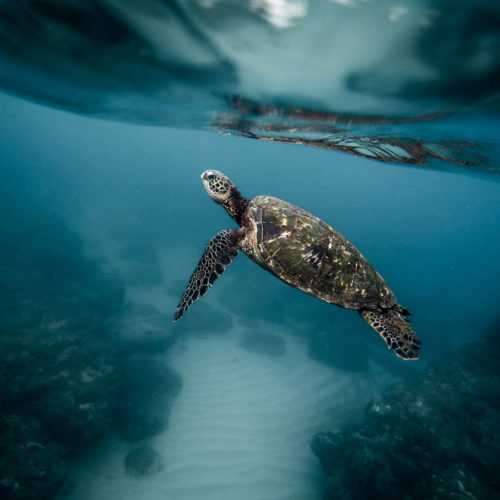
The Best Time of Year to Travel to Paraguay
Paraguay, located in the heart of South America, is a hidden gem waiting to be explored. With its rich cultural heritage, stunning natural landscapes, and vibrant cities, it offers a unique travel experience that should not be missed. However, planning the perfect trip to Paraguay can be challenging, especially when it comes to deciding when to go. The country experiences a subtropical climate, which means that the weather can vary greatly depending on the time of year. Here’s a general overview of Paraguay’s climate, the best time of year to visit each region, and the best places to visit in Paraguay during each season:
Best Time to Visit Paraguay: High Season, Shoulder Season, Low Season
Below is a breakdown of the best times to visit Paraguay, including the high season, shoulder season, and low season, along with the highlights and reasons for each:
Best for: Summer enthusiasts, nature lovers, and festival-goers.
- High temperatures and vibrant atmosphere make it ideal for those who enjoy warm weather.
- Great time for outdoor activities like hiking, water sports, and exploring national parks.
- Experience Paraguayan festivals and cultural events, including Christmas and New Year’s celebrations.
Best for: Travelers seeking pleasant weather, fewer crowds, and diverse experiences.
- Mild temperatures and lower humidity provide comfortable conditions for exploration.
- Enjoy various outdoor activities without the peak-season crowds.
- Observe the changing landscapes as the country transitions between wet and dry seasons.
Best for: Budget-conscious travelers, wildlife enthusiasts, and those interested in local culture.
- Lower tourist numbers lead to discounted rates on accommodations and tours.
- Optimal time for wildlife spotting, as animals gather near water sources in the drier landscape.
- Experience authentic Paraguayan culture and interact with locals without the crowds.
The Climate in Paraguay:
The climate in Paraguay is predominantly subtropical, characterized by distinct wet and dry seasons. The country experiences four main seasons: summer, autumn, winter, and spring.
- Summer (December to February): During the summer months, Paraguay experiences high temperatures and high humidity levels. Average temperatures can range from 25°C to 35°C (77°F to 95°F), and occasionally even higher. This is also the rainy season, with frequent thunderstorms and heavy rainfall.
- Autumn (March to May): Autumn in Paraguay is characterized by gradually decreasing temperatures and decreasing rainfall. Temperatures during this time can range from 18°C to 28°C (64°F to 82°F). The transition from the wet season to the dry season usually occurs during these months.
- Winter (June to August): Winter in Paraguay is mild and dry compared to the summer. Average temperatures can vary between 10°C to 20°C (50°F to 68°F), with colder temperatures in the southern regions. While it is considered the dry season, occasional cold fronts can bring rainfall.
- Spring (September to November): Spring is a transitional season in Paraguay, with temperatures rising as the country moves back into the summer months. Average temperatures range from 18°C to 28°C (64°F to 82°F). Rainfall gradually increases as well, marking the transition into the wet season.
Traveling During Each Season in Paraguay
Summer in Paraguay (December to February):
Paraguay’s summer is characterized by its warm temperatures and high humidity levels. During these months, visitors can expect hot and humid conditions, with average temperatures ranging from 25°C to 35°C (77°F to 95°F). This is the high season for tourism, attracting summer enthusiasts, nature lovers, and festival-goers. It’s an ideal time for outdoor activities like hiking, water sports, and exploring the country’s numerous national parks. The capital city, Asunción, comes alive with festivals and cultural events, making it a vibrant destination during this period. The beaches along the Ypacaraí and San Bernardino lakes become popular spots for relaxation and water activities.
Fall in Paraguay (March to May):
As Paraguay transitions from summer to winter, fall brings mild temperatures and decreasing humidity. With average temperatures ranging from 18°C to 28°C (64°F to 82°F), this shoulder season offers pleasant weather for travelers seeking diverse experiences. It’s a great time for exploring various outdoor activities without the high-season crowds. The town of Areguá, known for its artisanal crafts and tranquil lake, is a picturesque spot to visit during this time. The Jesuit Missions of La Santísima Trinidad de Paraná and Jesús de Tavarangue also offer historical and architectural exploration in comfortable weather.
Winter in Paraguay (June to August):
Paraguayan winters are mild and dry compared to the summer months. Average temperatures during this period can vary between 10°C to 20°C (50°F to 68°F). This is the low season for tourism, making it an excellent opportunity for budget-conscious travelers to explore. The Chaco region, with its unique landscapes and wildlife, becomes a highlight during this time. The city of Encarnación hosts the annual San Juan Bautista Festival, celebrating its cultural heritage with music, dance, and parades.
Spring in Paraguay (September to November):
Spring in Paraguay is marked by rising temperatures and increasing rainfall as the country transitions into the wet season. With average temperatures ranging from 18°C to 28°C (64°F to 82°F), it’s a great time to witness the changing landscapes. Paraguay’s largest national park, Defensores del Chaco, offers lush greenery and diverse wildlife during this period. The city of Villarrica is known for its vibrant Carnival celebrations, offering a unique cultural experience for visitors.
Remember that Paraguay’s climate can vary between its eastern and western regions due to geographical features like the Atlantic Ocean and the Gran Chaco desert.
The Best Places to Visit in Paraguay During Summer, Fall, Winter, and Spring:
Places to Visit during Summer in Paraguay (December to February):
- Asunción: The capital city comes alive with vibrant festivals and cultural events during summer, such as the colorful Carnival celebrations.
- Ypacaraí Lake: This scenic lake is a popular destination for water activities like swimming, boating, and jet skiing.
- San Bernardino: A picturesque town near Lake Ypacaraí, known for its beaches and summer resorts, making it a perfect spot for relaxation.
- Ñu Guasu Park: This park in Luque offers nature trails, picnic areas, and outdoor recreational activities for families and nature enthusiasts.
- Areguá: Explore the artisanal crafts and pottery shops in this charming town by Lake Ypacaraí.
Places to Visit during Fall in Paraguay (March to May):
- Areguá: The town’s tranquility and beautiful lake views make it an even more delightful destination during the mild fall weather.
- Jesuit Missions: Explore the historic ruins of Jesuit missions like La Santísima Trinidad de Paraná and Jesús de Tavarangue.
- Itaipú Dam: One of the world’s largest hydroelectric power plants, offering guided tours to learn about its engineering marvels.
- Ybycuí National Park: With its waterfalls, hiking trails, and diverse flora and fauna, this park is ideal for nature enthusiasts.
- Ybycuí town: Experience Paraguayan traditions during the Semana Santa (Holy Week) celebrations.
Places to Visit during Winter in Paraguay (June to August):
- Chaco Region: This arid region is best explored during the milder winter months. Discover the unique flora, fauna, and Indigenous cultures.
- Encarnación: Enjoy the San Juan Bautista Festival with music, dance, and parades celebrating local culture.
- La Santísima Trinidad de Paraná: The cooler weather provides a comfortable atmosphere to explore the UNESCO-listed Jesuit mission ruins.
- San Cosme y Damián: Relax by the beaches of the Paraná River and visit the historic church in this charming town.
- Villarrica: Engage in traditional Paraguayan activities and cuisine during the Corpus Christi celebrations.
Places to Visit during Spring in Paraguay (September to November):
- Defensores del Chaco National Park: Witness the lush greenery and diverse wildlife in Paraguay’s largest national park.
- Villarrica: Join the vibrant Carnival celebrations with colorful parades, music, and dance.
- Caacupé: Visit the country’s most important religious site, the Basilica of Our Lady of Miracles, during the spring pilgrimage.
- Ybycuí National Park: The spring rains bring the waterfalls to life, making it an excellent time for waterfall hikes.
- San Bernardino: Enjoy the comfortable temperatures and the beauty of Lake Ypacaraí while avoiding the crowds of summer.
These destinations offer a range of experiences throughout the different seasons in Paraguay, ensuring that visitors can enjoy the country’s beauty and culture year-round.
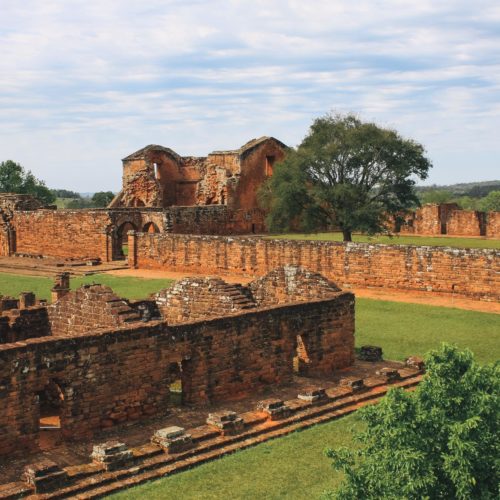
The Best Time of Year to Travel to Peru
The best time to visit Peru depends on your interests and the regions you want to explore. Whether you’re drawn to ancient ruins, stunning landscapes, rich culture, or diverse wildlife, planning your trip based on the specific weather patterns of each region will ensure you have an amazing trip! Here’s a general overview of Peru’s climate, the best time of year to visit each region, and the best places to visit in Peru during each season:
Best Time to Visit Peru: High Season, Shoulder Season, Low Season, Rainy Season, Dry Season
Here’s a breakdown of the high season, shoulder season, and low season, along with what each season is best for:
High Season in Peru (May to September):
Best for: Exploring the Andes, trekking to Machu Picchu, and enjoying coastal cities.
Why: The dry season offers clear skies and pleasant temperatures, making it ideal for outdoor activities and trekking. This period is also popular for Machu Picchu visits due to favorable weather conditions.
Shoulder Seasons in Peru (April and October):
Best for: Combining various experiences across different regions.
Why: Shoulder seasons offer a balance between weather and crowd levels. April and October can be great times to explore both the coast and the mountains, as well as participate in outdoor adventures.
Low Season (November to March):
Best for: Exploring the Amazon rainforest and enjoying fewer crowds in certain areas.
Why: While the rainy season can deter some tourists, it’s a fantastic time to experience the lush beauty of the Amazon rainforest. The crowds are smaller, and you can often find better deals on accommodations
The Climate in Peru:
Peru experiences a diverse range of climates due to its varied geography. The climate varies across its different regions, including the coastal areas, the Andes mountains, and the Amazon rainforest.
- Coastal Region: Along the coast, especially in cities like Lima, the climate is generally mild and arid. Temperatures remain warm throughout the year, with minimal fluctuations. The influence of the cold Humboldt Current from the Pacific Ocean brings cooler ocean breezes.
- Andes Mountains: In the Andes, the climate changes significantly with altitude. Higher altitudes experience cooler temperatures, while lower valleys might have more temperate weather. Cities like Cusco and Arequipa have distinct temperature variations between day and night, so packing layers is important.
- Amazon Rainforest: The climate in the Amazon basin is tropical and humid. The region experiences high temperatures and abundant rainfall year-round. There’s a pronounced wet season from November to April, with heavy rainfalls. Humidity levels remain high, making the area feel even hotter.
- Highlands and Plateaus: The Altiplano region, situated between the coastal desert and the Andes, has a highland climate characterized by cold temperatures, especially during the night.
In Peru, it’s also critical to understand the rainy and dry seasons when planning your trip. Here’s a general overview:
Coastal Region (Lima, Trujillo, Piura, etc.):
- Rainy Season: Minimal rainfall throughout the year, but slightly more rain occurs from June to August.
- Dry Season: Dominates from December to April with little to no rainfall.
Andes Mountains (Cusco, Machu Picchu, Arequipa, etc.):
- Rainy Season: Generally from November to March, with the heaviest rainfall in January and February.
- Dry Season: Stretches from May to September, offering drier and more stable weather conditions.
Amazon Rainforest (Iquitos, Puerto Maldonado, etc.):
- Rainy Season: Occurs from November to April, with significant rainfall and higher humidity levels.
- Dry Season: Runs from May to October, featuring lower water levels and less rainfall, making it more accessible for certain activities.
*note: the exact timing of the rainy and dry seasons can vary slightly from year to year.
Traveling During Each Season in Peru
In general, there are four main seasons in Peru:
- Summer in Peru (December to February)
- Fall in Peru (March to May)
- Winter in Peru (June to August)
- Spring in Peru (September to November)
Summer in Peru (December to February):
During the summer months in Peru, which coincide with December to February, the coastal regions experience warm and sunny weather. Cities like Lima and Trujillo enjoy pleasant temperatures, making it an ideal time to explore beaches, indulge in water sports, and immerse in cultural activities. The dry season prevails along the coast, attracting visitors to iconic sites like Machu Picchu, which boasts clear skies and moderate crowds. This is a high season for trekking, with trails like the Inca Trail offering breathtaking views of the Andes.
Fall in Peru (March to May):
Peru’s fall season, spanning from March to May, presents a transition from the rainy season to drier conditions. This is a great time to explore various regions without the peak crowds of summer. The Amazon rainforest comes alive with vibrant flora and fauna, offering exceptional opportunities for wildlife spotting. The coastal areas continue to enjoy mild temperatures, and cities like Lima host cultural festivals and events. The Andes mountains, especially Cusco, become more accessible as the rainy season subsides.
Winter in Peru (June to August):
Winter in Peru, encompassing June to August, marks the peak of the dry season and is a popular time for travelers. The Andes mountains and Machu Picchu experience clear skies, making it an optimal period for trekking and outdoor adventures. The Amazon rainforest has fewer mosquitoes and is more comfortable to explore during this time. Coastal cities still enjoy mild temperatures, although the water can be cooler, attracting surfers and beach enthusiasts.
Spring in Peru (September to November):
Spring, from September to November, sees a transition back into the rainy season in certain regions. The coastal areas experience milder temperatures, and this is a fantastic time to explore historical sites like Lima’s colonial architecture or Trujillo’s ancient ruins. The Andes mountains begin to see more rain, but the trekking paths remain accessible, offering a blend of green landscapes and clearer skies. The Amazon rainforest becomes more vibrant, with blooming flowers and increased wildlife activity.
The Best Places to Visit in Peru During Summer, Fall, Winter, and Spring:
- Machu Picchu: The iconic Inca citadel is a must-visit during the summer months. Enjoy clear skies and moderate crowds for a breathtaking experience.
- Lima: Explore Peru’s capital city, where you can enjoy its vibrant culinary scene, historic sites like Plaza de Armas, and beautiful beaches such as Miraflores and Barranco.
- Trujillo: Discover ancient ruins like Chan Chan and Huaca del Sol y la Luna, and bask in the warm coastal climate.
- Amazon Rainforest (Iquitos, Puerto Maldonado): Experience the incredible biodiversity of the Amazon during this transitional period. Witness lush flora, spot wildlife, and enjoy more comfortable weather.
- Cusco: Explore the heart of the Inca Empire with fewer crowds. Visit the historic center, Sacsayhuaman, and enjoy cultural festivals like Semana Santa (Holy Week).
- Nazca Lines: Take a flight over the enigmatic Nazca Lines for a unique perspective on these ancient geoglyphs.
- Cusco and Sacred Valley: Embark on unforgettable treks, such as the Inca Trail or the Salkantay Trek, to reach Machu Picchu under clear skies and cooler temperatures.
- Arequipa: Discover the “White City” and visit the breathtaking Colca Canyon to witness condors soaring above the world’s second-deepest canyon.
- Paracas National Reserve: Enjoy the beauty of the desert and coastal landscapes, spot wildlife like Humboldt penguins, and take boat tours to see the Ballestas Islands.
- Lima: Explore the city’s historic neighborhoods, museums, and art galleries as the coastal climate becomes milder.
- Cusco and Surroundings: Experience the start of the rainy season with greener landscapes. Visit the Maras Salt Mines and Moray archaeological site.
- Manu National Park: Discover one of the world’s most biodiverse areas in the Amazon rainforest, with blooming flowers and active wildlife.
- Arequipa and Colca Canyon: Enjoy pleasant temperatures and witness the vibrant agricultural terraces of the Colca Valley.
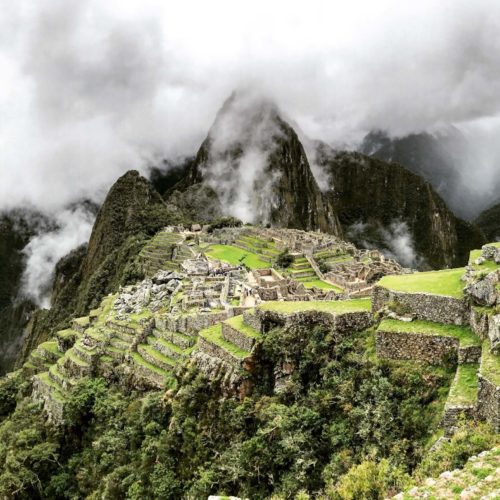
The Best Time of Year to Travel to Uruguay
Uruguay, the small South American country, is often overshadowed by its more famous neighbors, Brazil and Argentina. However, this hidden gem offers a unique blend of colonial charm, natural beauty, and vibrant culture that is worth exploring. If you are planning a trip to Uruguay, one of the most important things to consider is the timing of your visit. The country experiences a varied climate throughout the year, and the best time to visit depends on your preferences and interests. Here’s a general overview of Uruguay’s climate, the best time of year to visit each region, and the best places to visit in Uruguay during each season:
Best Time to Visit Uruguay: High Season, Shoulder Season, Low Season
Here’s a breakdown of the best times to visit Uruguay, considering high season, shoulder season, and low season, along with their respective advantages:
High Season in Uruguay (December to February):
- Beach Lovers: The high season aligns with Uruguay’s summer, making it perfect for enjoying the beautiful beaches along the Atlantic coastline.
- Vibrant Atmosphere: The country is bustling with activities, festivals, and events during this time, creating a lively and festive atmosphere.
- Ideal Weather for Water Sports: The warm temperatures and sunny days provide excellent conditions for swimming, surfing, and other water sports.
Why: High season offers the best beach experience and an opportunity to immerse in the energetic culture of Uruguay.
Shoulder Season in Uruguay (March to April, September to November):
- Mild Weather: The shoulder seasons offer pleasant temperatures, making outdoor activities, sightseeing, and exploring more comfortable.
- Reduced Crowds: While not as busy as the high season, the shoulder seasons still provide a decent level of tourism activity without the overwhelming crowds.
- Wine Tasting: In the fall (April to May), vineyards and wineries in Uruguay host wine-related events, making it an ideal time for wine enthusiasts to visit.
Why: Shoulder seasons strike a balance between pleasant weather and fewer crowds, allowing for a more relaxed and enjoyable experience.
Low Season in Uruguay (June to August):
- Cost Savings, with fewer tourists, accommodations and activities tend to be more affordable during the low season, making it a budget-friendly option.
- Quieter Atmosphere: If you prefer a tranquil and peaceful vacation, the low season provides a more laid-back environment with less hustle and bustle.
- Wildlife Watching: This period is great for spotting wildlife, as many migratory birds and whales can be seen along the coastline.
Why: Low season is ideal for travelers seeking a more affordable and serene escape, along with unique wildlife-watching opportunities.
The Climate in Uruguay
Uruguay has a temperate climate with mild, relatively humid summers and cool winters. The country’s climate is greatly influenced by its proximity to the Atlantic Ocean. Here’s a breakdown of the different seasons:
- Summer (December to February): During the summer months, temperatures in Uruguay range from around 25°C to 35°C (77°F to 95°F) in the daytime. Humidity levels can be relatively high, especially closer to the coast. This is the peak tourist season, as many people flock to the beaches along the coastline.
- Autumn (March to May): Autumn in Uruguay is mild and comfortable, with temperatures gradually dropping. Daytime temperatures range from 15°C to 25°C (59°F to 77°F). This is generally a pleasant time to visit, as the summer heat starts to ease.
- Winter (June to August): Winters in Uruguay are cooler, but not extremely cold. Daytime temperatures hover around 10°C to 15°C (50°F to 59°F), and nighttime temperatures can drop further. Coastal areas experience milder winters due to the moderating effect of the ocean.
- Spring (September to November): Spring is another pleasant time to visit Uruguay. Temperatures start rising again, ranging from 15°C to 25°C (59°F to 77°F). The landscape becomes lush with vegetation as the rainy season begins.
Rainfall is fairly evenly distributed throughout the year, with the wettest months being in fall and spring. Coastal areas tend to receive more rainfall than inland regions.
Traveling During Each Season in Uruguay
Summer in Uruguay (December to February):
During Uruguay’s summer, which spans from December to February, the country comes alive with warmth and energy. This is the high season when both locals and tourists flock to the stunning beaches along the Atlantic coastline. The weather is at its peak, with temperatures ranging from 25°C to 35°C (77°F to 95°F) during the day. The coastal towns such as Punta del Este and La Paloma are particularly popular, offering white sandy beaches and a range of water activities like swimming, surfing, and kiteboarding. Punta del Este is known for its vibrant nightlife, luxury resorts, and upscale dining, making it a hotspot for those seeking a lively social scene. This season is perfect for beach lovers and those who want to indulge in the festive atmosphere of Uruguay’s coastal towns.
Fall in Uruguay (March to May):
As summer transitions to fall from March to May, Uruguay experiences milder temperatures and a comfortable atmosphere. With daytime temperatures ranging from 15°C to 25°C (59°F to 77°F), this is an ideal time for outdoor activities and exploration. The capital city, Montevideo, becomes a great destination for sightseeing with its historical sites, vibrant markets, and charming neighborhoods. Additionally, the wine regions of Uruguay, particularly in the Canelones and Maldonado departments, offer wine enthusiasts a chance to participate in wine festivals and tours. The vineyards are laden with ripe grapes, and the fall colors add to the picturesque beauty of the landscape. Fall is best suited for those who appreciate pleasant weather, cultural exploration, and wine tasting experiences.
Winter in Uruguay (June to August):
Uruguayan winters, spanning from June to August, are relatively cool but not harsh. Daytime temperatures hover around 10°C to 15°C (50°F to 59°F), making this a great time for travelers who enjoy cooler climates. The coastal areas, like Punta del Diablo and Cabo Polonio, still maintain a milder temperature due to the moderating influence of the ocean. The tranquility of these coastal towns during the low season provides a serene environment for those seeking a peaceful getaway. Furthermore, Uruguay’s diverse wildlife can be observed during this time, as migratory birds flock to wetlands, and whales can be spotted off the coast. Winter offers an opportunity for wildlife enthusiasts, budget-conscious travelers, and those who relish quieter surroundings.
Spring in Uruguay (September to November):
Spring, from September to November, marks a renewal of life in Uruguay. The weather becomes more inviting, with temperatures ranging from 15°C to 25°C (59°F to 77°F). The countryside is adorned with lush greenery and colorful blossoms, creating a picturesque setting. Rocha, a department known for its natural beauty, including lagoons and beaches, is a perfect place to experience the vibrancy of spring. The town of Colonia del Sacramento, a UNESCO World Heritage Site, is another fantastic destination to explore during this season, boasting cobbled streets and well-preserved colonial architecture. Spring is a wonderful time for nature lovers, photography enthusiasts, and those who wish to immerse themselves in the natural beauty and historical charm of Uruguay.
Best Places to Visit in Uruguay During Each Season:
- Punta del Este: Explore the glamorous beaches, upscale resorts, and vibrant nightlife of this popular coastal town.
- La Paloma: Enjoy a laid-back beach vibe, great for surfing and relaxation, with pristine shores and charming beachside cabins.
- Montevideo’s Rambla: Stroll along the city’s picturesque coastline, visit markets, and soak in the local culture.
- Cabo Polonio: Experience a unique coastal village with sand dunes, a lighthouse, and an off-the-grid ambiance.
- Montevideo’s Ciudad Vieja: Wander through the historic Old Town, featuring colonial architecture, art galleries, and cozy cafes.
- Piriápolis: Embrace the tranquility of this beach town and explore its iconic hill, Cerro San Antonio, for panoramic views.
- Canelones Wine Region: Take part in wine tours and festivals in this region, known for its vineyards and wine production.
- Colonia del Sacramento: Discover the UNESCO-listed town with its cobblestone streets, colonial buildings, and riverfront charm.
- Punta del Diablo: Enjoy the peaceful atmosphere of this fishing village, perfect for quiet walks along its beautiful beaches.
- Cabo Polonio National Park: Experience the raw natural beauty, remote beaches, and a chance to spot seals and sea lions.
- Maldonado: Explore the town’s architecture, shop at local markets, and discover its cultural heritage.
- Wetlands of Esteros de Farrapos and Isla de Mares: Observe migratory birds and diverse wildlife in these protected wetlands.
- Rocha Department: Discover Rocha’s unique ecosystem, including wetlands, lagoons, and pristine beaches like Playa de la Paloma.
- Colonia del Sacramento: Enjoy mild weather as you explore the historic town’s charm, from its museums to its riverfront views.
- José Ignacio: Experience a quieter side of Uruguay’s coast, known for its chic boutique hotels, fine dining, and serene beaches.
- Salto: Enjoy hot springs and spa resorts in this city, providing relaxation amidst the rejuvenating spring environment.
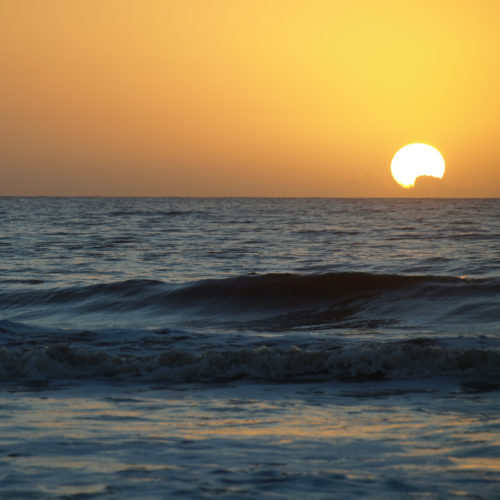
The Best Time of Year to Travel to Venezuela
When it comes to planning a trip to Venezuela, timing can make all the difference in the world. The country’s diverse landscapes, stunning beaches, and vibrant culture offer a unique travel experience year-round. However, understanding the nuances of the seasons can greatly enhance your trip. In this comprehensive guide, we’ll walk you through the best time of year to travel to Venezuela, considering weather conditions, festivals, and various attractions. Whether you’re an adventure seeker, a nature lover, or a culture enthusiast, we’ve got you covered.
The Best Time of Year to Travel to Venezuela: High Season, Shoulder Season, Low Season, Rainy Season, Dry Season
Venezuela’s climate varies across its regions, offering a mix of tropical and subtropical conditions. The optimal time to visit depends on your preferences and interests. Venezuela has a tropical climate with a variety of climatic zones due to its diverse geographical features. The country’s climate can be broadly categorized into four main regions:
- Tropical Rainforest Climate: This climate predominates in the northern coastal regions and the Amazon rainforest areas. It is characterized by high temperatures and high humidity throughout the year. Rainfall is abundant, with a distinct wet season from May to November and a drier period from December to April.
- Tropical Savannah Climate: This climate is found in areas known as “llanos,” which are vast grassy plains. There is a distinct wet season from May to October and a dry season from November to April. Temperatures are typically warm to hot.
- Tropical Highlands Climate: In the Andean region, the climate varies with elevation. Higher elevations experience cooler temperatures, and there is less humidity compared to the coastal areas. The temperature tends to decrease as you go higher into the mountains.
- Desert and Semi-arid Climate: The northernmost part of Venezuela, particularly the Paraguaná Peninsula and parts of Falcon State, experiences a desert climate. This area is characterized by extremely dry conditions, with very little rainfall.
Overall, Venezuela’s climate is influenced by the trade winds, ocean currents, and its equatorial position.
The Dry Season in Venezuela
The best time to visit Venezuela is during its dry season, which typically spans from November to April. During these months, the weather is pleasantly warm, and rain is scarce. It’s an excellent time for beachgoers, with clear skies and calm seas ideal for coastal getaways.
The Wet Season in Venezuela
If you’re a fan of lush landscapes and vibrant flora, consider visiting during the wet season from May to October. While rain can be frequent, this is when Venezuela’s natural beauty truly shines, with rainforests and national parks coming to life.
Traveling During Each Season in Venezuela
In general, there are four main seasons in Venezuela:
- Summer (May to August)
- Fall (September to November)
- Winter (December to February)
- Spring (March to April)
Summer in Venezuela (May to August):
During the summer months in Venezuela, which roughly coincide with the wet season, the country experiences warm to hot temperatures and higher humidity levels. Rainfall is abundant, especially in the northern coastal regions and the Amazon rainforest. This season is characterized by lush green landscapes, vibrant flora, and active wildlife. It’s a great time to explore the natural beauty of the country, such as Canaima National Park with its stunning Tepuis (tabletop mountains) and Angel Falls, the world’s tallest waterfall. Coastal areas like Morrocoy National Park offer opportunities for beach relaxation and water sports, despite occasional rain showers.
Fall in Venezuela (September to November):
In the fall months, the wet season continues in many parts of Venezuela, although the intensity of rainfall starts to decrease. This can be a transitional period between the heavier rains of summer and the drier months ahead. The temperatures remain warm, making it a good time for exploring both the natural and cultural attractions of the country. The Orinoco Delta, with its intricate river systems and rich biodiversity, is an ideal destination for nature enthusiasts during this time. Additionally, cities like Mérida, located in the Andean region, offer cooler temperatures and beautiful landscapes, making it a popular spot for outdoor activities and ecotourism.
Winter in Venezuela (December to February):
Venezuela’s winter, which corresponds to the dry season, is marked by lower humidity levels and milder temperatures. This is a favorable time for outdoor adventures and exploring various regions of the country. The Andean highlands offer comfortable weather for hiking, mountain biking, and enjoying breathtaking views. Roraima, another iconic tabletop mountain, becomes more accessible during this season. The Caribbean coast, including destinations like Los Roques Archipelago National Park, provides a tropical escape with sunny skies and crystal-clear waters, making it an excellent time for beach vacations.
Spring in Venezuela (March to April):
As spring arrives in Venezuela, the dry season continues, and temperatures begin to rise. This is a great time for cultural exploration and visiting historical sites. Caracas, the capital city, offers a mix of modern amenities and historic landmarks. Explore museums, art galleries, and cultural events that showcase the country’s rich heritage. The Joropo Festival, celebrating traditional Venezuelan music and dance, is a highlight during this period. Additionally, the town of Coro, a UNESCO World Heritage Site, is known for its well-preserved colonial architecture and offers a unique cultural experience.
Keep in mind that while these general patterns exist, Venezuela’s climate can be variable due to regional differences and global climate influences.
Best Places to Visit in Venezuela Throughout the Year:
- Canaima National Park: Explore the mesmerizing Tepuis (tabletop mountains) and Angel Falls, the world’s tallest waterfall.
- Morrocoy National Park: Relax on pristine beaches, enjoy water sports, and explore coral reefs and mangroves.
- Mochima National Park: Discover picturesque coves, islands, and a diverse marine ecosystem.
- Los Llanos: Witness the incredible wildlife of the plains during the wet season, with opportunities for wildlife safaris.
Fall in Venezuela(September to November):
- Orinoco Delta: Navigate intricate river systems, observe diverse wildlife, and experience the culture of indigenous communities.
- Mérida: Enjoy cooler temperatures and explore the Andean landscapes through activities like hiking, paragliding, and visiting Mérida’s cable car, the longest and highest in the world.
- Canaima National Park: With reduced rainfall, trekking becomes more feasible, allowing you to experience the park’s beauty in a different way.
- Henri Pittier National Park: Explore the coastal cloud forests and enjoy birdwatching in this biodiversity-rich area.
- Los Roques Archipelago National Park: Bask in the sun on white-sand beaches, indulge in water sports, and explore coral reefs while enjoying the dry season.
- Roraima: Embark on a trek to the summit of this iconic tabletop mountain, accessible in the drier months.
- Mérida: Continue to enjoy the comfortable weather for outdoor activities and explore the city’s cultural offerings.
- Canaima National Park: Visit the picturesque lagoon of Canaima and enjoy boat rides with clear skies and pleasant temperatures.
- Caracas: Immerse yourself in the capital’s cultural scene, visit museums, attend art exhibitions, and explore historical sites.
- Coro: Wander through well-preserved colonial architecture, discover historical landmarks, and enjoy traditional music and dance.
- Morrocoy National Park: With fewer crowds and sunny weather, relish the tranquil beauty of the coastal landscapes.
- Los Llanos: As the wet season approaches, witness the transformation of the plains and the behaviors of the diverse wildlife.
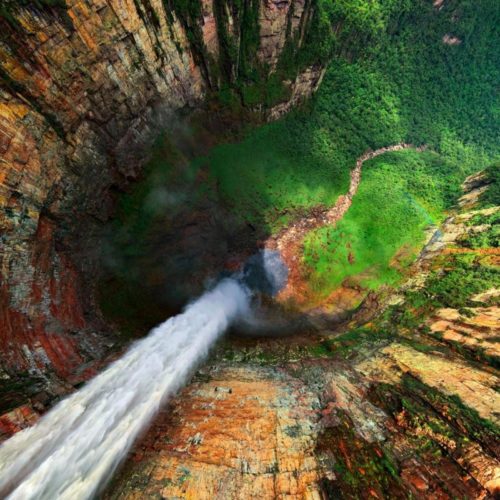
@southamerica
Rainbow mountain in peru: destination overview, history, facts, leave a reply cancel reply.
Save my name, email, and website in this browser for the next time I comment.
South America Newsletter
Email address:
© 2024 Travel South America.

Best time to visit Colombia
Our verdict
The best time to visit Colombia is September
In the summer months, temperatures can reach as high as 22℃ (72℉) in Bogota, Colombia. In the winter months, it can get down to as low as 8℃ (46℉) at night. The climate can differ in many places across Colombia, and you can see more in the handy table below.
If you’re a sun-chaser and want to visit Colombia when the days are longest, you should visit in August. The wet season in Colombia usually falls during the months surrounding April each year. It’s not uncommon to get some decent rainfall or light showers during this time, but on some days the weather tends to be fine for a majority of the day, with only a few drops of rain falling from a passing shower.
Quick links: Fast facts / Seasons / Average temperatures / FAQs / Map
Warmest month
Least rainfall, most daylight, check your travel options, need a place to stay.
*Support us by clicking the links above and making a booking with our partners. It's completely free for you, and it helps us make this site even more awesome! We'll <3 you for it.
ADVERTISEMENT
Colombia seasons
Before you plan your trip, it’s important to know when the seasons are as they may be different to yours depending on where you’re travelling from. Colombia is in the Northern hemisphere, so the seasons fall on:
Best time to visit the top destinations in Colombia
We’ve put together a breakdown of the average minimum and maximum temperatures by month, as well as the best times to visit for each. To learn more about these destinations including detailed climate breakdowns and much more, click or tap the city/destination name below.
Explore Colombia
- Best time to visit Barranquilla
- Best time to visit Bogota
- Best time to visit Cali
- Best time to visit Cartagena
- Best time to visit Leticia
- Best time to visit Medellin
- Best time to visit Santa Marta
Which continent is Colombia in?
What are the best places to visit in colombia.
Check out these guides for the top must-see destinations in Colombia:
When should I visit Colombia for the warmest weather?
When does it rain the least in colombia, colombia map.
Trending destinations
- Guadalajara, Mexico
- Ensenada, Mexico
- Las Palmas, Gran Canaria
- Aberdeen, Scotland
- Sao Paulo, Brazil
- Marseille, France
- Brighton, UK
- Pattaya, Thailand
- Punta Arenas, Chile
- Gold Coast, Australia

Need a hotel in Colombia?
Find hotels and stays for any budget in Colombia with our partners, Booking.com !
- Search Please fill out this field.
- Manage Your Subscription
- Give a Gift Subscription
- Newsletters
- Sweepstakes
- Destinations
- Central & South America
20 Best Places to Visit in Colombia, According to Locals and Experts
These are 20 of the best places to visit in Colombia, from colorful villages to stunning beaches.
:max_bytes(150000):strip_icc():format(webp)/carley-rojas-avila1-CarleyRojasAvila1-2d1f25addb774f8d95109e36b51069c4.png)
atosan/Getty Images
A hypnotizing mix of charming coastal cities, world-class cuisine, and lush landscapes hiding immense biodiversity have made the bicoastal country of Colombia one of the most sought-after destinations in the Americas. Spending a long weekend in Cartagena or a few days in Bogotá isn't enough; even after spending months living in Medellín, I felt I barely scratched the surface of all Colombia offers.
With the help of Medellín-based Travel + Leisure A-List advisor Boris Seckovic and locals who work at some of the country's most incredible accommodations, like Bio Habitat Hotel and Casa Pestagua, we've assembled a list of the best places to visit in Colombia. Read on to find the country's most scenic trekking trails, untouched white-sand beaches, and where to get the best cup of Colombian coffee.
Meet the Expert
Boris Seckovic is a T+L A-list advisor and Colombia specialist living in Medellín.
Carolina Bernal is the general manager at Casa San Agustin and Casa Pestagua, luxury hotels located in Cartagena.
Related: 25 Best Places to Visit in South America
Lara D'agostino/Travel + Leisure
Few destinations have done a better job rebranding themselves than Medellín, a vibrant metropolis whose rapid transformation has made it one of South America's most sought-after cities for travelers and digital nomads alike. Laureles was recently named the coolest neighborhood in the world , though travelers might be more familiar with El Poblado as home to some of Colombia's trendiest cafes, restaurants, and bars. Medellín's impressive public transportation network includes several cable cars, making the journey to green spaces like Arvi Park one of the best ways to enjoy breathtaking views of a city that crawls dramatically up the mountainsides of the Aburrá Valley.
Valle de Cocora
John Crux Photography/Getty Images
Don't be surprised if the Valle de Cocora (Cocora Valley) in the heart of Colombia's coffee country looks familiar. This magical area served as the real-life inspiration for Disney's “Encanto,” so you'll be sure to hear the soundtrack's most famous song as you pass through the nearby village of Salento. Despite its new claim to fame, the Valle de Cocora has long been famous for its impressive forest of wax palm trees, which tower high above the valley, growing up to 200 feet tall.
diegograndi/Getty Images
One of the best cities in South America , Colombia's bustling capital city of Bogotá is much more than just a stopover after an international flight. As soon as you arrive, take a funicular or cable car up the Cerro de Monserrate to take in the city views and get your bearings before exploring the historic neighborhood of La Candelaria. Visiting the Museo del Oro (Gold Museum) is a must, as is experiencing the city's increasingly impressive culinary scene at spots like the award-winning El Chato, one of the world's best restaurants .
Stay at the luxurious W Bogotá , named by T+L readers among the best hotels in South America last year, or stop by for their beloved night brunch. The hotel's bold design is a modern interpretation of the legend of El Dorado.
Amazon Rainforest
alfnqn/Getty Images
"Colombia's slice of the Amazon rainforest isn't as well-known as the Amazon in neighboring countries, but it's almost better that way," says Seckovic, who heads Amakuna , the leading specialist for luxury travel in Colombia. "You'll see far fewer people here and have a much better chance of encountering wildlife because of it." Explore the jungle by starting in the regional capital of Leticia, hidden among forest canopy and accessible only by airplane. From there, head to one of the region's ecolodges for biologist-led excursions into the wilderness, where colorful butterflies dart above waters where pink Amazonian river dolphins play.
Santa Cruz de Mompox
Uwe-Bergwitz/Getty Images
Set along the Magdalena River that winds towards Colombia's Caribbean Coast, the colonial village of Santa Cruz de Mompox "feels like what Cartagena used to be," says Seckovic. An important stop along the river used by the Spanish to extract gold, the UNESCO-protected town still retains all its historic beauty, and an artisan filigree jewelry industry points to its golden past. First-of-their-kind cruises along the Magdalena River with AmaWaterways will kick off in 2024, offering a new way to experience the region on routes that twist through the countryside between Cartagena and Barranquilla.
Starcevic/Getty Images
Cartagena is officially Colombia's worst-kept secret. Whether by cruise ship or via newly added flight routes from major U.S. cities, travelers now flock to Colombia's buzziest and most colorful hotspot year-round. A walk along age-old Spanish colonial walls at sunset with glimpses of the glimmering high-rises of Bocagrande in the distance is all you'll need to see why.
Carolina Bernal, general manager at Casa San Agustin and Casa Pestagua , recommends staying in a restored mansion for a look into the city’s past. Longtime Cartagena favorite Casa San Agustin is a gem; its sister property, Casa Pestagua, is a meticulously restored and luxurious 17th-century mansion colloquially known as the most beautiful home in Cartagena.
maphke/Getty Images
Until recently, Isla Barú was mostly a destination for day trippers looking for the best beaches near Cartagena. The recent addition of the Sofitel Barú Casablanca Beach Resort changes all that, making this "island" just 45 minutes from the city an increasingly popular destination all its own. Travelers can also enjoy a beach day or book an overnight at one of the six new cabana-style bungalows at Acasi Private Beach, a luxe extension of Casa San Agustin and Casa Pestagua on the sand.
Eje Cafetero
Anna Haines/Travel + Leisure
Colombia's idyllic coffee-growing region is known as the Eje Cafetero , the "Coffee Axis." This verdant landscape is peppered with grand haciendas and tiny, shaded cafetales where families have long worked the land, and even passersby enjoy the aroma of the world's best coffee. Explore the countryside in a colorful, open-air Jeep Willy, visiting historic villages like Salento, Jardin, and Filandia along the way.
One of the region's coolest places to stay is Bio Habitat Hotel , where luxurious free-standing accommodations are enveloped in rainforest flora and fauna and offer views across the Andes. This eco-conscious, regenerative hotel perched amidst the forest canopy feels a world away, though it's just minutes from the city of Armenia and some of the country's finest artisan coffee farms.
Ciudad Perdida
traffic_analyzer/Getty Images
Tucked within the lush, tropical Sierra Nevada de Santa Marta mountain range, Colombia's Ciudad Perdida ( or “Lost City”) is among the great ancient ruins in South America. There's no easy way to reach Ciudad Perdida; visiting this hidden settlement demands a four-day mountain trek with numerous river crossings. The payoff is well worth it: Just a few dozen intrepid travelers reach this expansive site with its terraced hillsides and circular plazas every day, meaning you'll get to enjoy it almost uninterrupted.
Only a handful of Santa Marta-based tour operators are certified to guide visitors to the site, still cared for by the descendants of the Tairona people who built the settlement centuries ago.
Guatapé and El Peñol
nicolasdecorte/Getty Images
It's impossible to miss El Peñol, a massive monolith towering many stories over the countryside of Antioquia as if dropped from the heavens by a giant. If the climb to the top doesn't take your breath away, the 360-degree views from the top certainly will. Just minutes down the road, the small town of Guatapé has its own flavor of fantasy, with a kaleidoscope of colors and patterns covering the facades of its historic buildings. These twin destinations are an easy day-trip distance from Medellín, but an overnight stay at some of the country's coolest glamping spots is even better.
Caño Cristales
Claudio Sieber/Getty Images
Known as Colombia's "river of five colors," Caño Cristales is home to unique aquatic plants that give it a liquid rainbow effect you must see to believe. When the colorful effect is at peak vibrancy between July and November, the river seems to run green, magenta, purple, maroon, and canary yellow simultaneously. The river is located in the relatively isolated Serranía de la Macarena National Park, though locals attest it's well worth the trip to see one of the world's strangest natural wonders.
Related: Visiting Caño Cristales, Colombia's Liquid Rainbow
mehdi33300/Getty Images
The village of Barichara is arguably Colombia's prettiest. Barichara is a bit further from the country's major cities than other historic gems like Villa de Leyva, so "it's stunningly beautiful, but still not too touristy," says Seckovic. The town made T+L's list of the best hidden gem destinations to visit last year and is conveniently located just a stone's throw from San Gil, the undisputed capital of adventure travel in Colombia.
Tayrona National Park
Rodrigo A. Rodriguez Fuentes/Getty Images
In Tayrona National Park, Colombia's best beaches line untouched jungles with enough endemic flora and fauna to make any eco-conscious traveler swoon. Take a skippered sailing excursion to the park directly from Santa Marta, with stops at spots like Bahia Concha and Cabo San Juan for swimming, snorkeling, and sunbathing. More adventurous travelers can trek through the park and camp in hammocks perched directly over white sands.
Rosario Islands
“The Rosario Islands, or Islas del Rosario, are known for coral reefs and year-round diving and snorkeling opportunities," says Bernal of this perennially popular destination located off the coast of Cartagena. Hop on a speedboat in town and escape to eco-friendly boutique hotels tucked away on sandy shores, offering some serious rest and relaxation far from the crowds. It's an affordable and laid-back alternative to the built-up Caribbean islands where you would spend your days fighting for beach chairs.
Barranquilla
Roxana Charris/Long Visual Press/Universal Images Group via Getty Images
Among the cities on Colombia's Caribbean Coast, Barranquilla can't compete with buzzy, beautiful Cartagena. However, for one week a year, Colombia lives and breathes to the rhythms of the Carnival of Barranquilla. Folkloric dance, music, and rich, regional food shine among a packed schedule of events including the Battle of the Flowers, the Great Troupes Parade, and the Death of Joselito Carnival, each more vibrant than the last. It's such an essential spectacle that it made the UNESCO list of Intangible Cultural Heritage of Humanity .
Related: T+L's Guide to Colombia's Caribbean Coast
Antoine Barthelemy/Getty Images
The small city of Popayán still flies under the radar of most travelers, but it's all the better for it. Known as Colombia's "White City" for its grand historic center's whitewashed facades, this laid-back town feels like a breath of fresh air for travelers with an itinerary packed with just the country's biggest highlights. It's a great first stop on a road trip north through cities like Cali and to the haciendas and villages that make the Eje Cafetero so memorable.
Tatacoa Desert
oscar garces/Getty Images
The Tatacoa Desert is the second-largest arid environment in Colombia, after the dune-studded La Guajira at the northern tip of South America. However, Tatacoa isn't a desert at all, but a long-dry tropical forest where lush flowers bloomed a millennium ago. Its unexpected past makes fossil-hunting a perfect pastime on hikes through its dramatic red canyons. Tatacoa's remote location and ideal atmospheric conditions also make it one of South America's best destinations for stargazing .
alarico/Getty Images
Known as the capital city of salsa, Cali is the best place to visit in Colombia if you want to settle into several days of lessons to truly master these sensual steps. Zaperoco Bar is one of Cali's most famous salsa clubs, while Siboney — its name pointing to the rhythm's original Cuban roots — has long been one of Cali's salsa institutions. Fill your dance breaks by exploring the city's historic center and with day trips through the Valle del Cauca for river tubing, ziplining, and waterfall hikes.
Judith Engbers/Getty Images
Tucked away within Utría National Natural Park on a remote stretch of Colombia's Pacific Coast, the tiny beach town of Nuquí is known as one of the best places in the country for whale watching. Between July and October, humpback whales travel from Antarctica to these warmer waters to give birth to their babies in the region's protected lagoons. Whale watching is the undisputed highlight for most travelers visiting Nuquí, but adventurous travelers will love surfing near jungle-fringed shores and hiking to long-hidden rainforest waterfalls.
San Andrés and Providencia
tifonimages/Getty Images
Search for the islands of San Andrés and Providencia on a map, and you'd be forgiven for thinking they were a part of Central America. These tiny, remote islands over 450 miles from the Colombian mainland sit within a stretch of sea so azure it's called the "Sea of Seven Colors," and they are home to some of Colombia's last truly untouched beaches. Livelier San Andrés and more unspoiled Providencia are little-visited, idyllic destinations worth considering for your next unplugged, unbothered Caribbean getaway.
Related Articles

13 Important Tips For First-Timers Visiting Colombia
- Eat at the hotel for cleanliness and safety.
- Bring enough cash for daily activities, especially in remote areas.
- Learn basic Spanish to navigate the country and communicate effectively.
Visiting Colombia for the first time can be exciting, but just like any destination worldwide, there are some tips one needs to know before visiting. Language, weather, money, and transportation can be quite confusing, especially in Colombia. Still, with these tips, one will be able to avoid a lot of difficult situations in the country. It doesn't matter if you're here for ten days or three; Colombia is a gorgeous country with endless things to experience. Whether it's someone's first time or they need a refresher, you can't go wrong with following these essential tips for traveling to beautiful Colombia!
UPDATE: 2023/11/25 16:36 EST BY NOAH STAATS
There Are More Things To Know When Visiting Colombia
This article has been refreshed with new information regarding a trip to beautiful Colombia, as well as expanded talking points for previous suggestions. Remember to stay out of bad neighborhoods at night, bring enough cash for day trips, learn some Spanish, and have plenty of fun!
Eat At The Hotel If You're Worried About Cleanliness
For those coming to Colombia and nervous about food and water cleanliness, it's always a safe bet to eat with your hotel or resort and get water via gift shops inside them. Although most places in bigger Colombian cities are clean and safe, some smaller villages do not abide by strict health and sanitation regulations when preparing or serving food and drinks. To steer clear of food-borne illness, make sure and book restaurants with good reviews and clean kitchens/dining rooms.
- It's generally better to eat at the hotel if you're staying somewhere off the beaten path.
Tayrona National Park is a fun day trip idea for visitors to Colombia.
Make Sure And Keep Some Cash Ready
One thing many visitors to Colombia forget is to bring enough cash for daily activities. Because debit and credit cards are often not accepted or take a large conversion fee, getting cash from the bank or at your hotel may be the better option. Of course, in bigger cities, there will be more accessibility and availability to ATMs and stores taking credit cards, but in remote towns and villages: bring cash.
That said, keep all cash somewhere safe and hard to get to. Pickpocketing is prevalent here, as well as violent assault in poorer areas.
- Because of steep ATM and credit card fees, it's best to bring enough money for everyday food, attractions, and transportation when visiting Colombia.
Learn Some Spanish Words
Colombia is a place where the majority of the population speaks only Spanish. In a place like Bogotá - the capital city , most people only speak Spanish, which means it can be difficult to get around if one only knows English. While one does not necessarily need to know how to speak the language, some basic words will go a long way and help one better get around the country.
- Learning basic Spanish will go a long way when coming to Colombia.
Taxis Are Cheap, But Buses Are Cheaper And Safer
Buses are Colombia's main means of transportation, and they are incredibly cheap and safe. Taxis, on the other hand, are also cheap, but a few inconveniences come with them. First, they can be unsafe, as fake taxi drivers can rob passengers. Apps such as Uber and Easy Taxi are illegal in the country, but they are still in operation and are the safest ways to get taxis.
- Taking the bus is often cheaper and safer than taxis while in Colombia.
Avoid Lonely Areas, Especially At Night
Just like many other amazing destinations worldwide, Colombia experiences increased crime, which is why one must exercise extreme caution when visiting. A good rule is avoiding lonely areas, especially at night. For the first trip, travelers can stick to the popular tourist destinations around the country, which are usually more crowded, to avoid being an easy target.
- Tourists to Colombia are not recommended to venture out into lonely/quiet areas at night.
Avoid Unnecessary Display Of Wealth
Showing unnecessary displays of wealth, especially in a country like Colombia, may be dangerous. The country's economy is bad, which has made many people living there desperate. It is advisable to avoid putting on too many accessories or carrying large amounts of money around to avoid drawing too much attention to oneself.
- Wearing fancy clothes, jewelry, or other accessories in Colombia can get you into trouble at night or in certain areas.
Prepare An Itinerary To Follow Before Visiting
Colombia is very big and endowed with plenty of natural and man-made attractions, which means there are plenty of things to see and do here. Without a proper itinerary of what to do in the country, one can find it difficult to get the most out of their visit. During the planning process, make a list of things to do in the country and follow that itinerary when in the country. There will be more to do, but it is better to have a plan rather than randomly deciding what to do.
- Planning before you come here can help ease frustration due to Colombia's vast offerings.
Related: 10 Best Places To Visit In Colombia
The Weather Can Be Unpredictable, So Come Prepared
Colombia experiences two major seasons, which are rainy and dry. But the weather is not usually not dependent on the time of the year but on elevation. The weather can easily change from sunny to rainy in some parts of the country with higher elevations, like Bogotá. The temperature is also known to sometimes rise from as low as 4 degrees Celsius to 19 degrees Celsius on some days. Some parts of the country, such as Cartagena and Santa Marta, experience lots of sunshine all year round. This means at any time of the year; one can experience all four seasons in Colombia. With such diverse and unpredictable weather, one has to come prepared to face any type of weather in this country.
- The weather is unpredictable in Colombia, with wild changes in temperature being common.
Never Talk About Drugs, Especially Cocaine
One important thing to always avoid doing in Colombia is talking about drugs. Drug production and trafficking continue to increase in this country, and drug is always accompanied by crime. This makes it not just a national issue but a global issue for which Colombia plays a major role as it is one of the major producers of cocaine in the world. In 2021, the production of coca leaves which is the main ingredient for cocaine, increased drastically. To avoid getting into a difficult situation, pretend not to know anything about drugs in Colombia and instead focus on enjoying the amazing things the country has to offer.
- Joking or discussing cocaine can and will get you in trouble with law enforcement in Colombia.
Haggle Before Buying Something
The asking price of a product in Colombia may not always be the actual price but just the seller trying to get more profit from tourists who may not know the price. To avoid getting ripped by sellers (who always know a gringo when they see one), employ the skill of bargaining when purchasing something. Buying something $5 less than the initial asking price is not uncommon.
- It's worth it to try and bargain with vendors while shopping in Colombia.
Altitude Sickness Is Real In Colombia
In Colombia, like many parts of South America, high altitude is something that one often has to worry about as the country is filled with many mountains. Bogota, the country’s capital, rises to an elevation of 8,660 feet , making it one of the highest cities in the world. One important tip to help deal with altitude sickness in Colombia is to always stay hydrated when heading to places with high altitudes. Adventurers seeking to go rock climbing or visit higher places can also include other substances like vitamins and minerals to cushion the effects of the high altitudes. Alcohol, caffeine, and other dehydrating substances should also be avoided when heading to higher elevations.
- Because of the possible 8,660 feet of elevation in Colombia, it's not uncommon for altitude sickness to ravage through groups vacationing to the country.
Related: Tips To Avoid The Altitude Sickness While Traveling In South America
It’s Not Mandatory To Tip
In hotels, bars, restaurants, and other service centers around Colombia, tipping is not usually mandatory or expected, unlike in other countries. Nicer restaurants usually include a 10% service charge automatically on the bill. Of course, if the service was exceptional, it does not hurt to give the service person some extra change. Tipping taxi drivers is also not a thing as passengers are only required to pay the amount on the meter; still, the extra tip is always appreciated. In most cases, tips cost between 2,000 and 5,000 Columbian Pesos, equivalent to a dollar. That's like nothing to most tourists, but the locals in Colombia appreciate it so much.
- Adding a tip (although appreciated) is not required in Colombia.
Be Careful On The Roads
The traffic in Colombia can be chaotic. Drivers here are usually impatient and aggressive and won’t stop for anybody. To avoid getting into a dangerous situation on the road, it is important to be careful on the roads. With dangerous roads and long traffic jams, it will be better to avoid driving in Colombia and just stick to using taxis and buses.
- Driving can be difficult here, especially regarding other impatient and volatile drivers.
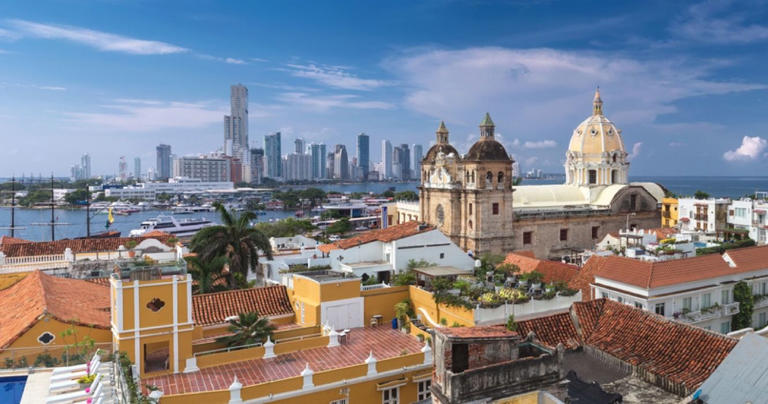
- € EUR

When is the Best Time to Visit South America?

Published on: May 3rd, 2024
Last modified: May 3rd, 2024
For many, the best time to visit South American destinations will be the warm summer months of December to March. These months offer the perfect weather conditions for hiking in Patagonia , snorkelling off the Galápagos Islands and sightseeing in Buenos Aires . For others, the clear and chilly winter months of June to September are best for exploring Machu Picchu and the Atacama Desert .
South America is a massive geographical area with many diverse landscapes and climates. The continent offers year-round opportunities for exciting and luxurious travel from Colombia ’s Caribbean coast to the tip of Argentina , stopping off at rainforests, wetlands, the Andean peaks of Bolivia , Peru and Chile – and almost everywhere in between.
Choosing when to visit South America for your adventure will depend on the climate in the places you want to go to, and what you want to do when you’re there. With this in mind, we’ve asked our experts to collate a climate guide that covers the entire region, explaining not only the climate but also geographical distinctions and the best activities.
Month-by-Month Climate Guide for South America
To help you choose the best months to visit South America , we’ve compiled a month-by-month climate guide, highlighting the different weather conditions in some of our favourite locations. It’s important to remember that climate differs greatly across the region, often affected by other factors such as altitude and coastal winds, and proximity to the tropics or the polar continent of Antarctica.
January in South America
Best for hiking in patagonia.
January is a peak summer month in the southern hemisphere, boasting warm temperatures and minimal rainfall. Destinations such as Patagonia , the Chilean Wine Country and Uruguay offer ideal conditions for outdoor pursuits. Average temperatures range from 20°C to 30°C (68°F to 86°F) – perfect for hiking, vineyard visits and exploring the lakes of Argentina and Chile.
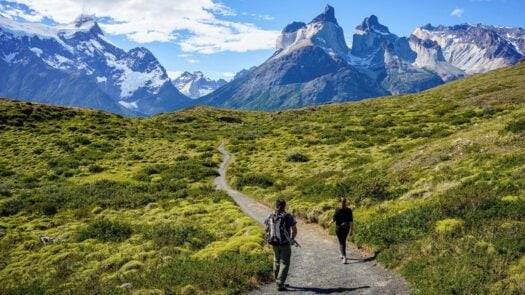
February in South America
Best for rio carnival.
February in South America is a warm summer month with plenty of sunshine – perhaps best enjoyed at the world-famous outdoor street party that’s Rio de Janeiro Carnival. Average temperatures are similar to January, ranging from 25°C to 30°C (77°F to 86°F). It’s worth remembering that the high Andean regions do experience rain in the summer, so it’s best to avoid visiting Machu Picchu in February.
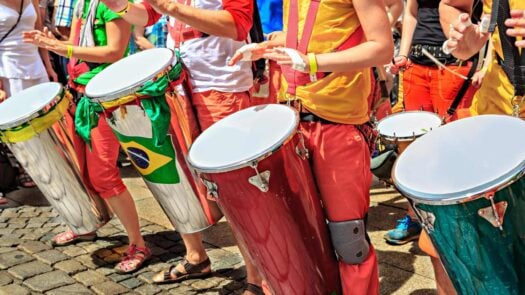
March in South America
Best for harvest festivals in mendoza.
March is a transitional month which can mean fewer visitors at popular places like Torres del Paine National Park as the high season (December to March) is just drawing to a close. The start of autumn is a great time to visit both Mendoza and the Chilean wine region for harvest festivities and to taste delicious wine. Expect daytime temperatures of 20°C to 25°C (68°F to 77°F).
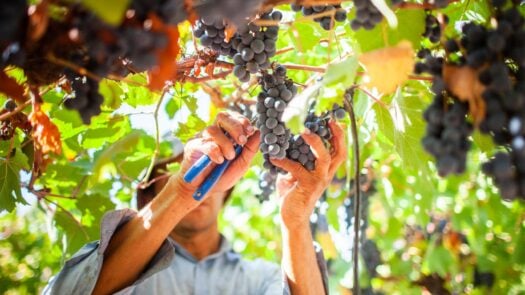
April in South America
Best for lush green landscapes after the rains.
April signifies the beginning of the dry season in many parts of South America, offering mild temperatures and decreasing rainfall. Central American countries such as Costa Rica , Guatemala and Belize are lush after the rains, framing ancient Mayan ruins and sandy beaches in spectacular fashion. Here, average temperatures hover between 20°C to 30°C (68°F to 86°F) – great for wildlife expeditions and walking tours of archaeological sites.
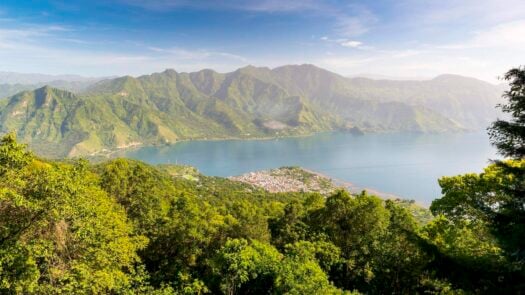
May in South America
Best time to visit the andes mountain range.
May marks the start of the dry season in the Andes, so it’s a good month to explore Ecuador , Bolivia , and Machu Picchu in Peru – which can get very busy come July and August. Temperatures will average 15°C to 25°C (59°F to 77°F), comfortable for walking city tours in Quito and Cusco . Visiting the Galápagos Islands in May means catching the last of the warm waters. The warm water season, which starts in December, is the best time to spend longer in the water on snorkelling wildlife excursions.
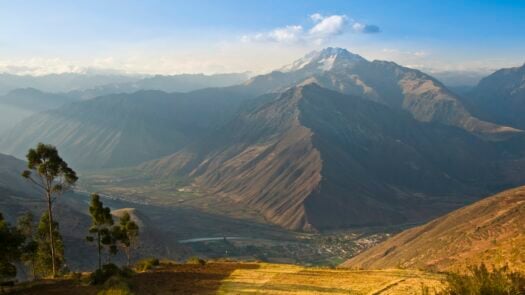
June in South America
Best for the start of high-water season in the amazon.
Temperatures begin to drop in June, particularly in Patagonia and specifically further south into Tierra del Fuego and Ushuaia . There’s beautiful sunshine to be found around Machu Picchu, although it can feel chilly in the mornings. June is the start of the high-water season in the Amazon , which is the best time for cruising and canoe trips. High water means it’s easier access to the narrow waterways that run deep into the forest interior.
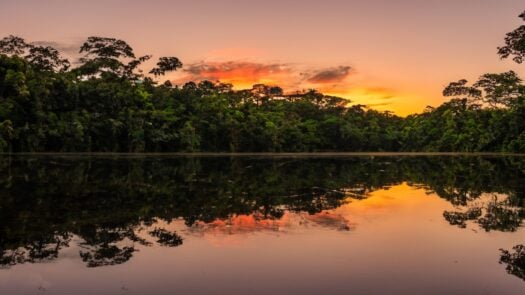
July in South America
Best for visiting iguassu falls.
July is one of the best months to visit South America’s tropical regions such as Missiones, where you’ll find Iguassu Falls , as humidity is low and temperatures are not too intense. As you travel north into Central America, expect some wet weather as the rainy season runs from May to October. It’s worth remembering that there will still be plenty of sunny spells and opportunities for activities across Costa Rica, Panama, Belize and Guatemala.
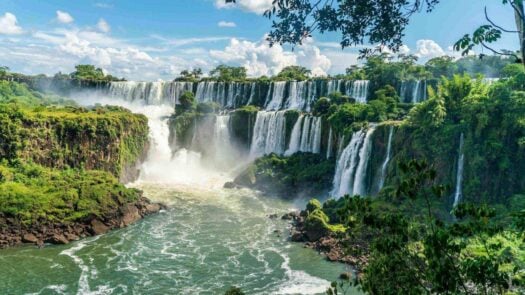
August in South America
Best time to visit ecuador for clear skies.
Come August most of Belize, Guatemala and southern Mexico are preparing for their rainiest months. Down in the far south, Patagonian temperatures are now at their lowest and some lodges will close. With continued low rainfall and clear skies, Ecuador and Peru are great South American destinations to visit in August with average midday temperatures ranging from 15°C to 25°C (59°F to 77°F).
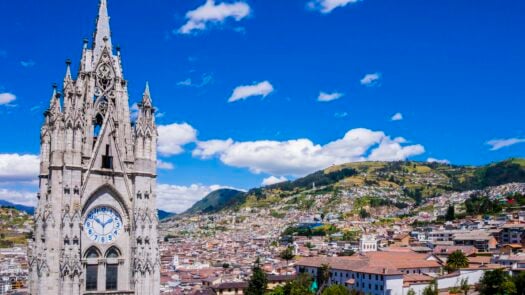
September in South America
Best time to see whales in argentina.
September is officially the start of spring in South America but is mostly seen as a transitional month. Patagonia will still feel quite cold with daytime temperatures only reaching around 8°C (46°F). September is a great month to go whale watching in Peninsula Valdes in Argentina as it’s calving season. The whale watching season itself typically runs from June to December as the southern right whales leave Antarctica , seeking warm waters and feeding opportunities.
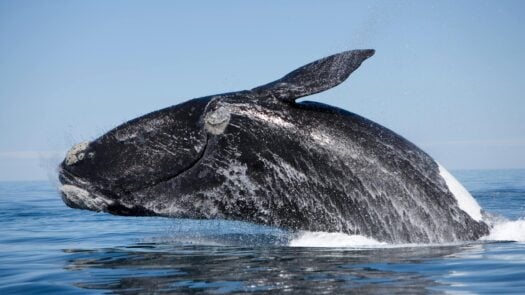
October in South America
Best for spring flowers in patagonia.
Spring starts to make an impact in the south of the continent in October. Expect beautiful displays of spring flowers all over the undulating plains of Torres del Paine National Park. In Mexico, Day of the Dead celebrations make October a great time to learn about the meaningful rituals and practices associated with the festival. October is one of the dry season months for the Amazon, which runs from July to December. This is the best time to visit for nature walks on the forest floor.
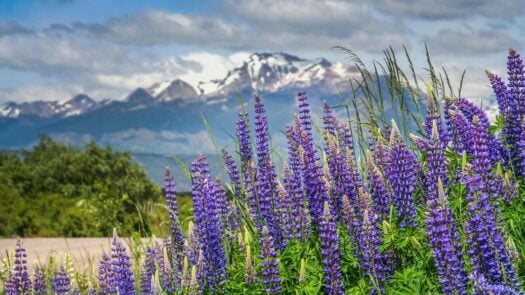
November in South America
Best for quieter travel as the rains begin.
November moves from a dry season to a rainy season in many regions of South America, offering spells of pleasant weather and fewer crowds. In Central America, Costa Rica, Guatemala, Belize and Panama should remain moderately dry and quieter than the busy month of December. Temperatures in Central America at this time range from 20°C to 30°C (68°F to 86°F), with some showers still possible.
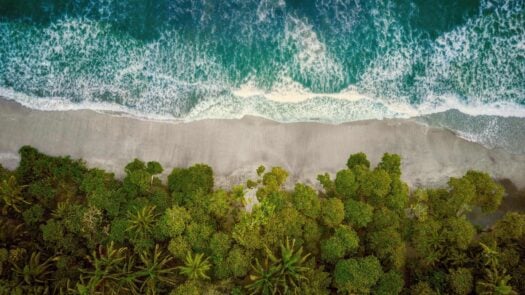
December in South America
Best for enjoying buzzing cities.
December heralds the beginning of summer, ushering in warm temperatures ranging from 25°C to 35°C (77°F to 95°F) in many areas with plenty of sunshine. This can be a great month to visit the continent’s exciting cities such as Buenos Aires, Santiago , Rio de Janeiro and Cartagena , where cafes and bars spill onto the streets and tango, samba and salsa beats fill the night air.
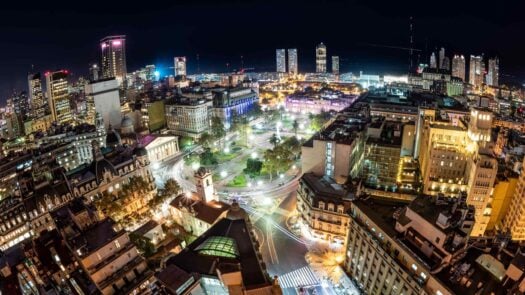
The best things to do in South America by Season
Latin America offers a plethora of cultural, adventure and wildlife experiences. Choosing the best time to visit will often depend on what you want to experience. These are our favourite things to do, tried-and-tested by our travel designers and concierges, and the best time to do them.
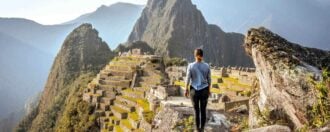
Hike the Inca Trail, Peru
Hiking the Inca trail to the breathtaking ruins of Machu Picchu is a challenging and incredibly rewarding experience. The best time to tackle the route through cloud forests and pretty valleys, and up startling granite peaks is the dry season, between May to September. At this time rainfall is minimal, pathways are dry and temperatures are comfortable for hiking.
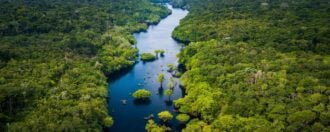
Exploring the Amazon Rainforest, Peru
Both the Peruvian and Brazilian Amazon can be visited year-round, the climate is not particularly changeable. The main difference in conditions are the water levels. The low water season lasts from June to November and the high water season from December through to May. If you want to go on nature walks, explore the forest floor and look for wildlife, then the best time to visit is during the low water season, June to September. High-water season can be a great time to take a luxurious cruise .

Snorkelling in the Galápagos Islands, Ecuador
Discovering the marine wonders and incredible biodiversity of the Galápagos Islands is without doubt a year-round activity – it’s always incredible. The best time for snorkelling in the Galápagos is from December to May when water temperatures are warmer and visibility is at its best. Dive into crystal-clear waters teeming with colourful fish, sea turtles, playful sea lions and much more.

Experiencing the mirror effect on the Uyuni Salt Flats, Bolivia
The best time to witness the mesmerising mirror effect on the Uyuni Salt Flats is during the rainy season, from November to April. This period, especially after heavy rainfall between January and March, creates a thin layer of water on the salt flats, transforming them into a stunning natural mirror. The calm water reflects the sky, offering surreal and breathtaking views.
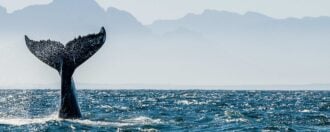
Whale spotting at Peninsula Valdes, Argentina
In Argentina, the best time to spot whales is from June to December along the Peninsula Valdes coastline. Southern right whales visit at this time to mate and give birth, offering remarkable opportunities for whale watching. Venturing out of South America, north to Mexico along the Pacific coast of Mexico, the best time for whale-watching is from mid-December to April. During this time, majestic grey whales migrate south from their feeding grounds in Alaska to calf in the warmer waters.
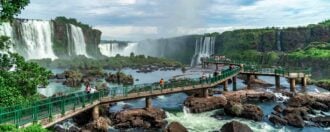
Visiting Iguazu Falls, Argentina and Brazil
Iguazu Falls are at their fullest between December and February, however it can be very hot and busy at this time. As the waterfalls are spectacular all year round, the best time to visit Iguazu Falls is often in the autumn (March to May) when the weather is generally mild and the water levels just right.

Go Stargazing in the Atacama Desert, Chile
The high altitude and remote location of the Atacama Desert has made this area famous for its dark skies and unmatched stargazing experiences – it's one of the best destinations to experience the night sky on the planet. For the ultimate stargazing adventure, plan your visit during the dry season, running from late March to early November. During this time you can expect clear skies with hardly any clouds.
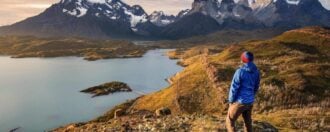
Hiking in Patagonia, Argentina and Chile
The best time to go hiking in Patagonia is during the summer months from November to March when temperatures are milder, and daylight hours are longer. These conditions are great for hikes around Torres del Paine National Park, the El Chalten region and the Lake Districts of Chile and Argentina. On the trails look out for guanacos, pumas and Andean condors.
Trip Inpsiration
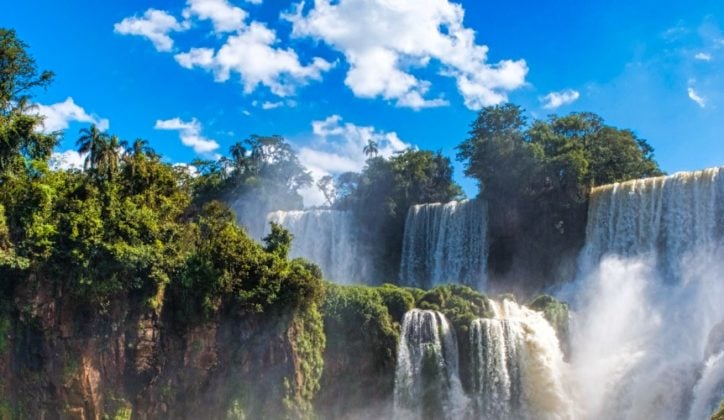
Where to Stay
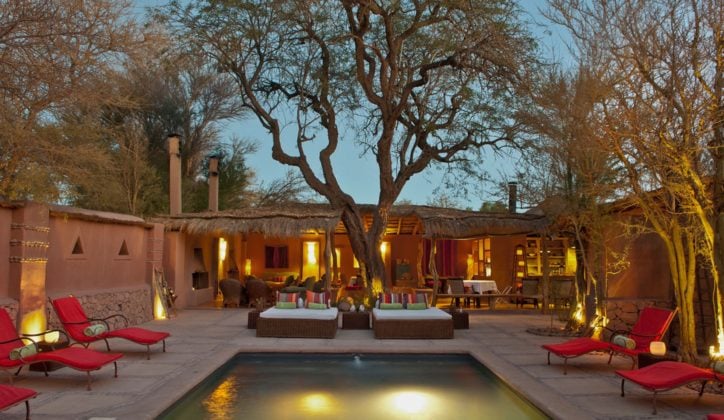
South America Travel Guides
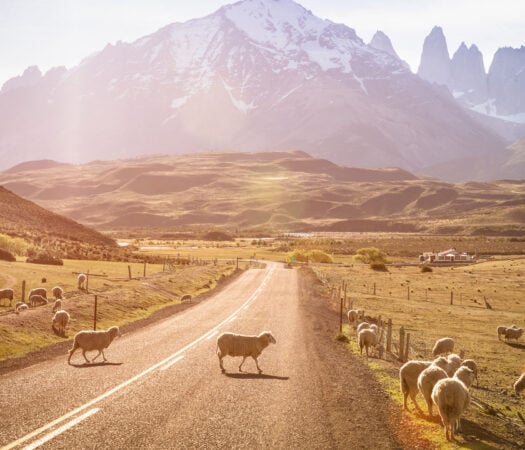
Argentina or Chile: Where Should I Go?
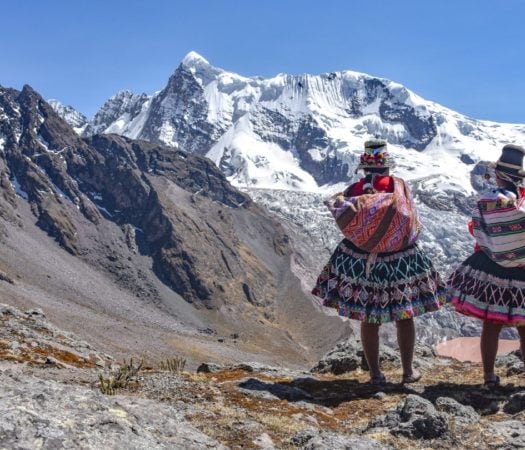
Best Things to do in Peru Besides Machu Picchu
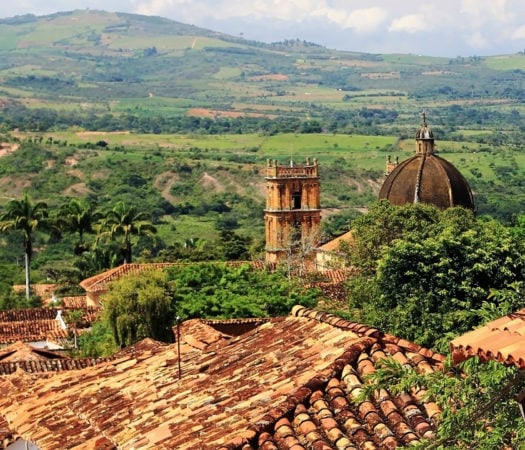
8 Reasons to Visit Colombia
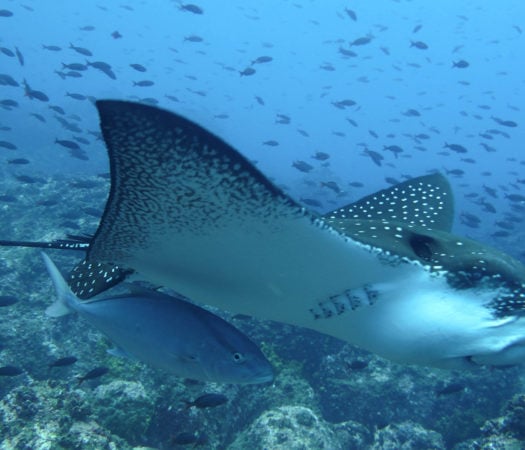
A Guide to the Galapagos Islands
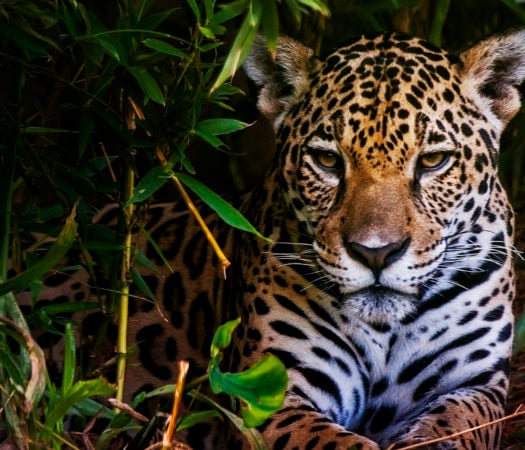
Brazil’s Big Five
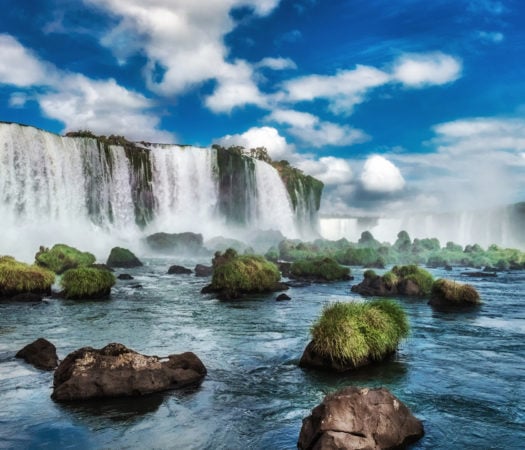
The 13 Best Things to Do in Argentina
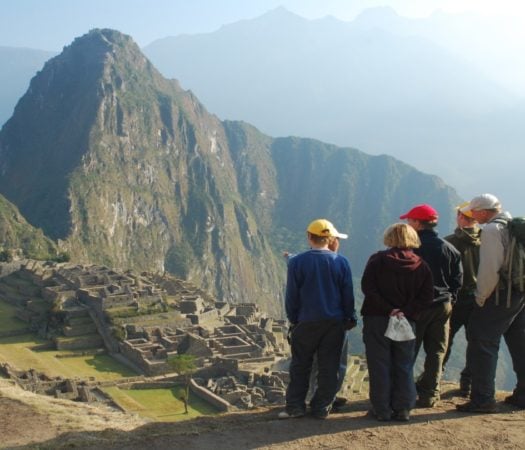
Our Guide to a Family Vacation in Peru
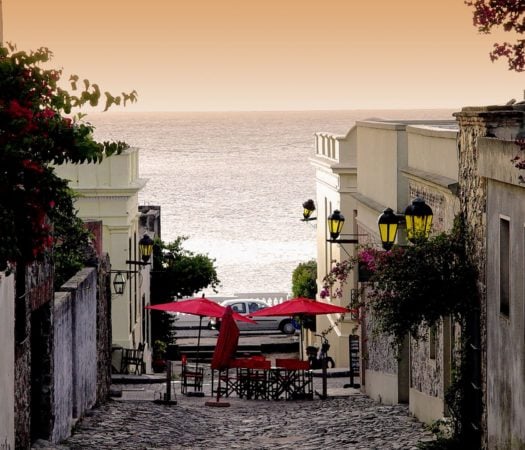
When is the Best Time to Visit Uruguay?
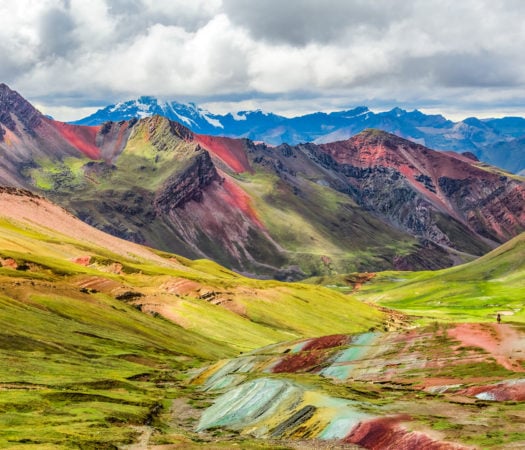
Best Treks in Peru: Cusco Walking Trails
Ready to plan your adventure? Whatever you want from your Latin American adventure, our team of expert travel designers are ready to help.

COMMENTS
December-March, June-September is the best time to visit Colombia. Colombia's 2 high seasons for tourism with great weather, little rain. Perfect conditions for beaches, hiking, touring the Amazon, and cities. December-March is usually the driest period of the year for Colombia, while June-September sees little rainfall and is the most ...
December to February is ideal for hiking Colombia's national parks. December to February is a fantastic time to travel through Colombia because it's dry everywhere except the Amazon. In the Andes, expect sunny skies and warmish days - perfect for hiking in the country's clutch of outstanding national parks, while the Caribbean coast is at ...
One of the things that set Colombia apart from other destinations in South America is its diversity of landscape and wildlife. From untouched Caribbean coastline to the emerald-green Andean summits, Colombia packs a vast array of flora and fauna spread across 314 different ecosystems and is ranked the second most biodiverse country in the world.. This mega biodiversity is thanks to the country ...
A clear explanation of the country's seasons to easily decide when it's the best month to visit Colombia—I've been living here since 2015. 🛑 Stop showing up when it's rainy season in Colombia. Start including sunny days and special moments (like whale season or Caño Cristales) during your vacation. Best months in Colombia: Short Answer Here are my thoughts on Colombia's seasons. Colombia ...
Visiting Colombia in Spring: March, April, and May. From December to March, Colombia experiences the driest weather, with less frequent rainfall, making it the best time of the year to visit. However, thanks to its geographic location on the Equator, Colombia experiences consistent warm temperatures throughout the year, making every season a ...
The best time to visit Colombia depends on which area you travel to. Weather variations are determined more by region than clearly defined seasons. The main differences of note are in the highlands, where nights become chilly at higher altitudes. Meanwhile, the lowlands enjoy a tropical climate year-round, with little temperature variation.
From tropical Amazon jungle to Caribbean beaches, the Andean Mountains and the world's largest bird population (almost 2,000), it's time you visited Colombia, the second-most biodiverse country on the planet after Brazil.Tucked into the northwest corner of South America, its warm and friendly people are more than ready for visitors after its 52-year civil war officially ended in 2016, meaning ...
When thinking about the best time to visit Colombia, it's worth bearing in mind that the most intense tourist seasons, with the highest prices, are from December to February and Semana Santa (Easter Week), the week before Easter. Tailor-made travel itineraries for Colombia, created by local experts. 7 days / from1284 USD. Unforgettable Colombia.
If you want to stay on the Pacific side, the best time to visit is between January and March, as the weather remains hot and humid in other parts of the year with frequent rainfall. The temperature remains moderately pleasant between 25°C and 28°C (77-83 Fahrenheit) in the early months of the year.
January. January is definitely one of the best months to visit Colombia. It's a bit windy on the Caribbean coast which makes for ideal beach days and it is honestly just one big party that lasts the entire month.
The best times to visit Colombia are the two dry season phases. The first is between December and March, and the second is between July and August. The temperatures are relatively lower and rainfall is minimal, which makes it ideal for exploring Colombia's cities, historic ruins and iconic coffee plantations.
The climate in Colombia stays pretty consistent throughout the year but December to March is considered the best time to visit for warm temperatures and sunny conditions. You can also visit Colombia between June and September as these months receive very little rainfall. However, these two periods are also the busiest, so expect to see large crowds at popular sites and increased accommodation ...
Colombia. South America. Soaring Andean summits, unspoiled Caribbean coast, enigmatic Amazon jungle and cryptic archaeological ruins. Colombia boasts all of South America's allure and more. Best Time to Visit.
Best Time of Year to Visit Colombia. Colombia has tropical weather and a stable equatorial climate throughout the year. High seasons for tourism are December-February and June-August, coinciding the driest weather—expect big crowds and a festive atmosphere. Head to the Amazon rainforest during the second half of the year, when easily ...
The best time to visit Colombia is from December to March, when rain is least likely across most of the country. Considered the high season, this is the perfect time to go to the coast or the Coffee Triangle and to experience local celebrations like Carnival in Barranquilla and Easter across Colombia.. Because Colombia is on the equator, temperatures are fairly consistent in each region ...
The Best Places To Visit in South America: By Month January . Peak of summer in Chile, Argentina, Brazil, Colombia, and Uruguay; Best time for the most famous Brazilian beaches (on the southern coast), at the peak with clear skies, hot weather, and perfect conditions to visit while outdoor concerts, markets, and fests are common; Best season for the coffee zones in Colombia - great, warm ...
Less popular time to visit: If there are any months to avoid then April - June and August - October see the most rainfall, but the country remains perfectly navigable and prices tend to be lower at these times. Best time for beaches: December - March is Colombia's high season, with warm, sunny days across the country.
Best time to Go Hiking in Colombia. January is a perfect time to go hiking in Colombia. The trails are dry and the skies are clear, which means you can enjoy the views from the loftiest peaks. Bogota is deserted during this time of year, and you can even find secluded eco-lodges along the Pacific coast.
The Best Time to Travel to South America: A Comprehensive Guide to Understand When to Visit Each Country. ... The Best Time of Year to Travel to Colombia. Colombia is a country that offers a wealth of experiences for travelers. From stunning beaches to lush rainforests, colorful cities to historical landmarks, there is something for everyone in ...
Best Time to Visit Colombia. Carribean Coastal Region of Colombia. Given Colombia's close proximity to the United States and Canada, many travelers from the Northern Hemisphere visit Colombia during December and January. This is to escape the winter and enjoy the warm weather of Colombia. Especially in Cartagena and the Caribbean Coast.
The best time to visit Colombia is September While Colombia is a popular destination to visit all year round, September is the ideal time to go due to a number of factors such as the climate, cost of travel and accommodation, as well as avoiding peak holiday periods.
Best Places to Visit in South America - September, October, November. Spring is from September to November, and it is a fantastic time to visit South America. In general, spring marks the beginning of warmer weather throughout the continent. For example, in Buenos Aires, Argentina (the Paris of South America), travelers experience sunny ...
These are 20 of the best places to visit in Colombia, from colorful villages to stunning beaches. ... 25 Best Places to Visit in South America, From the Wetlands of Brazil to Easter Island.
Related: 10 Best Places To Visit In Colombia. ... This means at any time of the year; one can experience all four seasons in Colombia. ... In Colombia, like many parts of South America, high ...
For many, the best time to visit South American destinations will be the warm summer months of December to March. These months offer the perfect weather conditions for hiking in Patagonia, snorkelling off the Galápagos Islands and sightseeing in Buenos Aires. For others, the clear and chilly winter months of June to September are best for ...